Adventurous Kate contains affiliate links. If you make a purchase through these links, I will earn a commission at no extra cost to you. Thanks!
Travel to Georgia
For the past few years, I’ve toasted the New Year with a glass of champagne and said, “This will be the year that I finally travel to Georgia.” For around a decade, Georgia has been at the absolute top of my travel wish list, and dreams of mountain peaks and khachapuri swirled in my head.
So what took me so long? I don’t know. I think I was waiting for the perfect opportunity. And this summer, while drinking wine at a bar in Trento, Italy, the perfect opportunity arose.
Lots of my friends were going to be in Georgia this summer, it turned out. And JayWay Travel wanted to run a blog trip to one of their newest destinations: Georgia. I knew I had to hop on to that!
Within weeks, a trip was planned — six of my blogger friends and I would explore Georgia as JayWay Travel guests.
I touched down in Tbilisi on my 35th birthday and spent the next two weeks exploring the country. We drank qvevri wine fermented on rooftops. We hiked through villages covered with ancient stone towers. We explored hidden architectural treasures behind unassuming doors. We stomped through a mud-drenched road.
Did Georgia live up to my expectations? It absolutely did. I consider Georgia my favorite new country of 2019, and of the 82 I’ve visited, I think Georgia definitely merits a spot in the top 10.
There are so many reasons. Tbilisi is such a unique city — I can see why so many people love it. And Svaneti brought epic scenery. I loved the churches and monasteries and natural wonders.
But there is one factor where Georgia absolutely outdid itself, and it’s the food. Georgian food is EXCEPTIONALLY good, and inventive, and different from what you’ve had elsewhere. Georgian food is so good that I felt like every night, I was having one of the best meals of my life. I can’t believe it’s not more famous in the States.
Let’s dive into what makes Georgia great.
Table of Contents
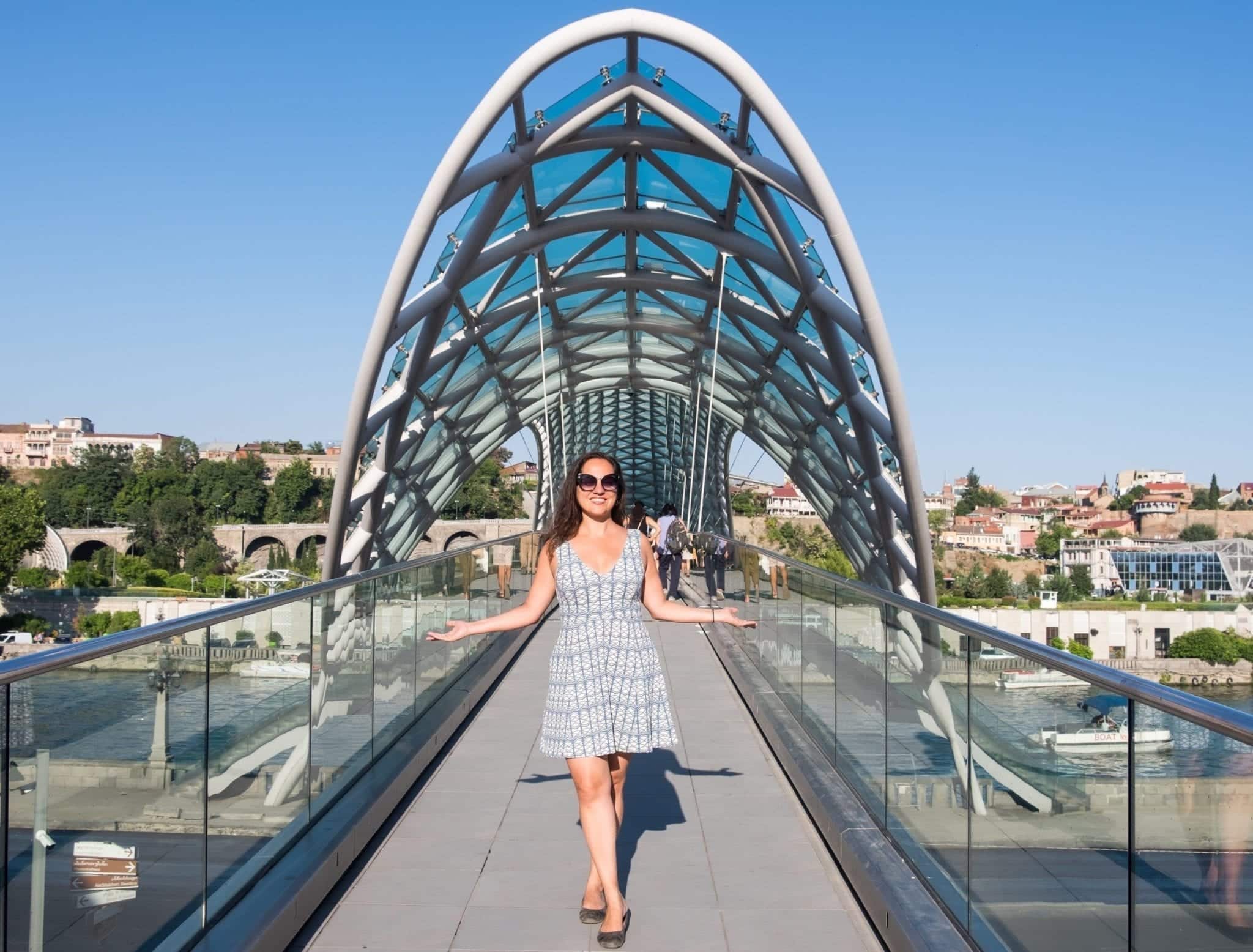
Tbilisi
Tbilisi is one of the coolest capital cities I’ve discovered in recent years. Its beauty hits you in different ways — in its setting on the Vere River, cliffs rising up on either side. Tbilisi is a beguiling mix of centuries-old monasteries and modern architectural marvels, like the Peace Bridge, pictured above.
Tbilisi is so unique that I’m having trouble comparing it to any other city. If we’re talking about looks, perhaps Istanbul comes the closest, if you swapped out the mosques for churches.
Some of Tbilisi’s tree-lined streets remind me of the Vinohrady neighborhood in Prague or the Palermo Viejo neighborhood in Buenos Aires. And the orange roofs bring the Balkans to mind — maybe a bit of Albania mixed with Croatia. I feel echoes of Medellín in the wavy hills of the city.
But how does Tbilisi feel? It’s a huge, sprawling city rife with endless possibilities. It’s filled with outstanding food for perplexingly cheap prices. It’s got nightlife into the early hours and people out on the streets. It’s got luxurious surprises tucked into unexpected places. And it’s a lot of fun — but could easily be a little too much fun. In that sense, Tbilisi is Bangkok!
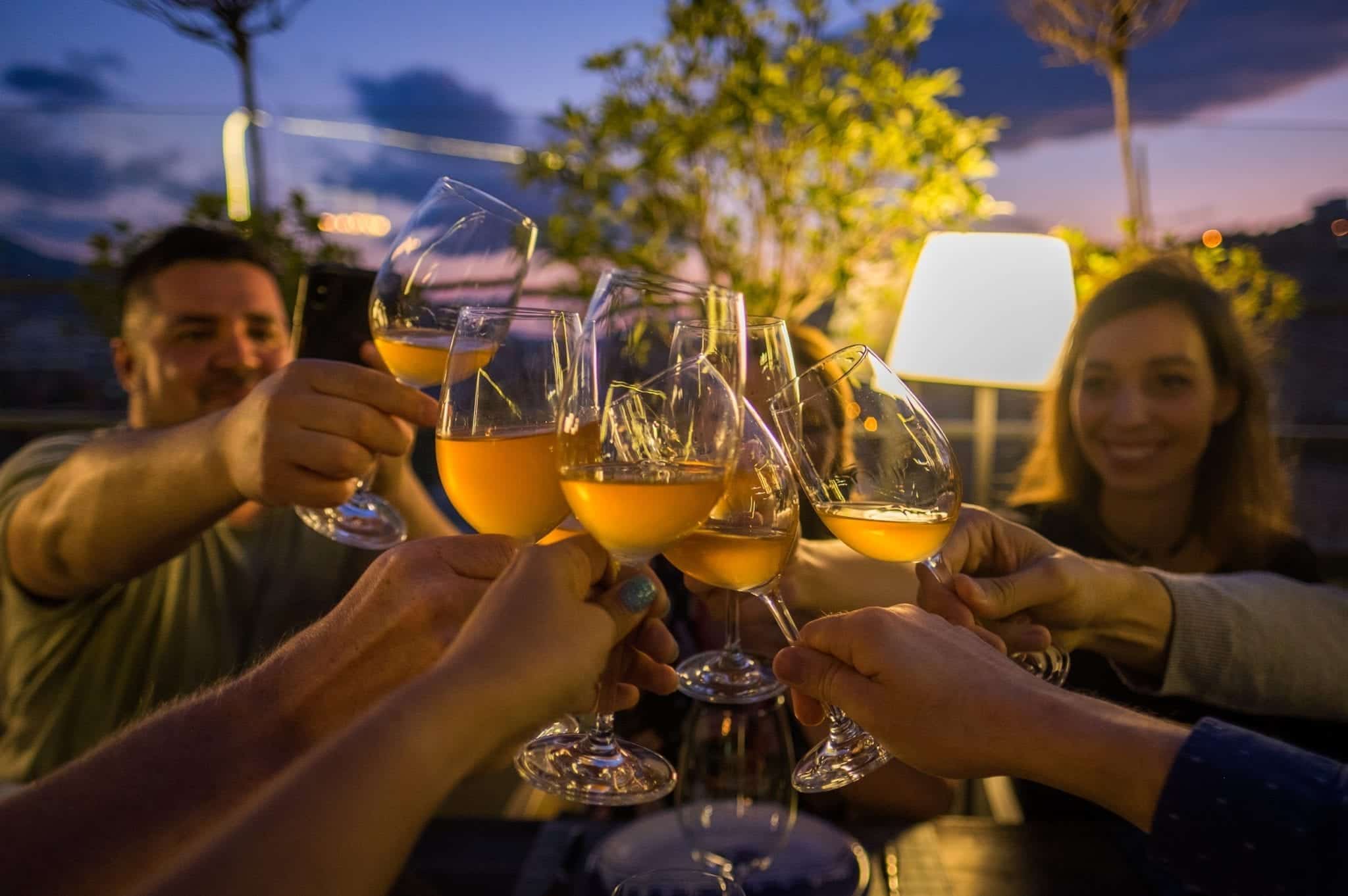
Tbilisi is toasting local orange wine on the rooftop of a restaurant against a blue-purple sunset.
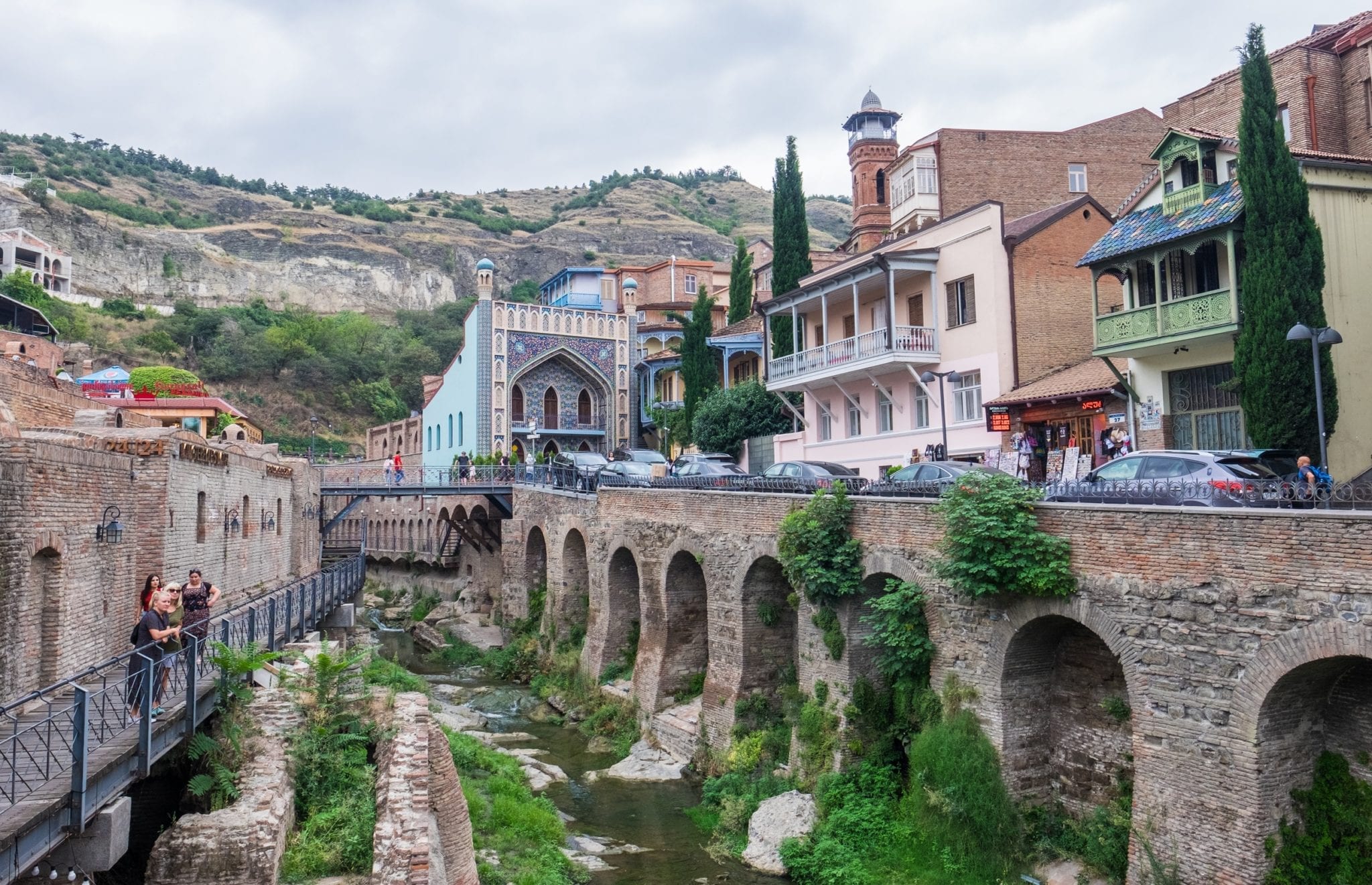
Tbilisi is the Baths District, where you can walk on ancient bridges and stroll past waterfalls before going for a soak in buildings that look straight out of Uzbekistan.
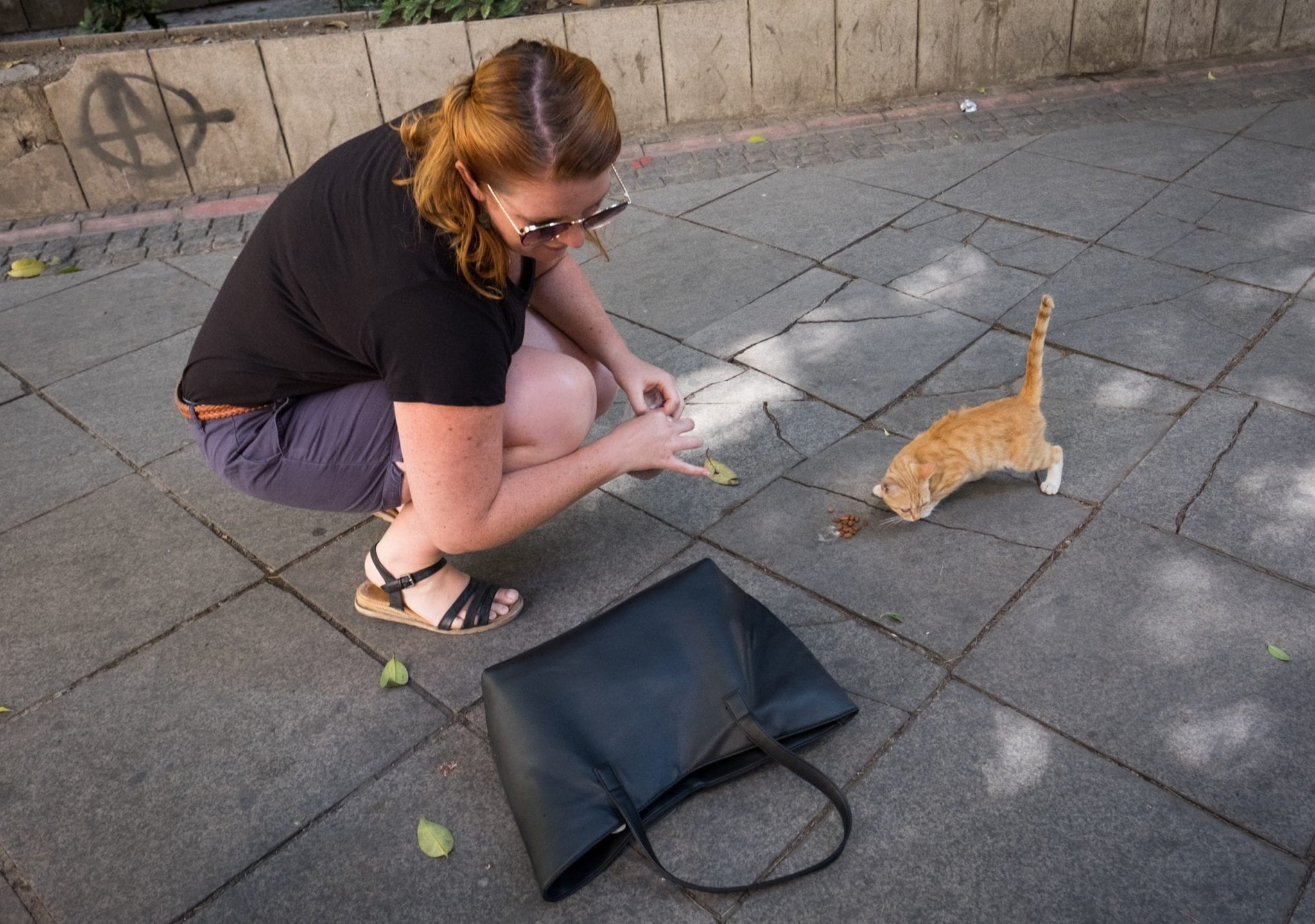
Tbilisi is full of cats. Like in Istanbul, people take care of the strays. Meg from Food Fun Travel actually carries cat food in her purse to feed the Tbilisi kitties!
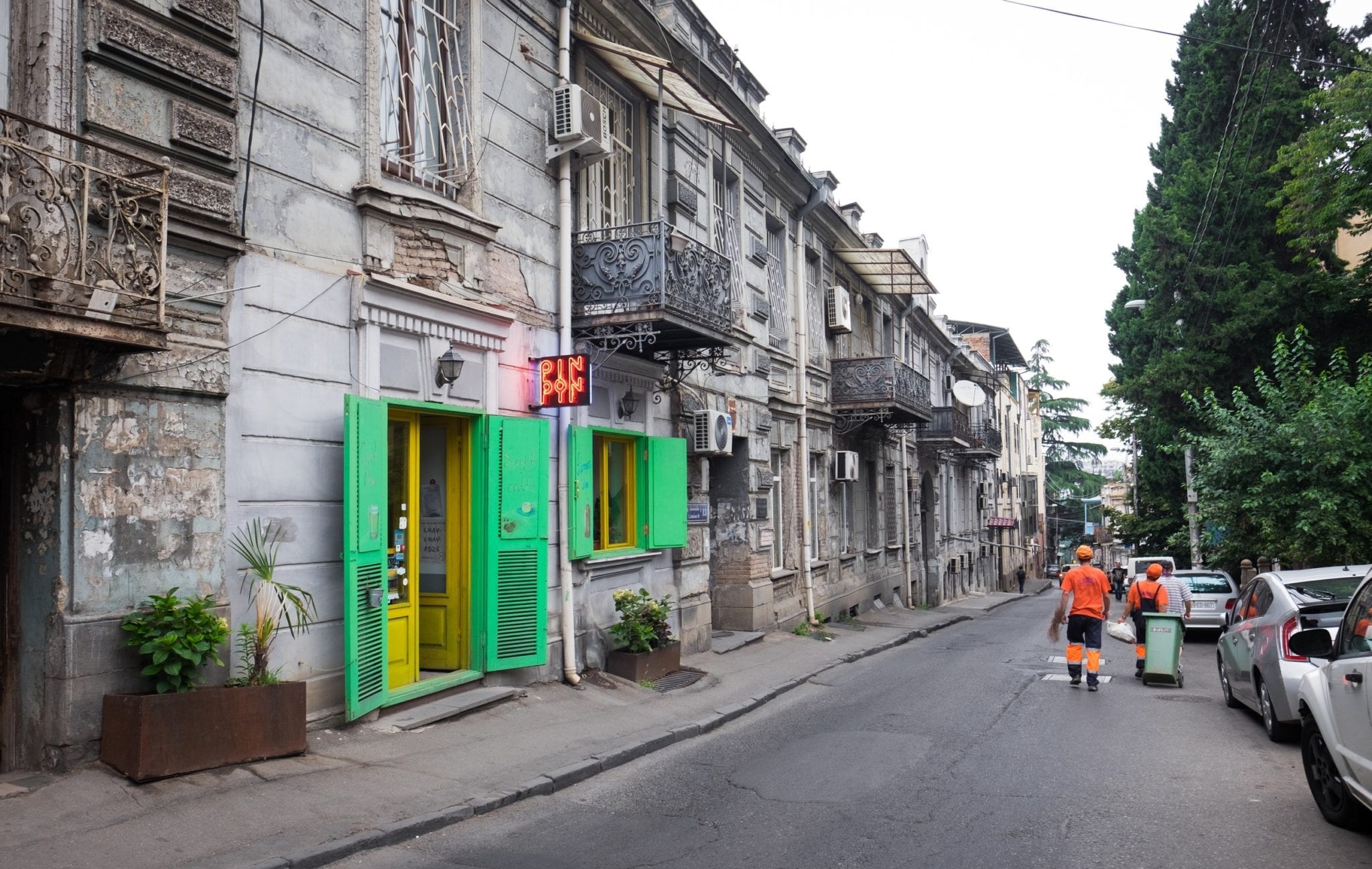
Tbilisi is long blocks of crumbling gray buildings interspersed with bursts of color — like Pin Pon, a neon yellow and green coffeeshop.
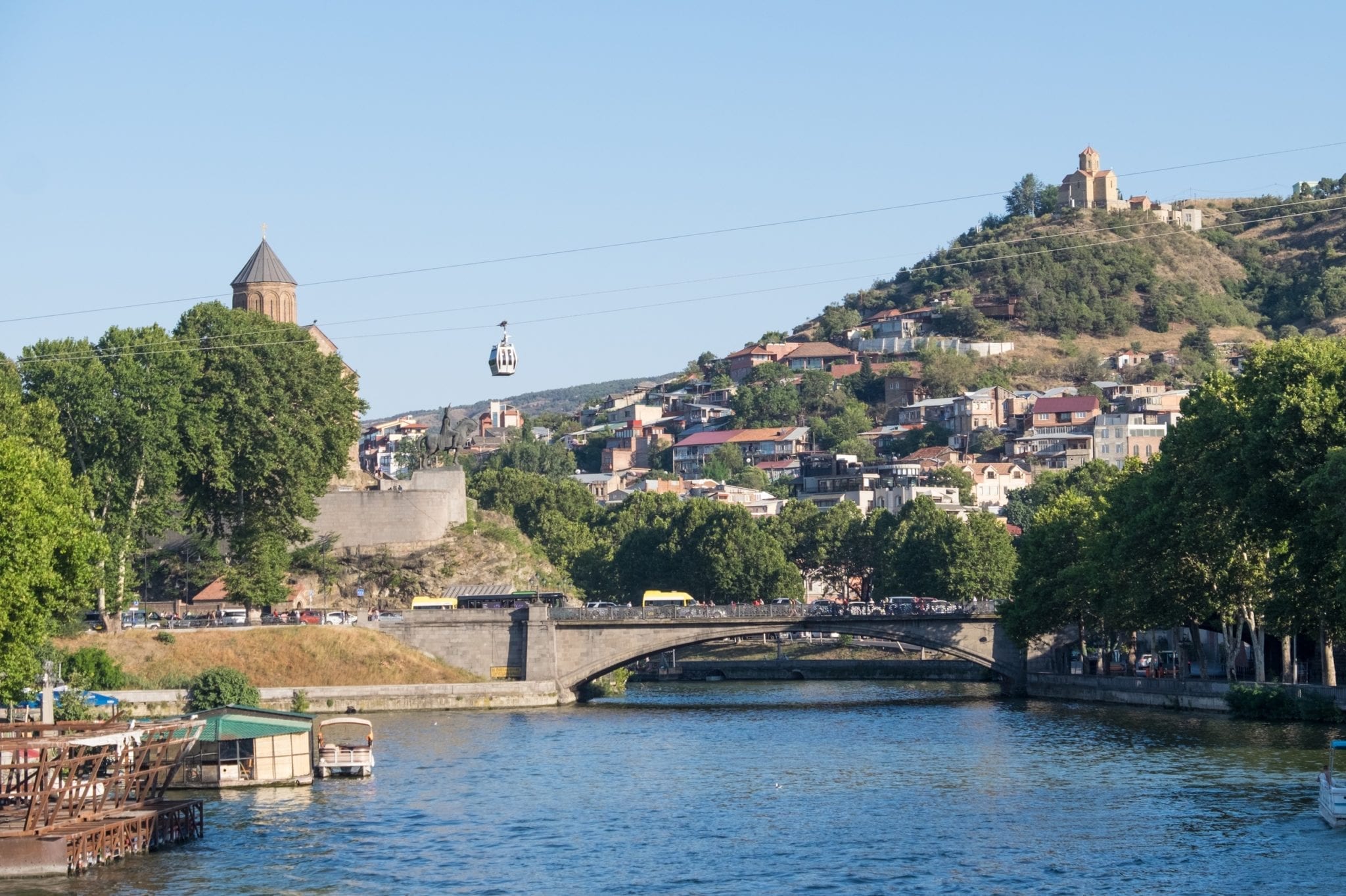
Tbilisi is a colorful riverfront, where cable cars zoom to the other side and monasteries watch from above.
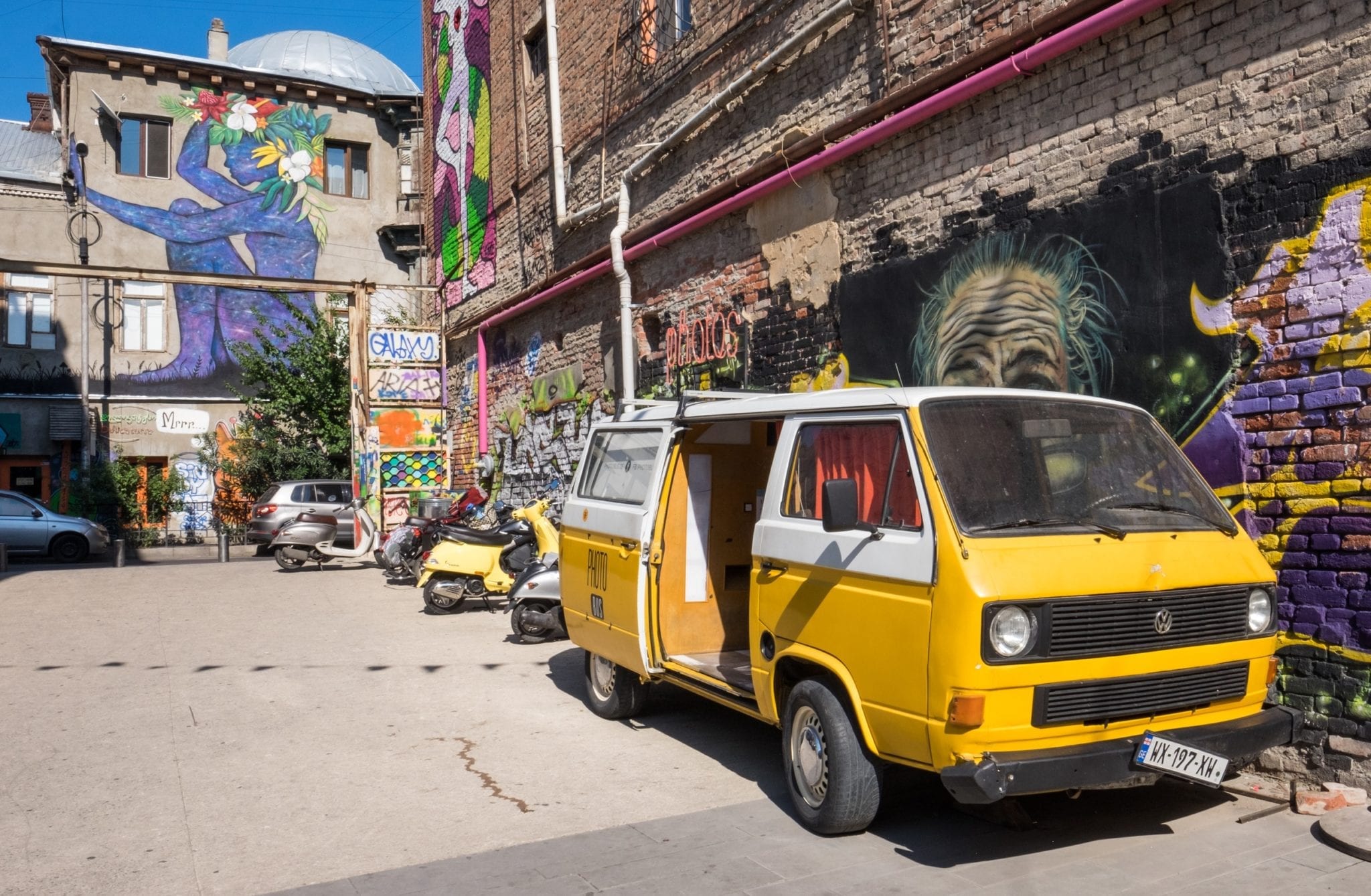
Tbilisi is bright yellow vans parked against mural-covered walls.
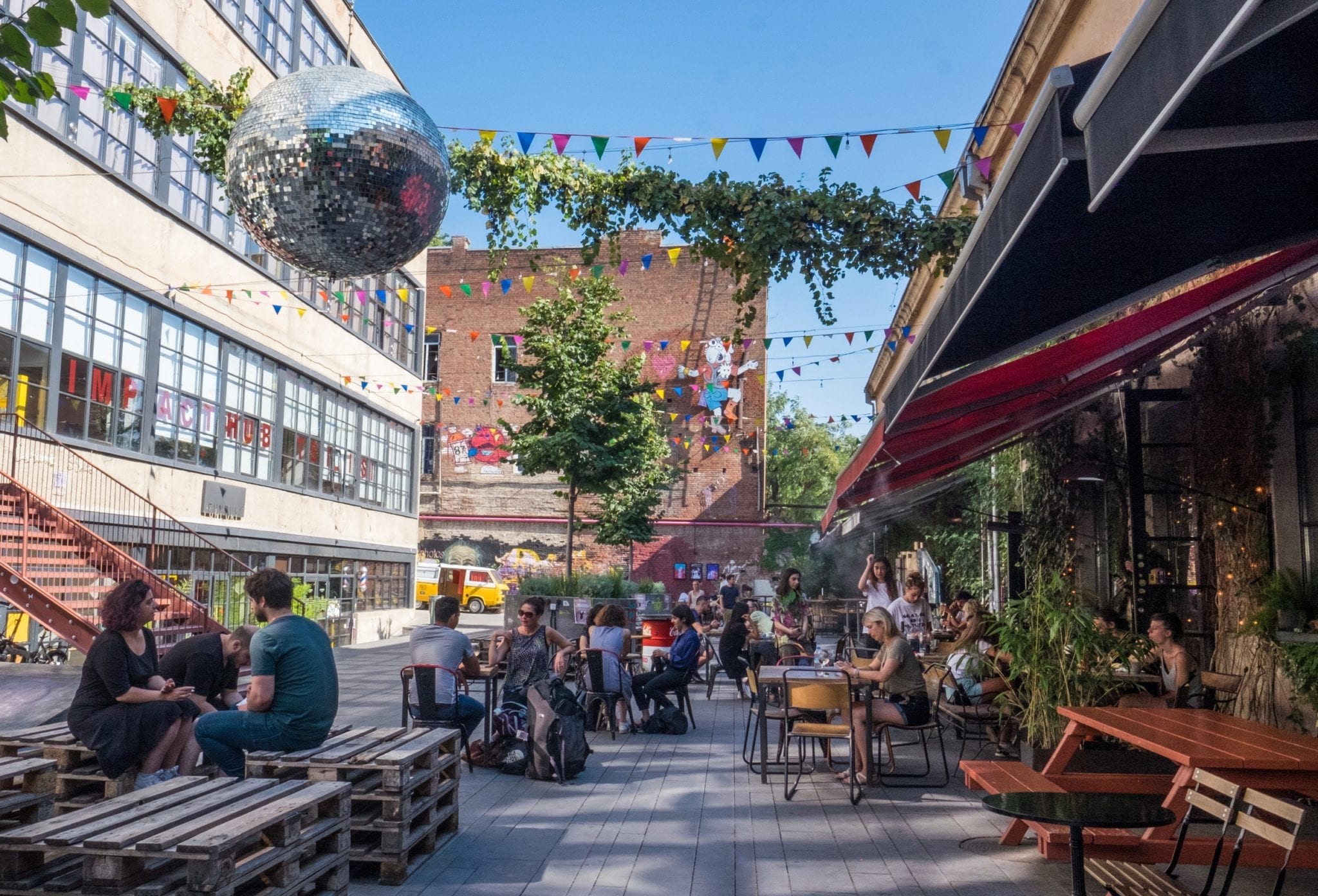
And Tbilisi is on its way to becoming the new Digital Nomad Land. Yes, the work-online-and-travel set has discovered Tbilisi!
A lot of my location independent friends have made Tbilisi their home, both temporarily and long-term. And for good reason — Tbilisi is cheap, fun, and has a thriving expat community.
Fabrika is the center of this community — it considers itself an “urban hotspot and multifunctional place” and it’s part coworking space, part lounge, part hostel, part artist studio. I’m fairly sure that if I lived in Tbilisi, I’d work here all the time. Some of my friends chose their Tbilisi apartments based on proximity to Fabrika!

But if you’re not living in Tbilisi long-term, it’s also a great place to stay for a few days. And I stayed at the best place.
JayWay booked a special hotel for my birthday — the Communal Sololaki. This is my favorite hotel where I stayed in 2019, and I recommend it SO SO SO highly. If you’re willing to spend the money, you will be thrilled with it.
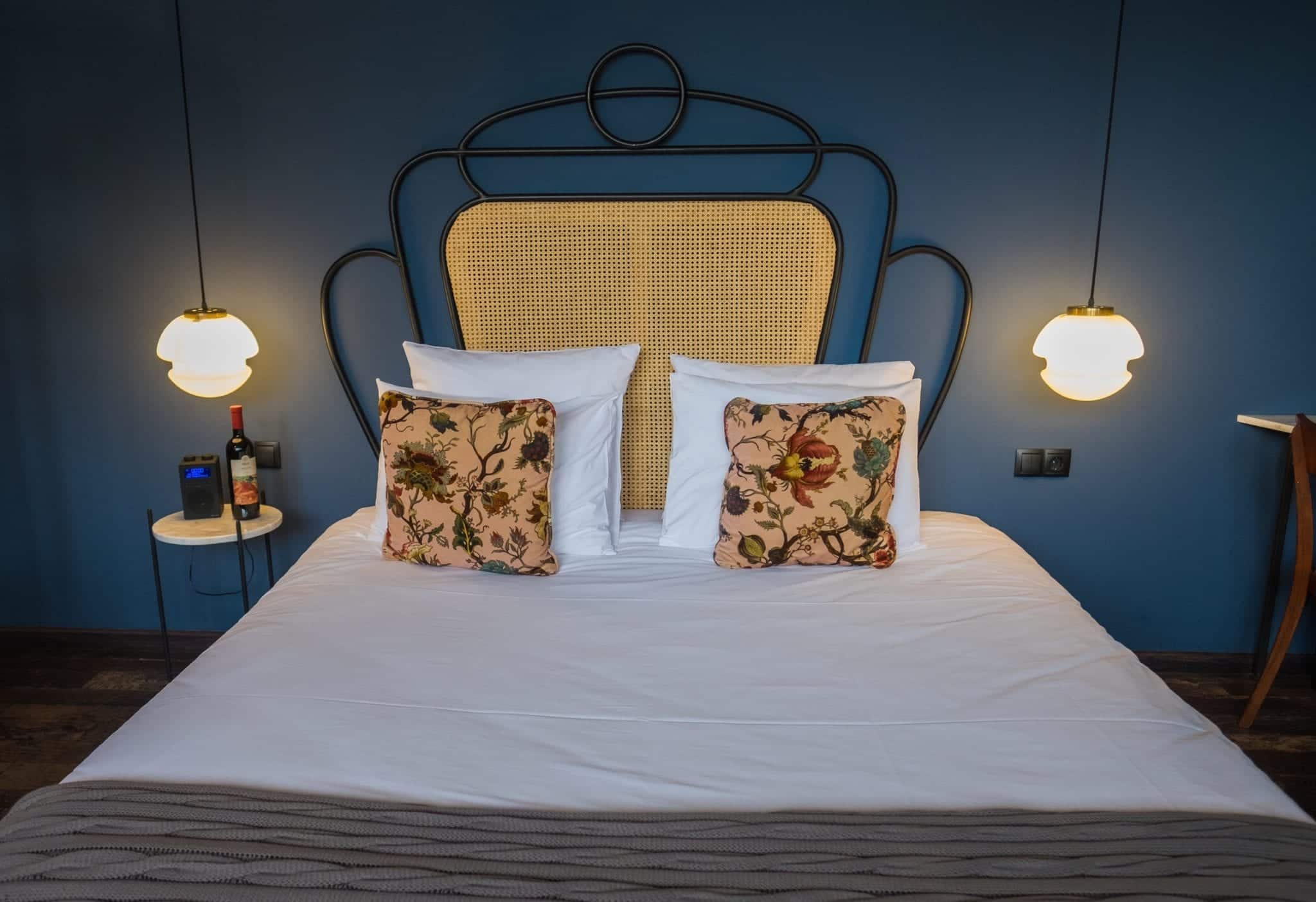
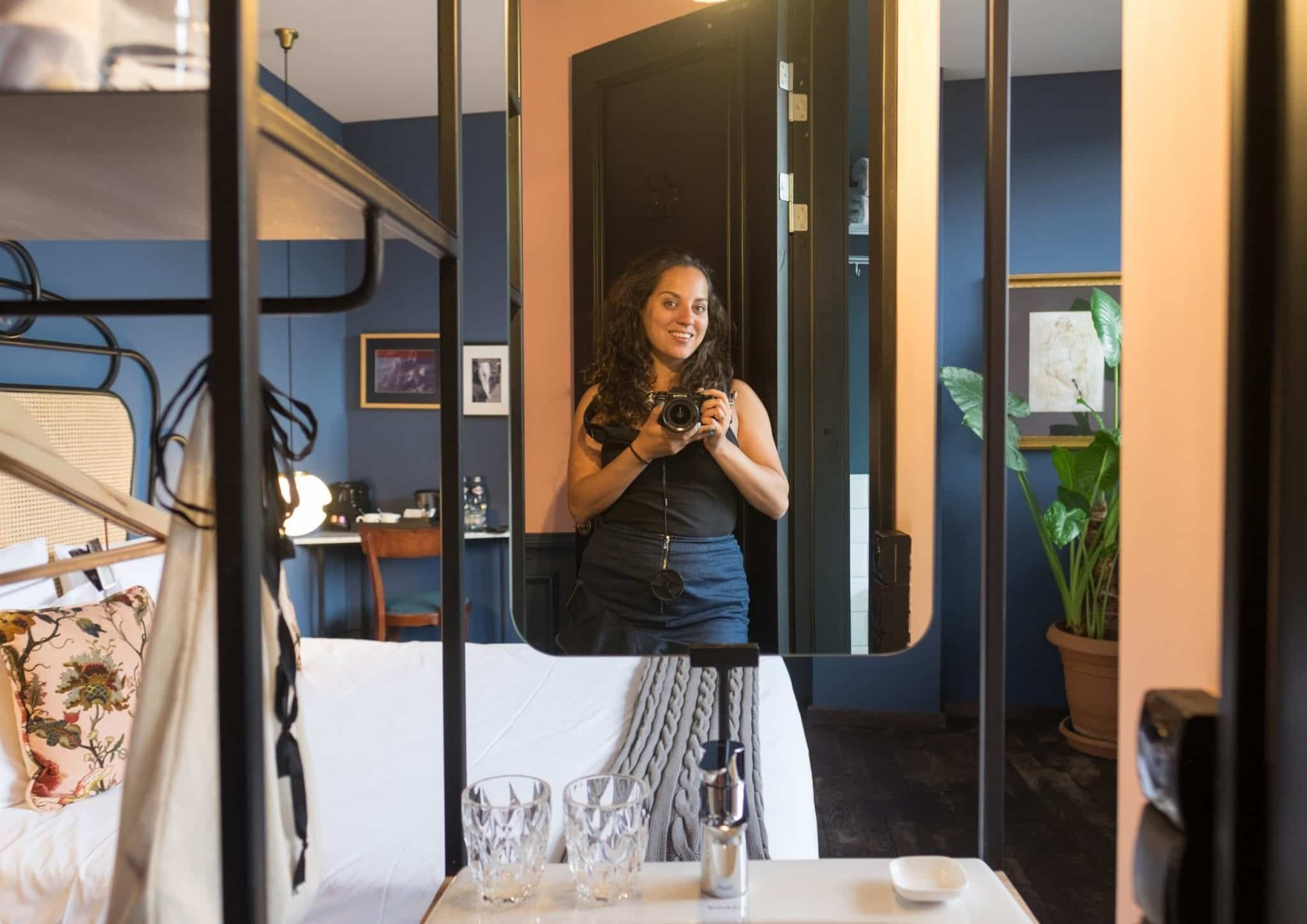

The Communal Hotel is decorated in a mid-century-modern meets bohemian style, and I love how they don’t shy away from bold, dark colors. I stayed in the bathtub suite, lined with mirror tiles. That’s where my infamous birthday bathtub photo was taken!
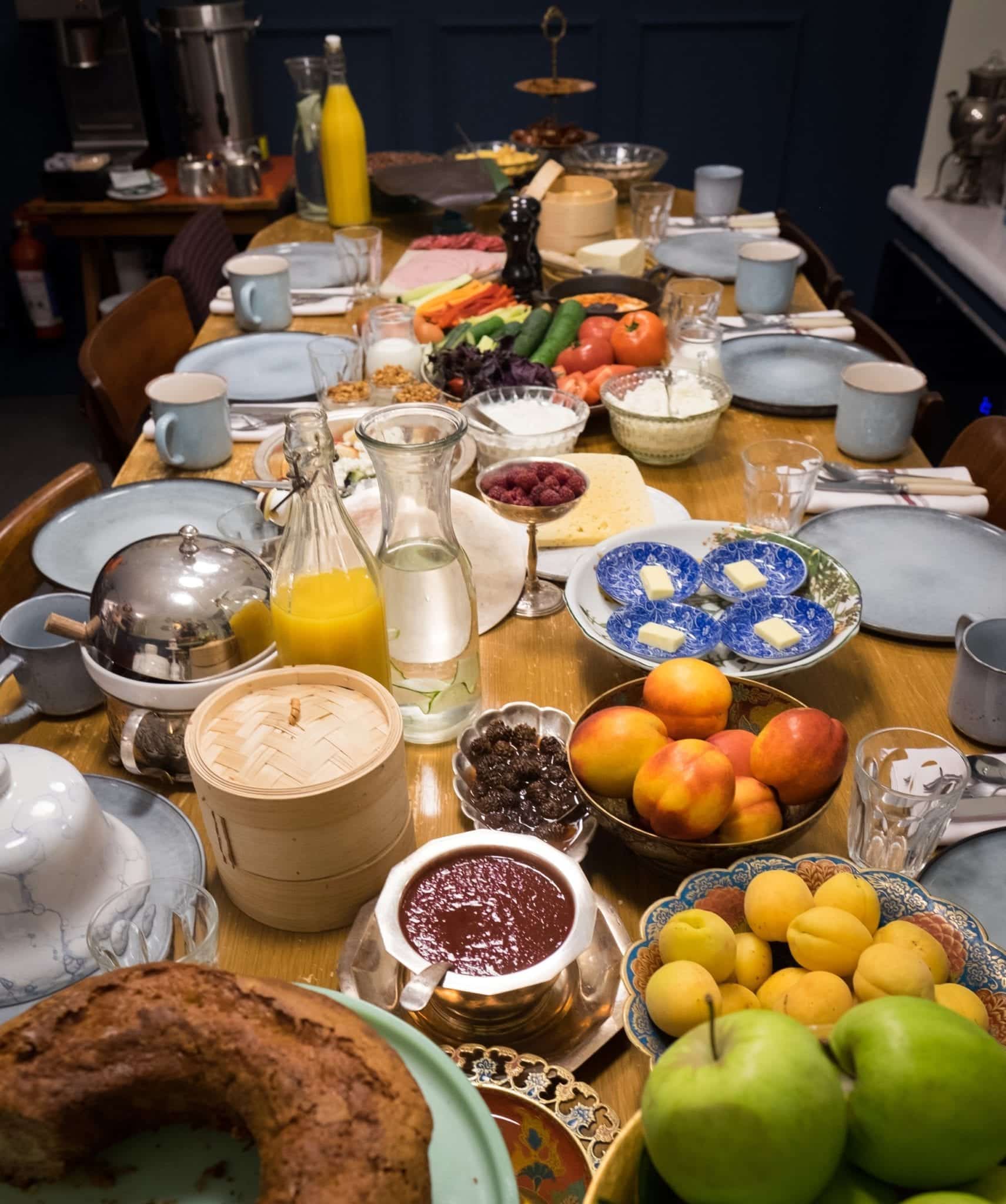
Communal Sololaki also has one of the best hotel breakfasts I’ve ever had — perhaps even the best. Breads and cakes and all kinds of fruits, dishes full of berries, juices and vegetables and several kinds of cheeses. Everything served on a collection of mixed dishes, some ornately patterned, some vintage, that went together so well. And on top of that, they’d make you eggs if you wanted.
The hotel has a communal focus, so the guests share a table together. You’ll enjoy chatting with the guests — people who travel to Georgia tend to be interesting and well-traveled.
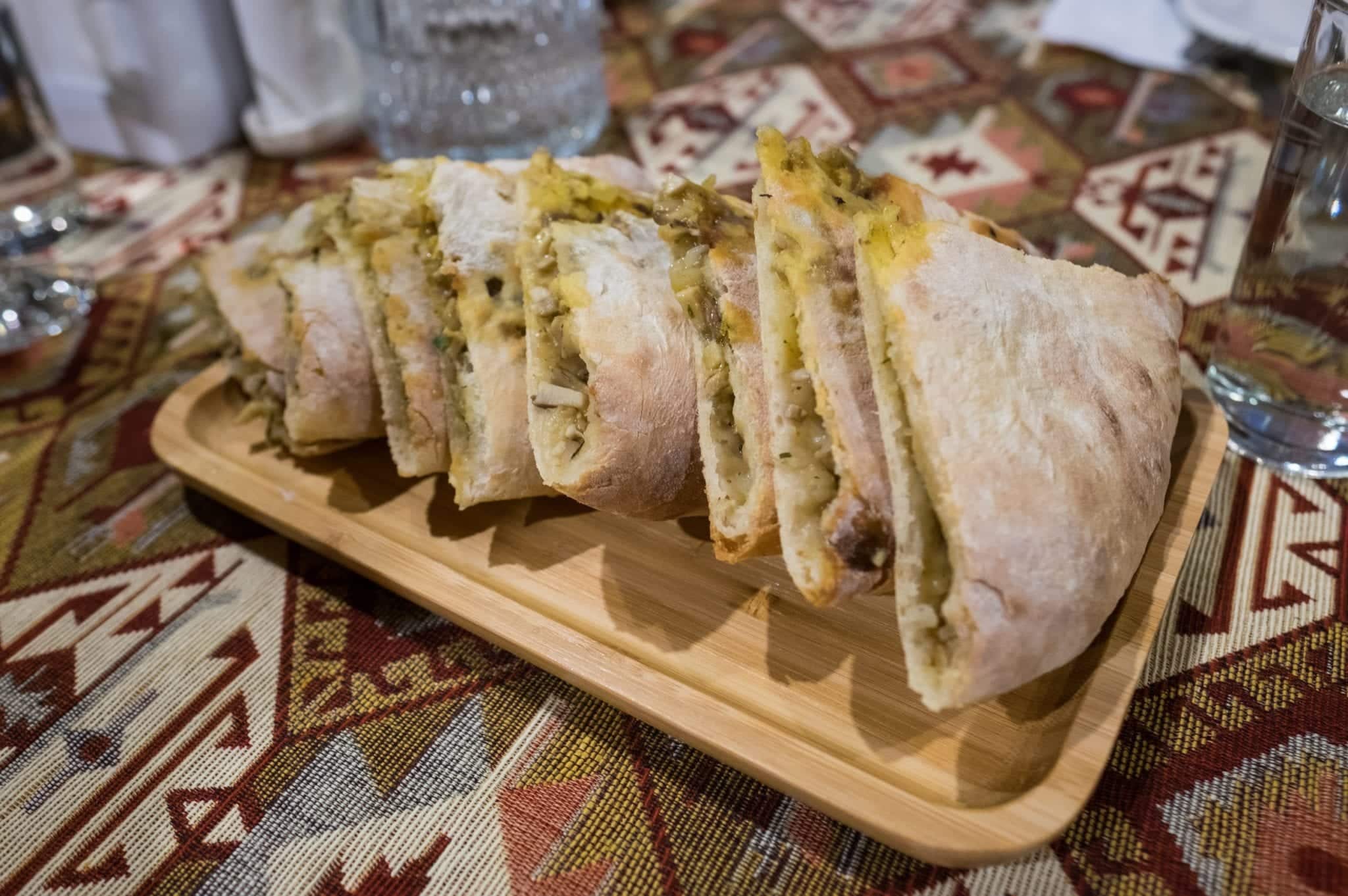
Georgian Food
But for me — and for most people — the absolute highlight of Georgia is the food. Georgian cuisine is perhaps the single best thing about traveling in Georgia.
Of course, the food is one of the highlights of every travel destination — but Georgia goes further. The quality is consistently excellent, the food is unique, and the dishes are something that you’ll crave long after leaving Georgia. Over and over, I felt like I was eating one of the best meals of my life in Georgia.
So what will you be eating?
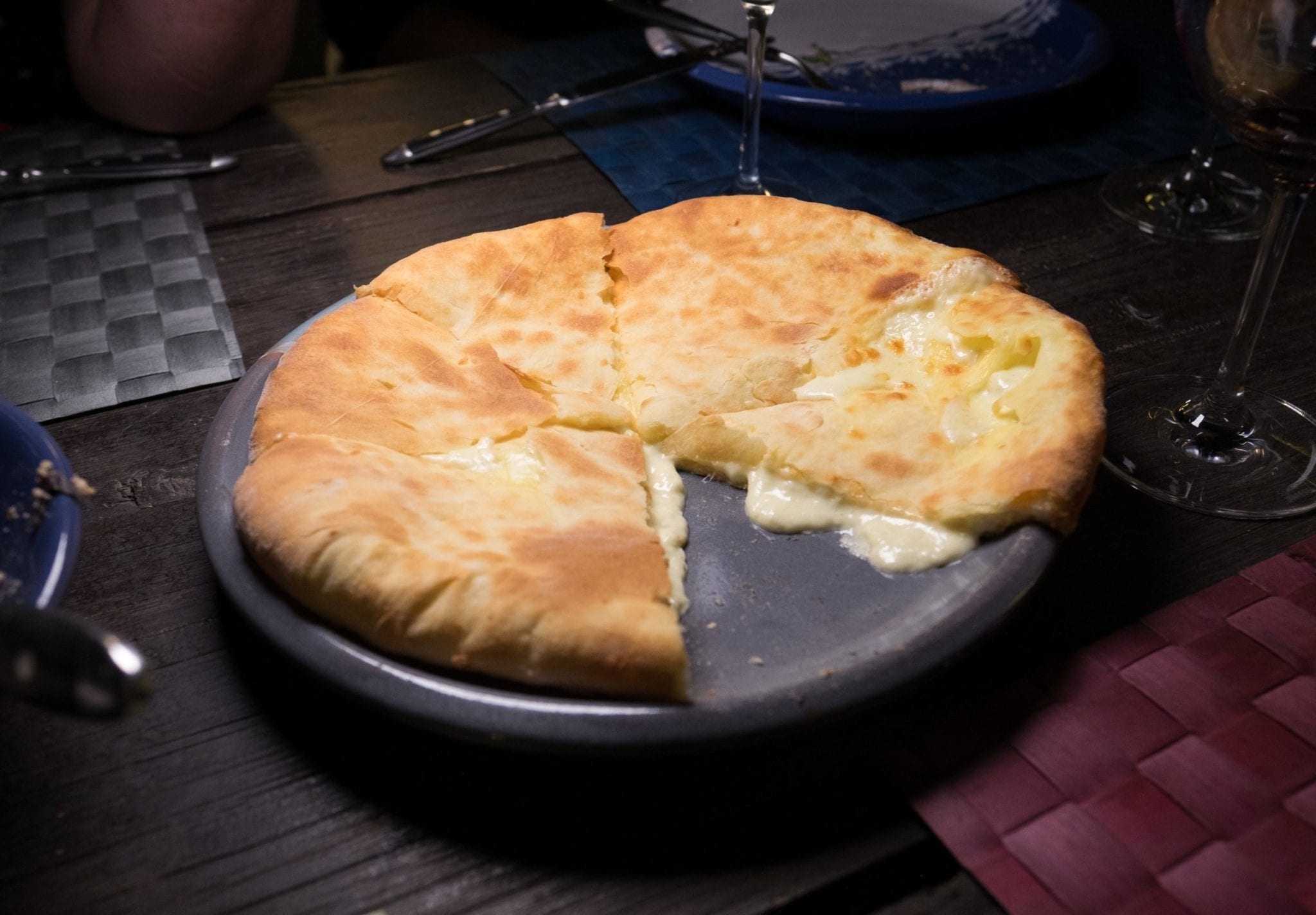
If you’ve heard of any one Georgian food, it’s probably khachapuri — Georgian cheese pie. Typical khachapuri are flat, closed, and stuffed with sulguni cheese.
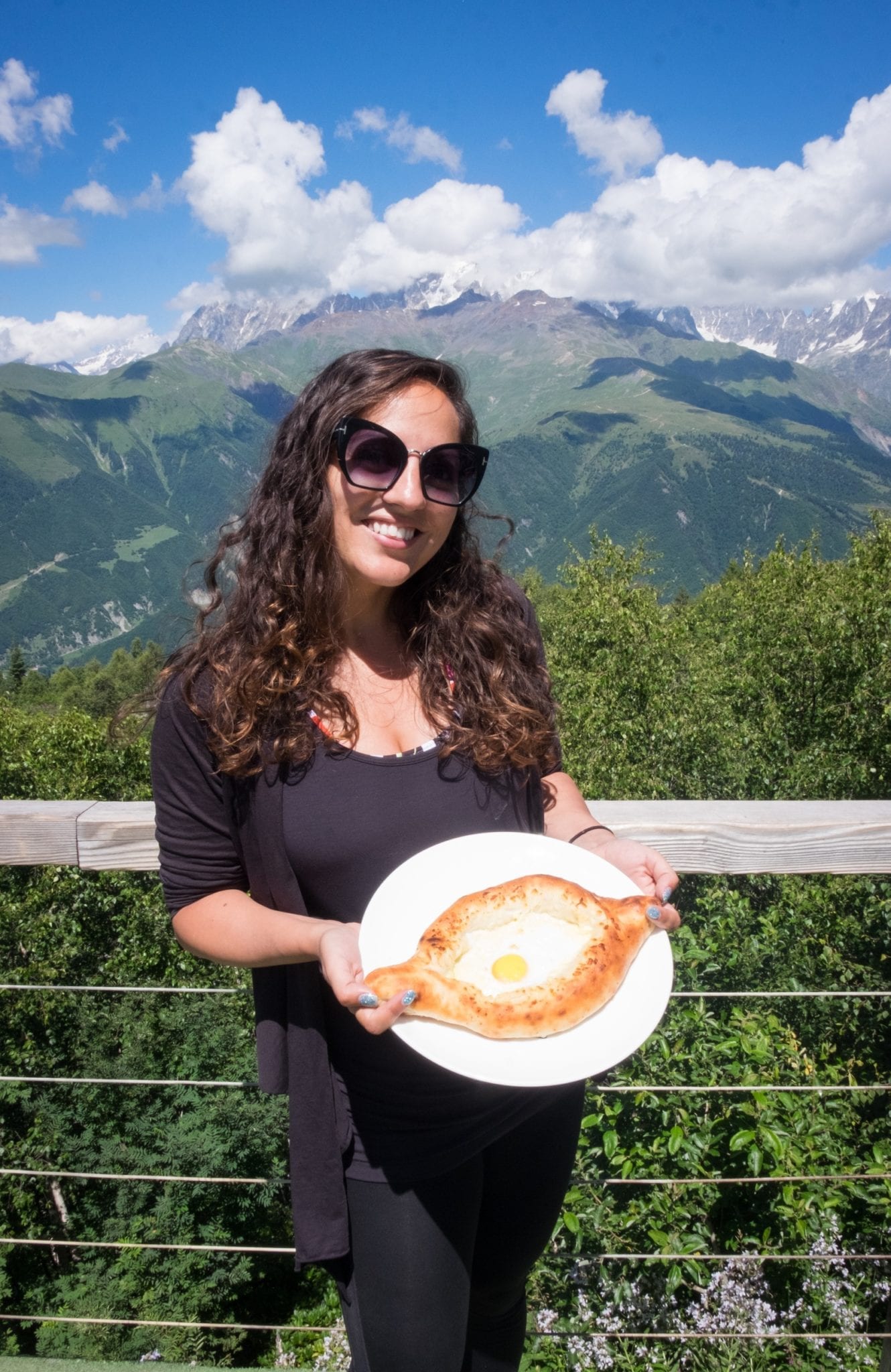
I was under the impression that khachapuri all looked like the one that I’m holding in the photo above — boat-shaped, with an open top, with an egg yolk and pat of butter. Not the case! That’s actually an adjaruli khachapuri, a popular variety originating in southwest Georgia. You tear off the ends and use them to mix up the egg, butter, and cheese, then you keep tearing off the bread and dipping it in the middle.
Just know that if you order a khachapuri, it will look like the closed, flat one above. If you want the fun-shaped one, make sure it’s an adjaruli khachapuri.
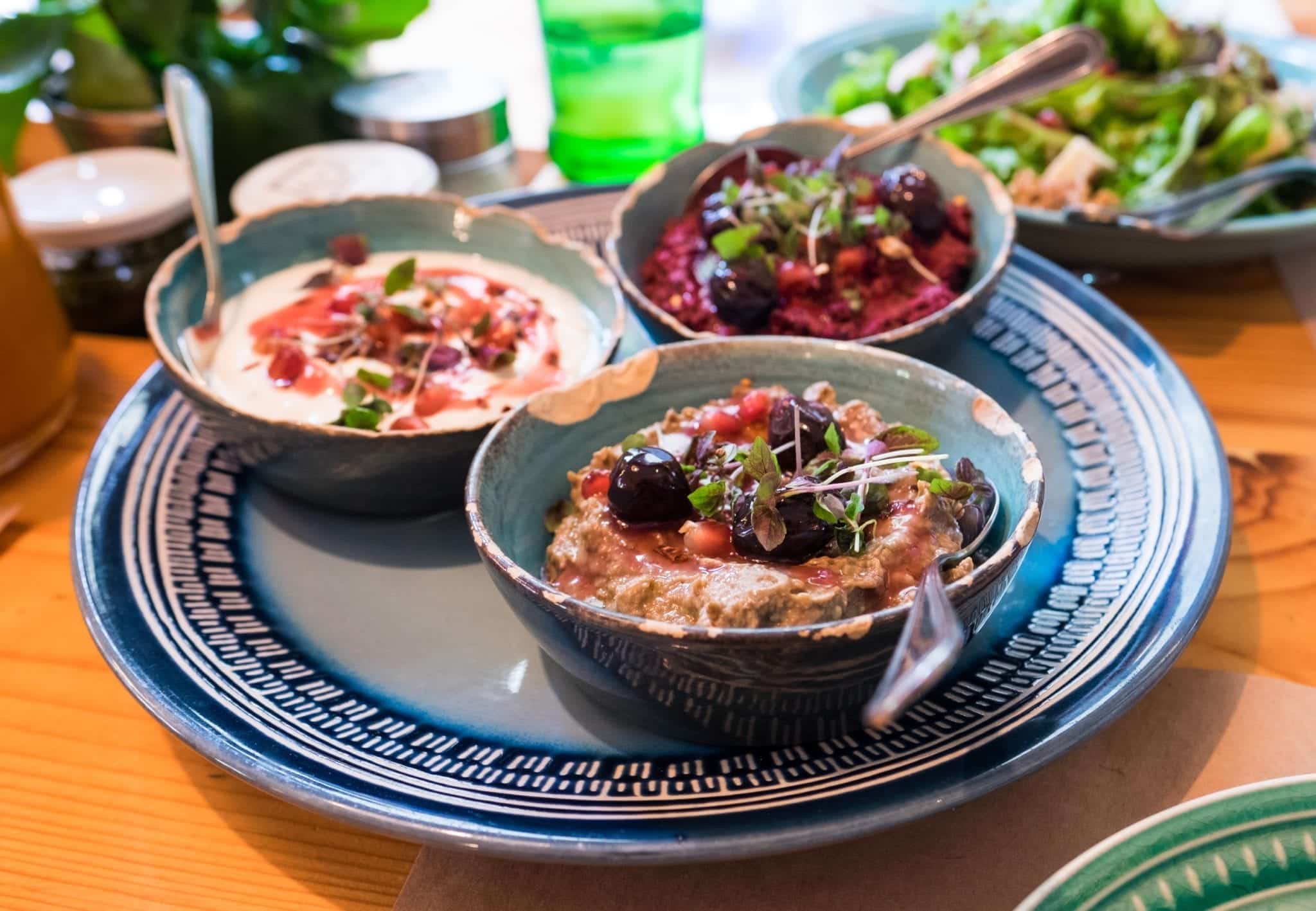
Most meals in Georgia start with a variety of dips, usually walnut-based, and we would eat them with bread. Beets and pomegranate seeds add bursts of color.
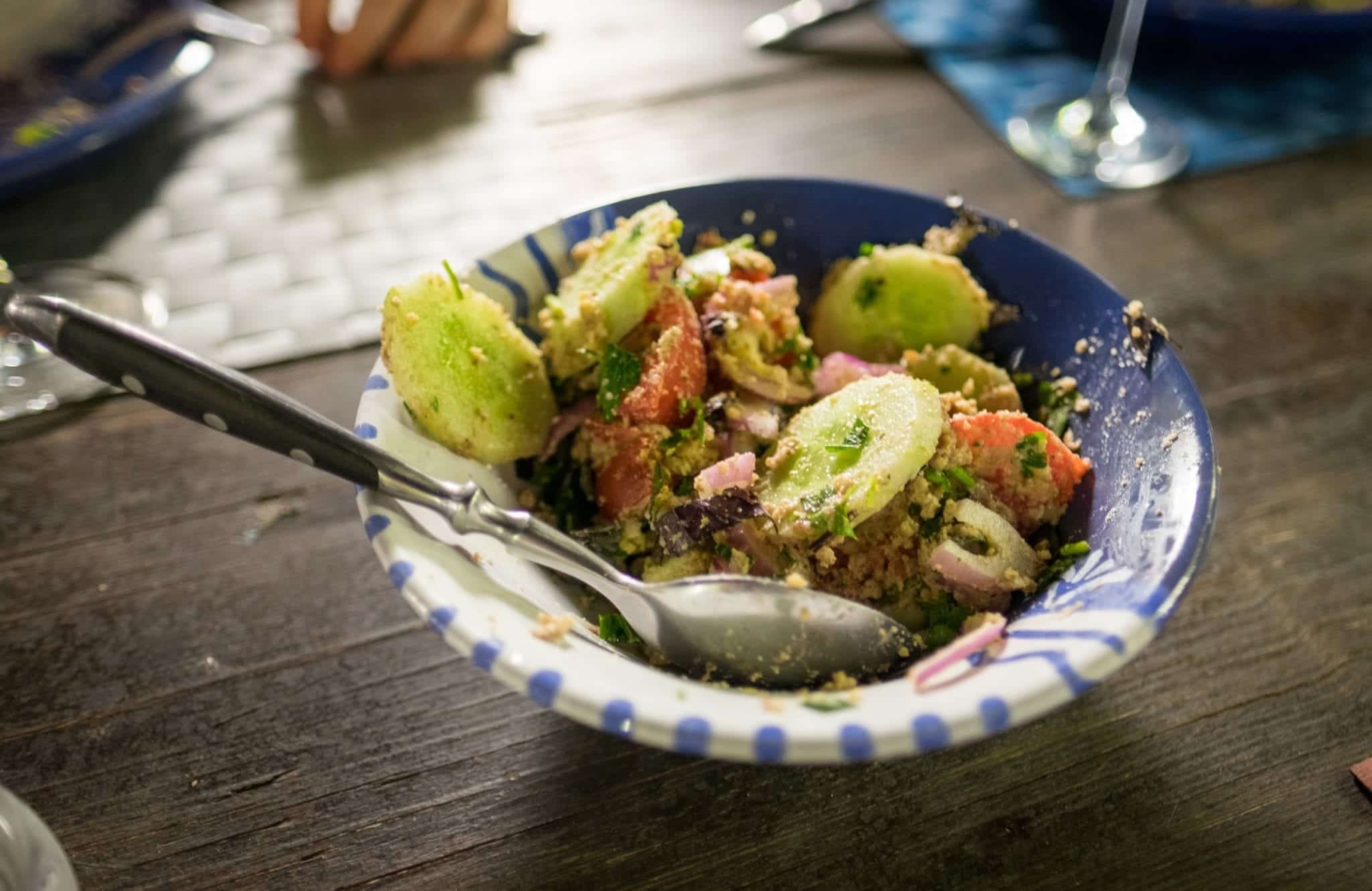
And now, meet the love of my life — Georgian walnut salad. It’s made from cucumbers, tomatoes, a few red onions, and held together with a walnut paste made with herbs. I was OBSESSED with this salad. How can something so simple be so outrageously delicious?!
The absolute best walnut salad I had was from Bina 37 in Tbilisi. It may have been the best thing I ate in Georgia.
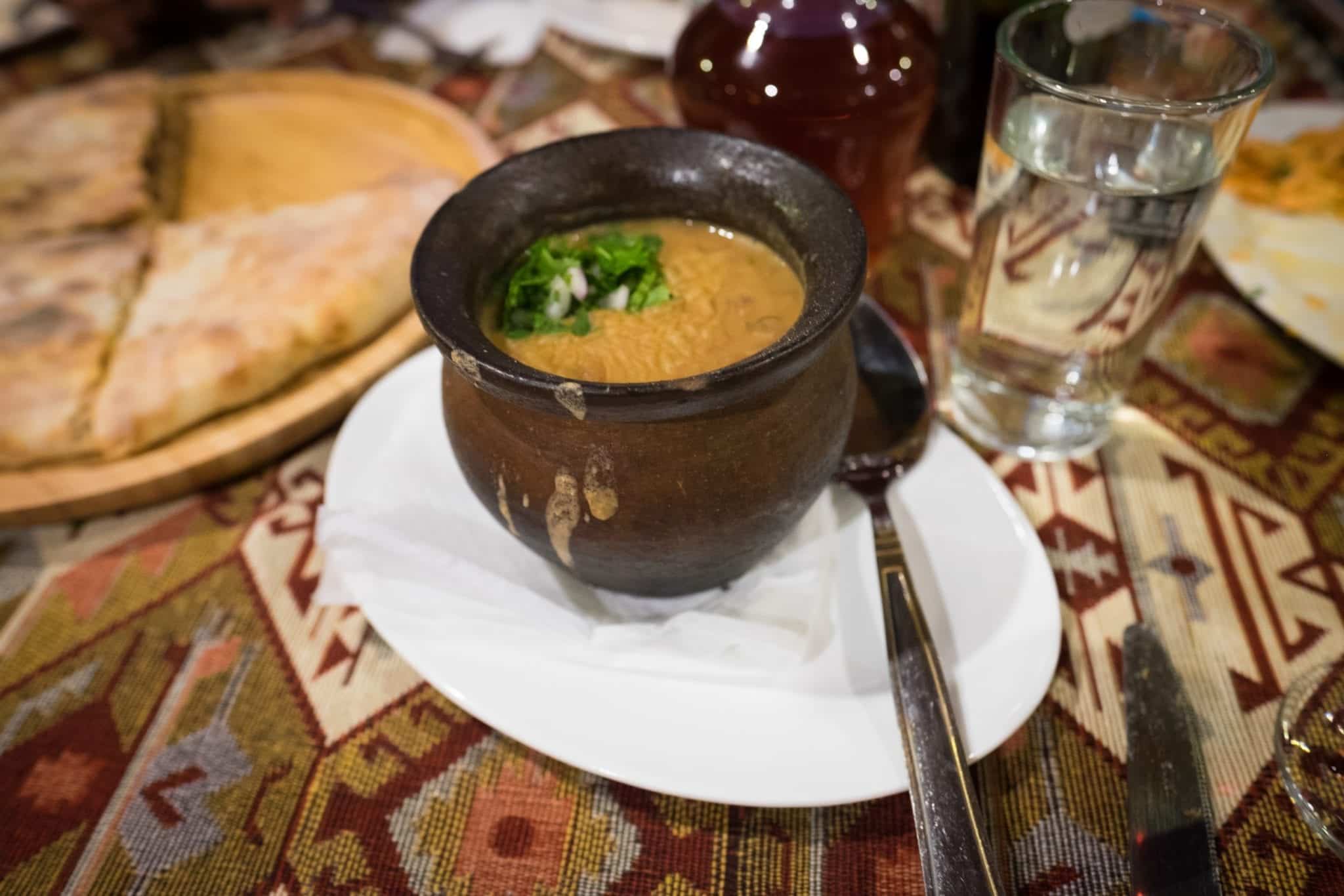
Lobio was also a standard at every meal — Georgian stewed beans. That’s not the greatest photo above, but these beans were SO delicious and fresh, always served in a vase-like container. I’m not a big fan of beans, but I served myself a generous portion of lobio whenever possible.
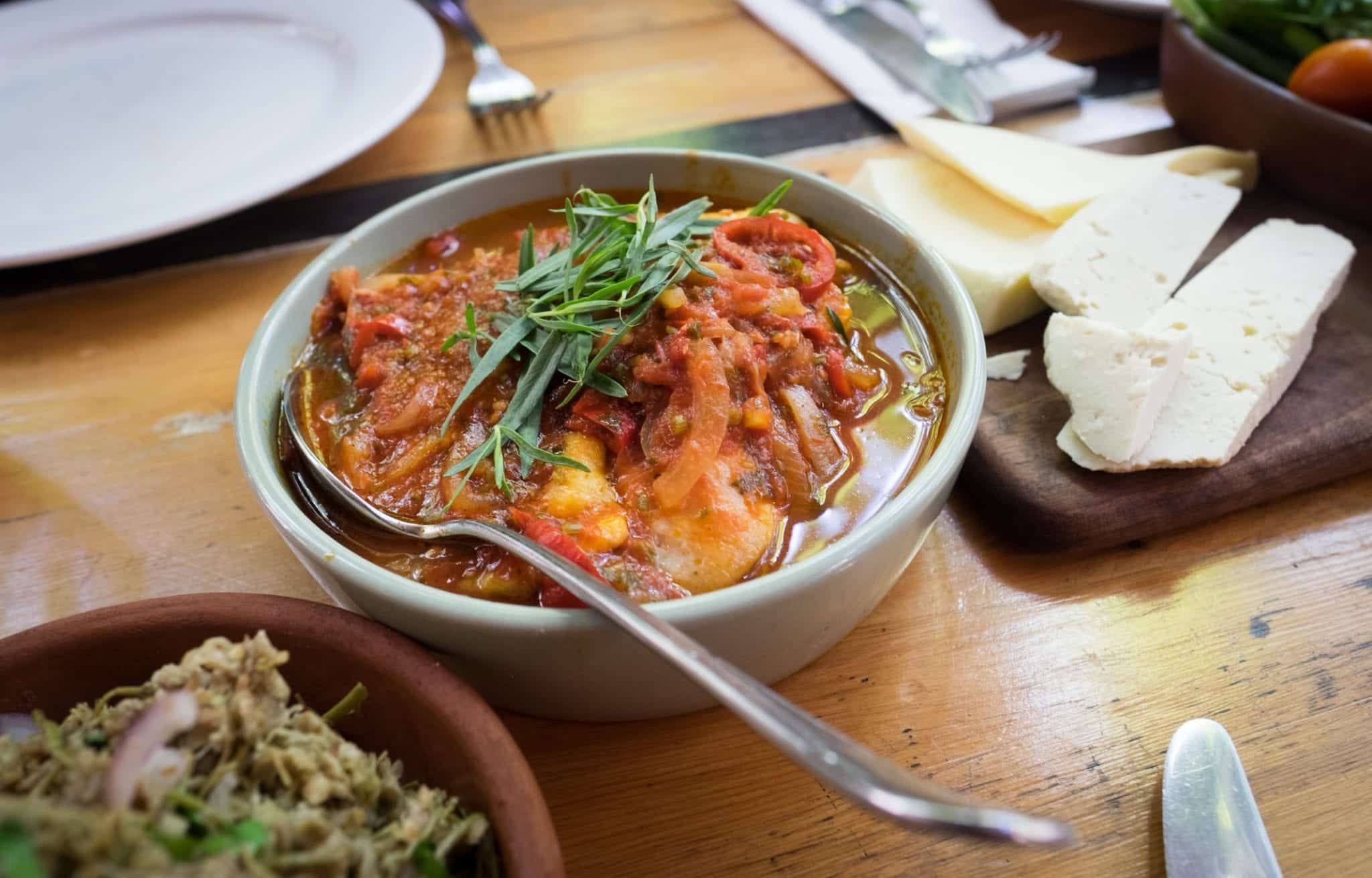
For main courses, stew-like dishes were popular. This was chicken stewed in onions and tomatoes with fresh herbs.
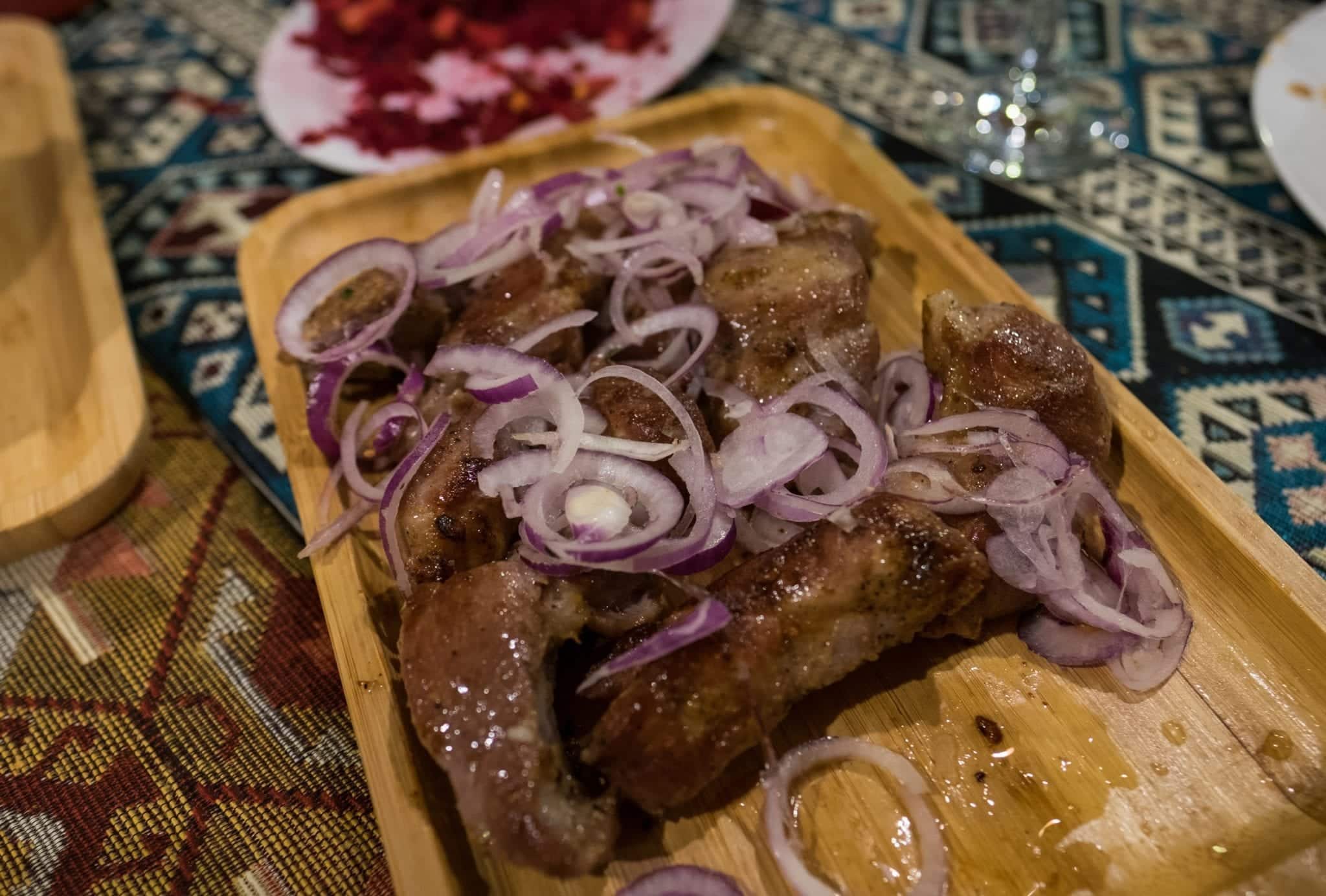
Grilled meats were popular as well — usually chicken or pork. This was pork grilled with red onions.

Oh, and khinkali. These dumplings are ubiquitous and are usually stuffed with meat, though they sometimes have cheese, mushroom, and potato khinkali as well. They usually cost no more than 25 cents each. I think the most I ever ate in a single sitting was five or six, so that is one cheap meal!
Lots of restaurants have khinkali on the menu but won’t allow you to order a ton because they won’t make any money. Stick to khinkali shops if you want a giant plate of dumplings.
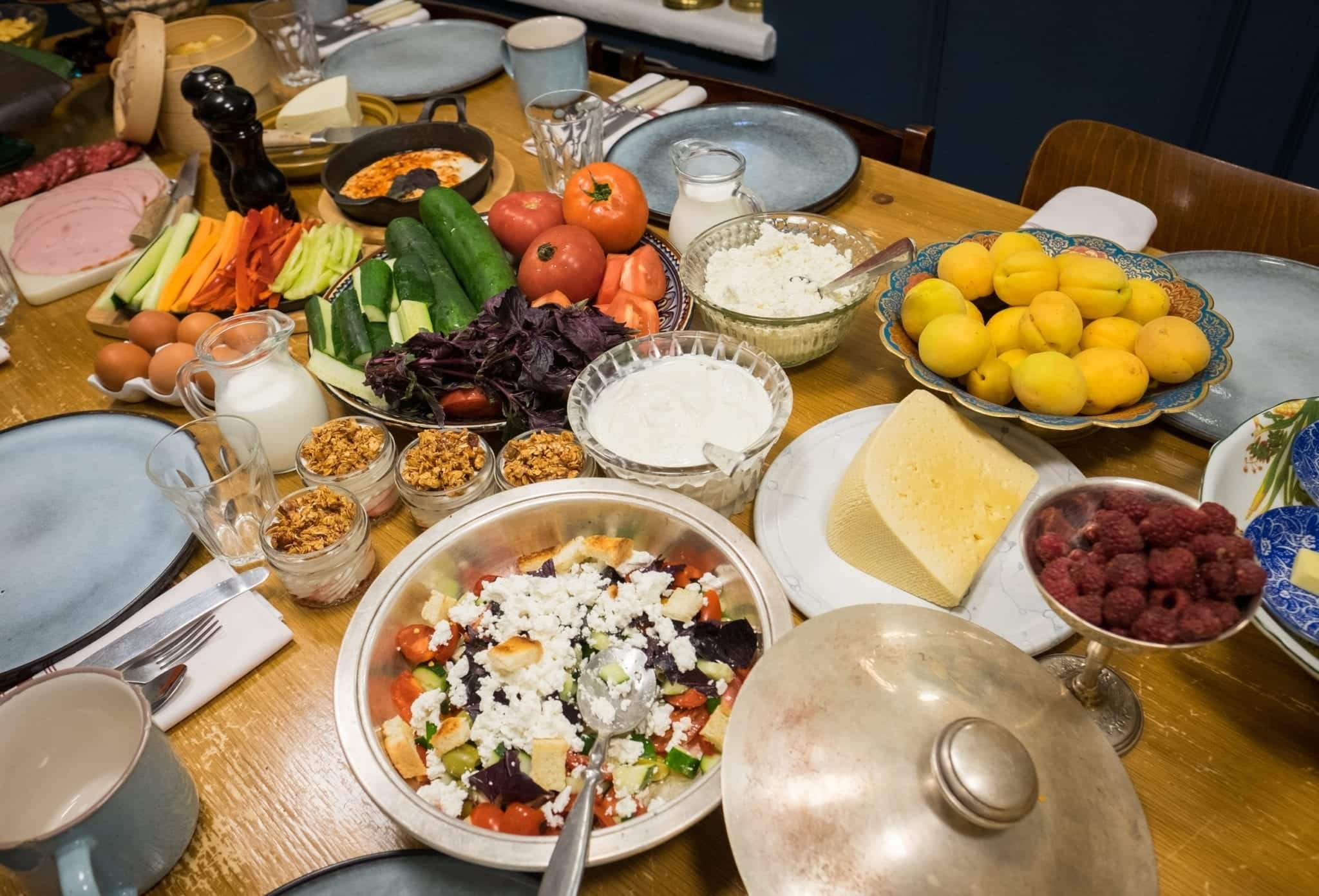
If I had to point out any flaws about Georgian cuisine, perhaps it’s that they often cook grilled meats into oblivion rather than leaving them juicy. And Georgian cuisine is fairly bread-heavy; it’s unfortunate that celiacs can’t eat signature Georgian dishes like khachapuri and khinkali. Vegetarians can eat well in Georgia; vegans are more limited but can find plenty of things to eat. Overall, there wasn’t a ton of variety in Georgia — we tended to eat dips and walnut salad and lobio and khachapuri at every meal.
My advice is to stay active throughout your Georgia trip, take a break from the heavy stuff occasionally, and plan to eat on the healthier side after you come back.
Georgian restaurants are very popular throughout Central and Eastern Europe, but they haven’t caught on in Western Europe and North America. But between the increased travel to Georgia and growing media coverage of Georgian cuisine, I’m sure that we will see more Georgian restaurants within the next decade.
If I had to pick the single best meal of my trip, it was at Shavi Lomi in Tbilisi. Get a reservation in advance.

Georgian Wine Country
Did you know that the Georgians were some of the earliest wine-makers in the world? They’ve been at it since roughly 6000 BCE, taking advantage of the soft climate with mountains and breezes from the Black Sea.
Most wine tourists in Georgia will head eastward to the Kakheti wine region and towns like Telavi and Sighnaghi. It’s an easy day trip from Tbilisi.
But we did something different — we went to Baia’s Vineyard in the Imereti region of Georgia, just outside Kutaisi in the northwest of the country. This is a bit off the beaten path for Georgia tourism but it was worth the journey. Especially to visit a women-owned winery!

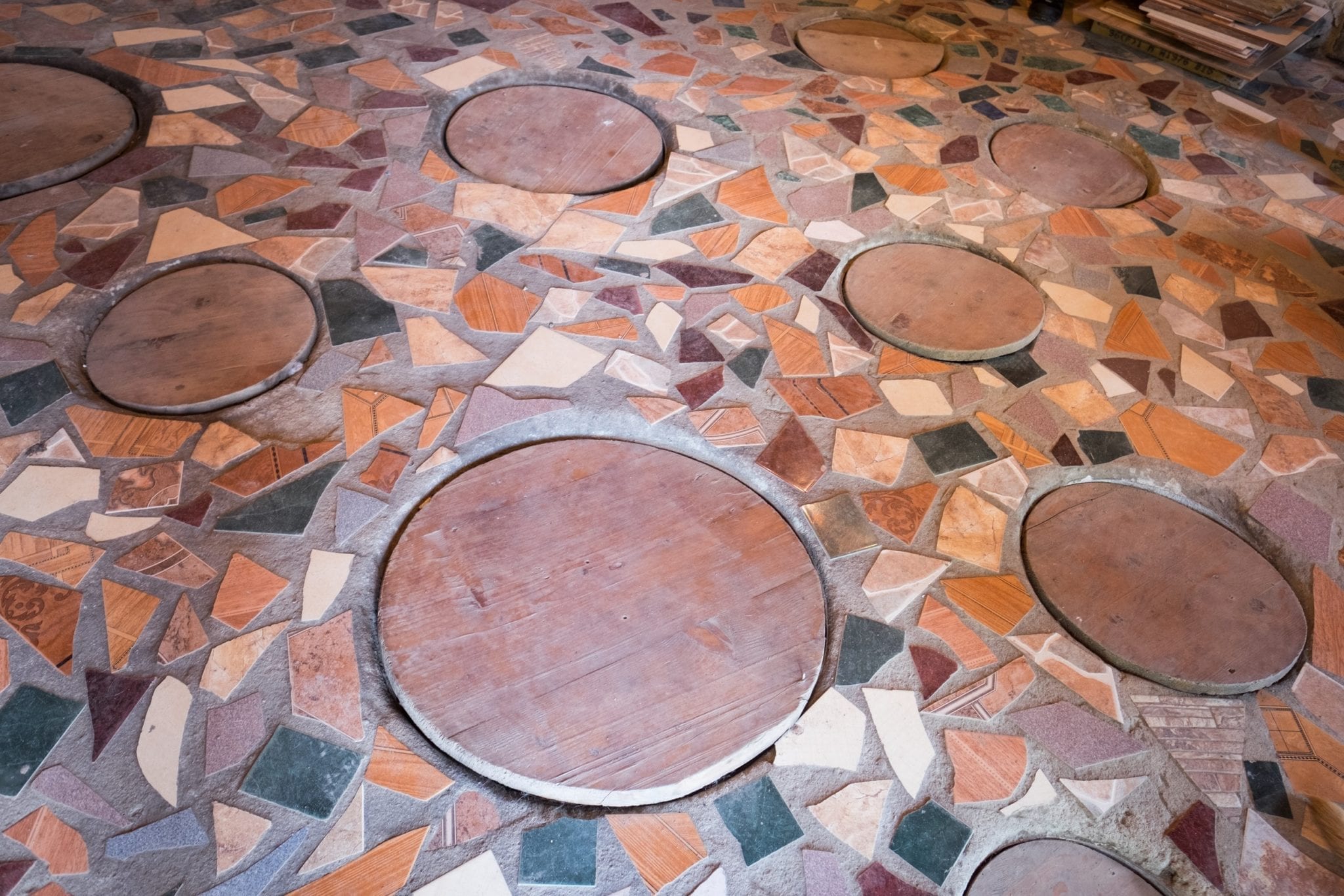
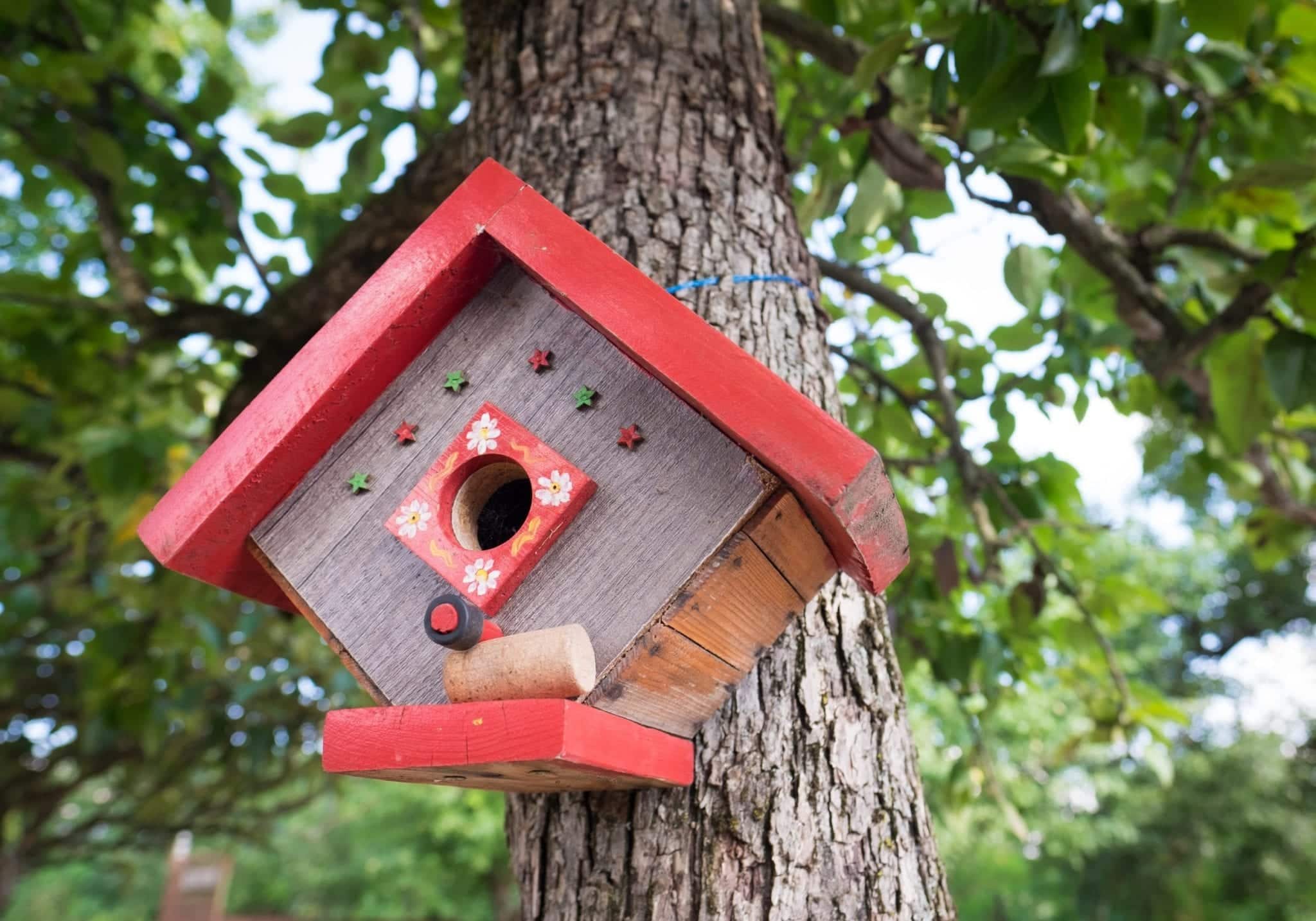
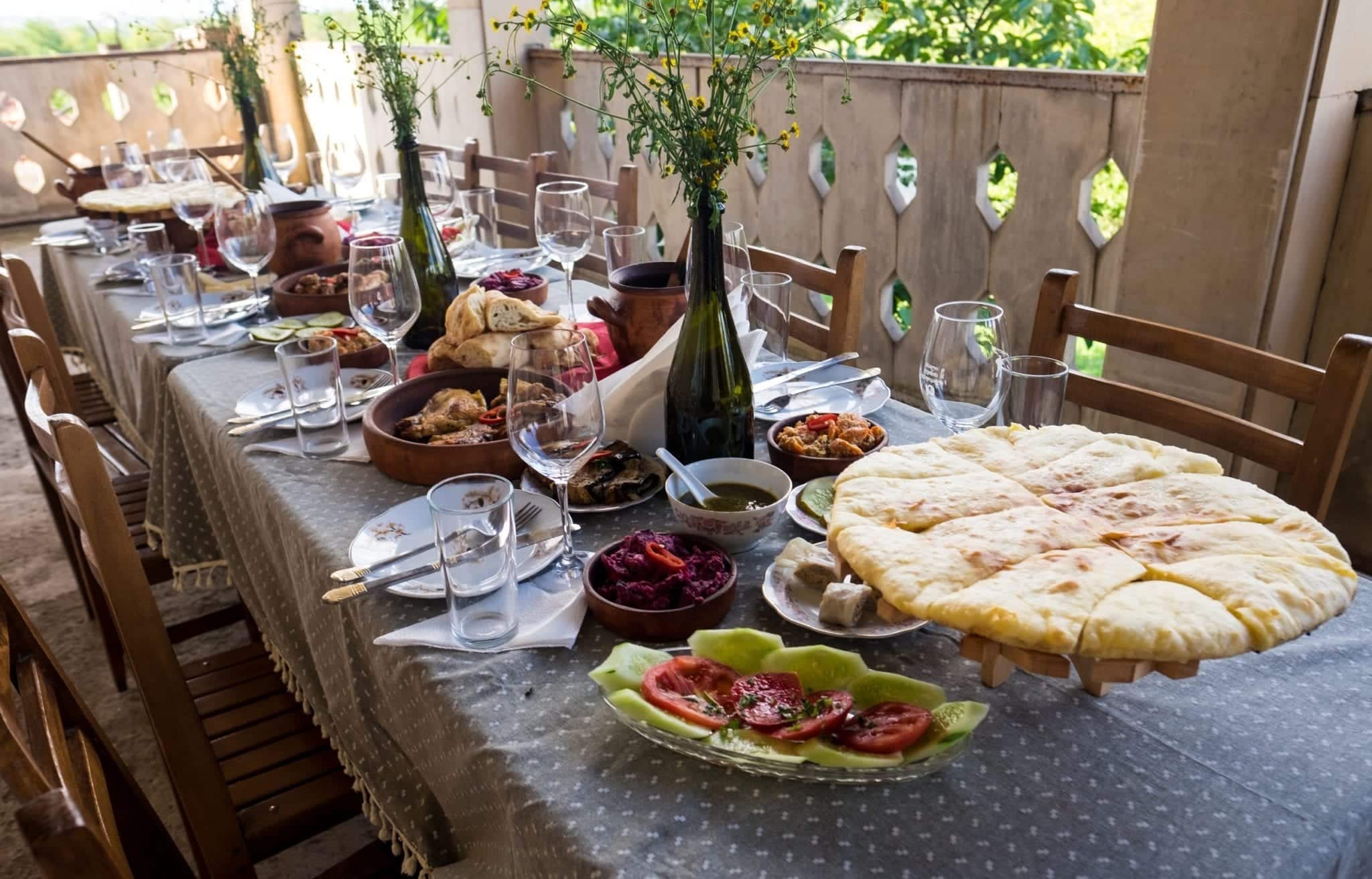
Baia specializes in small batch wines made with organic methods. The wine is made in qvevris — clay jars that are stored in the ground.
What a fantastic stop. Frolicking amongst the vines was fun; learning about qvevri wine and seeing the holes in the ground was interesting; the meal they served us was sensational.
Kutaisi is a worthwhile stop on the way to Svaneti — it breaks up a very long trip from Tbilisi. Make the most of your time in Kutaisi by including a stop at a wonderful Imereti winery like Baia’s.
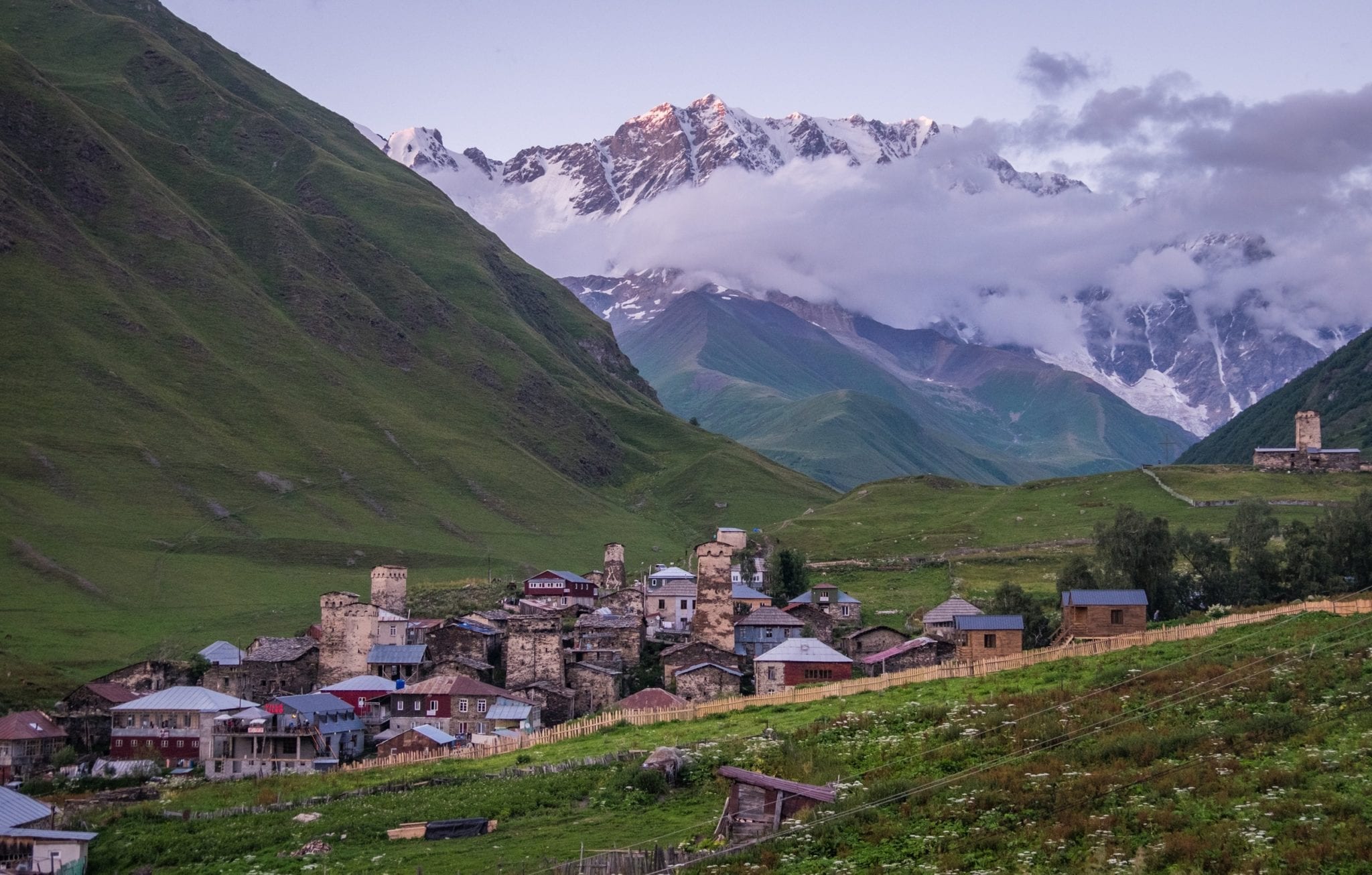
Svaneti
But if you want to go somewhere truly special in Georgia, I highly recommend that you travel to Svaneti. It is massively out of the way, but it’s a gorgeous, interesting region that is so different from the rest of the country.
When I dreamed of traveling to Georgia, Svaneti was always at the top of my Georgia travel list — I would painstakingly plan out itineraries, then fret that I didn’t have enough time to include the mountainous region.
I’m so thrilled that this trip was centered on Svaneti. Svaneti is easily the most picturesque place I visited in Georgia, mountains and villages strewn with ancient towers.
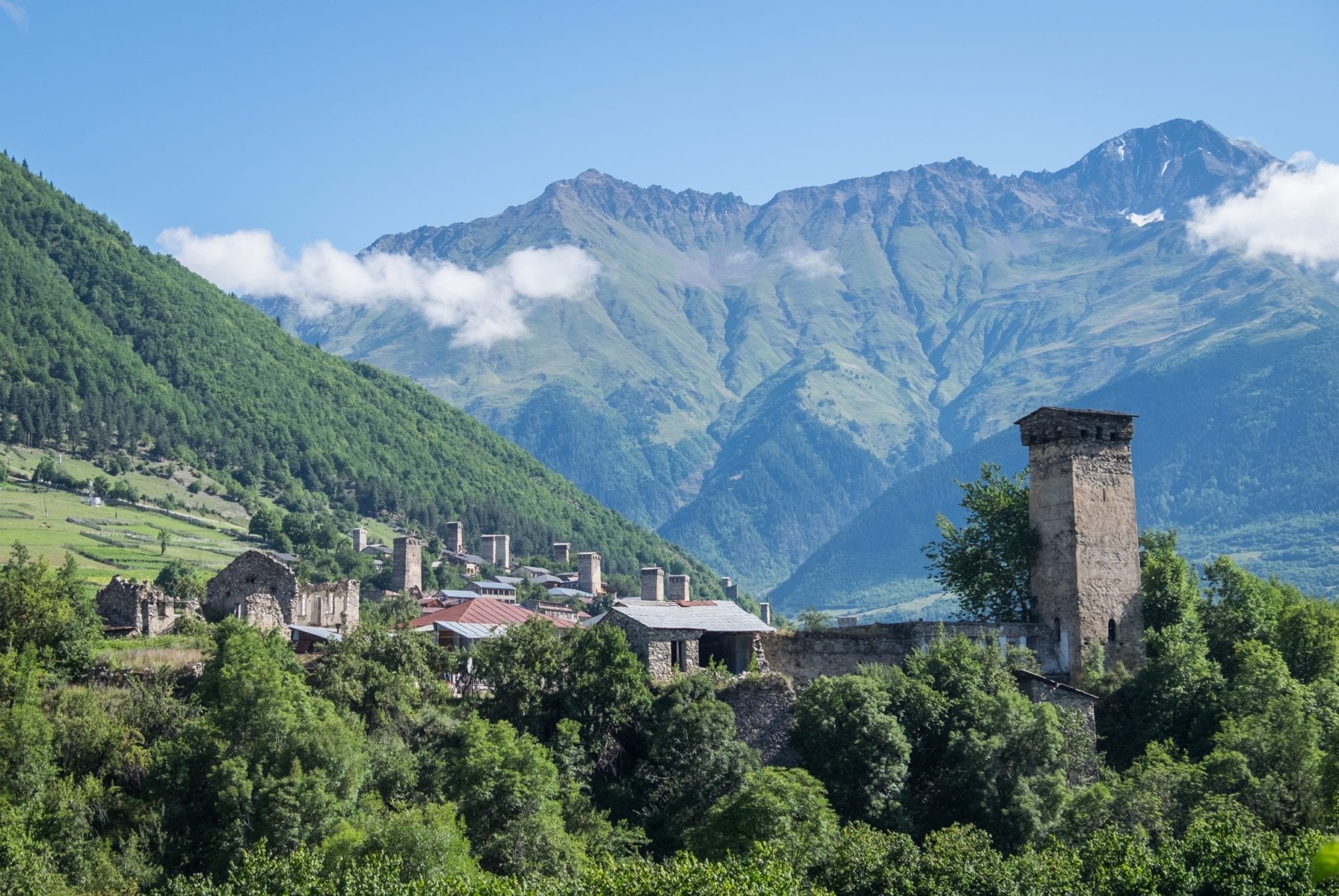
Mestia
Mestia is the largest city in the Svaneti region and your base to exploring the mountains. It’s a developing town built around the needs of tourists: you’ve got mountain chalets and simple guesthouses, pubs and restaurants with fireplaces, shops selling outdoor gear, and one great coffeeshop (Erti Kava) if you need your fix. Mestia reminded me a lot of Zakopane, Poland, another popular getaway to the mountains.
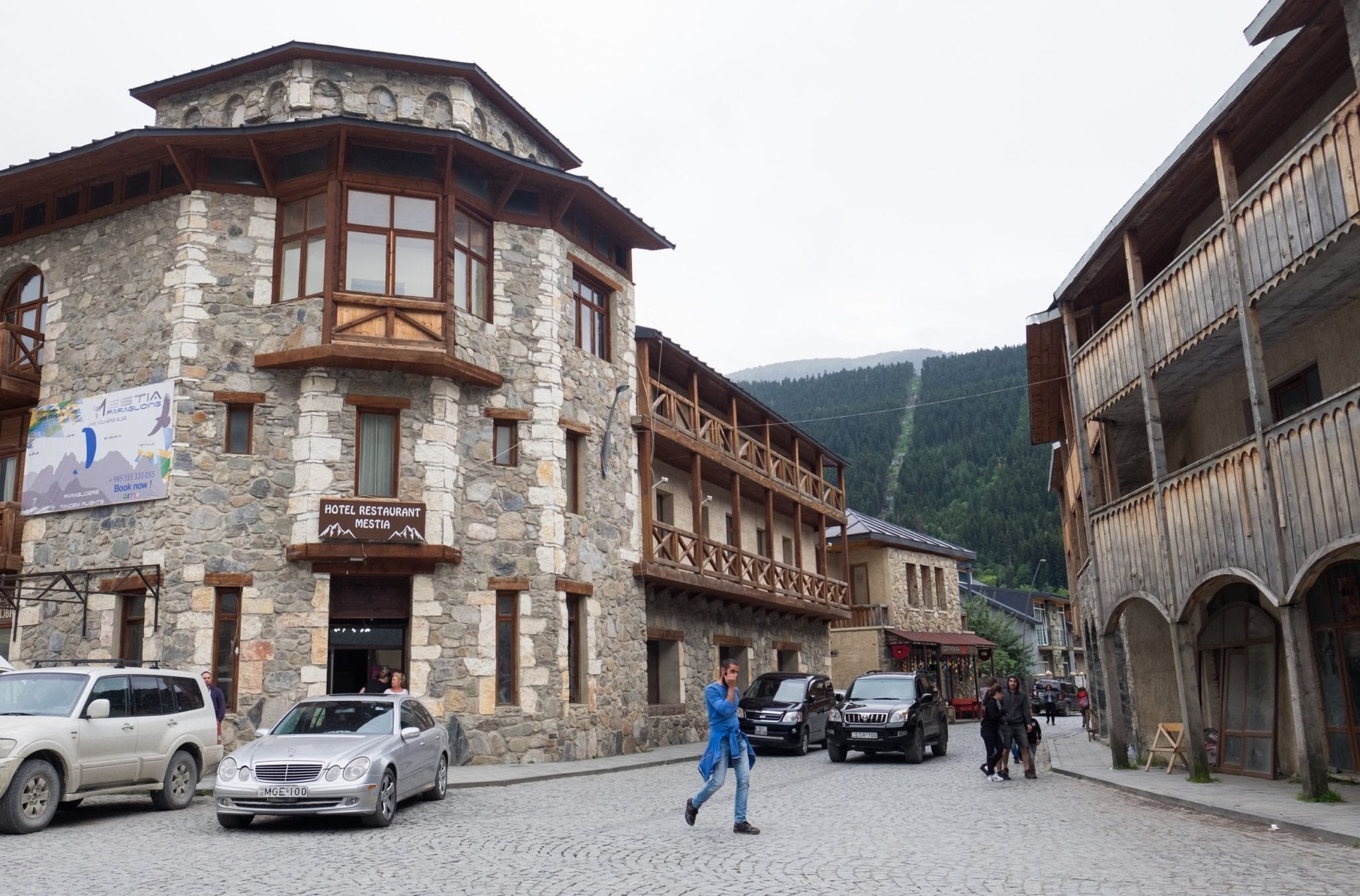
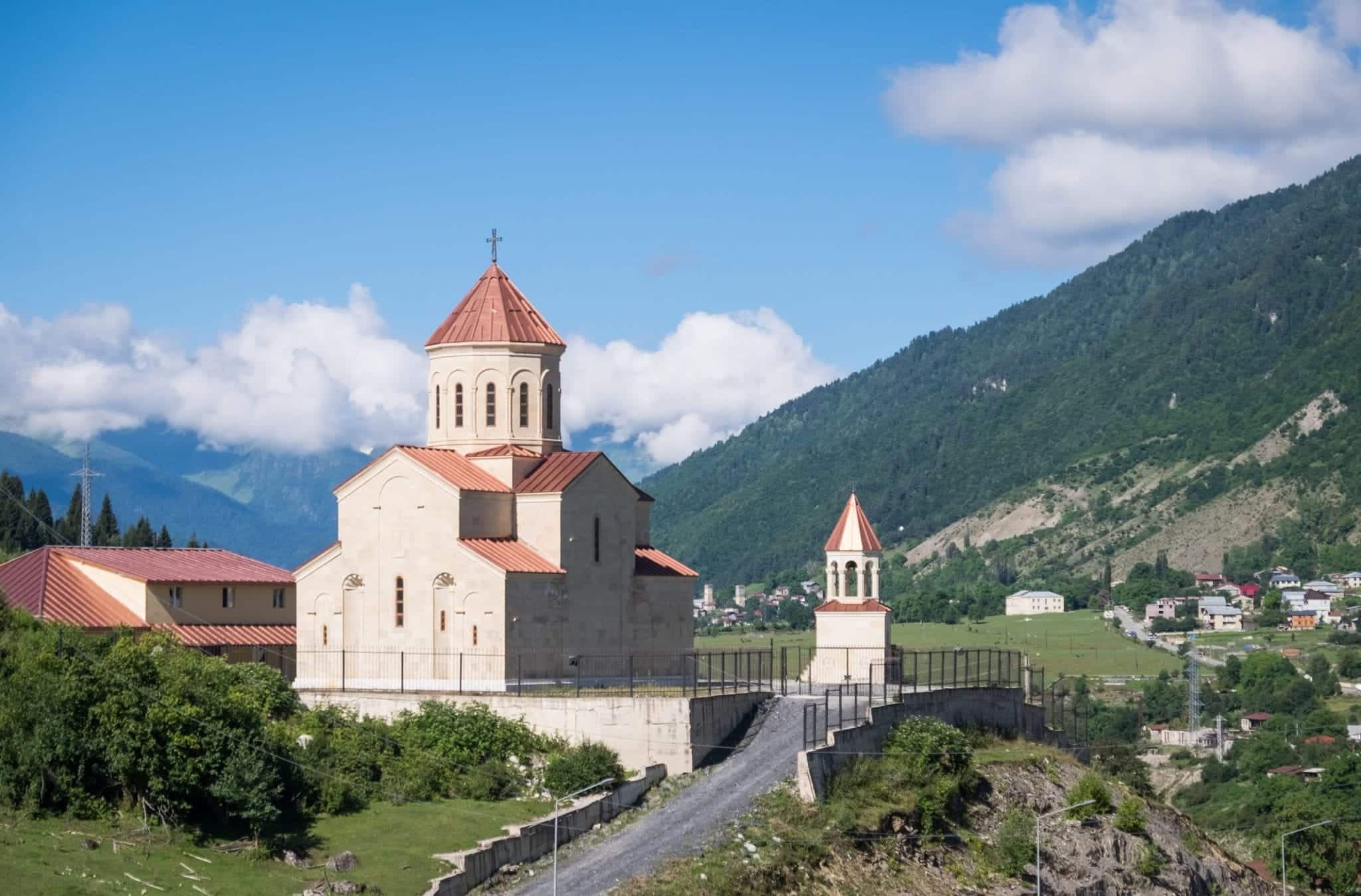
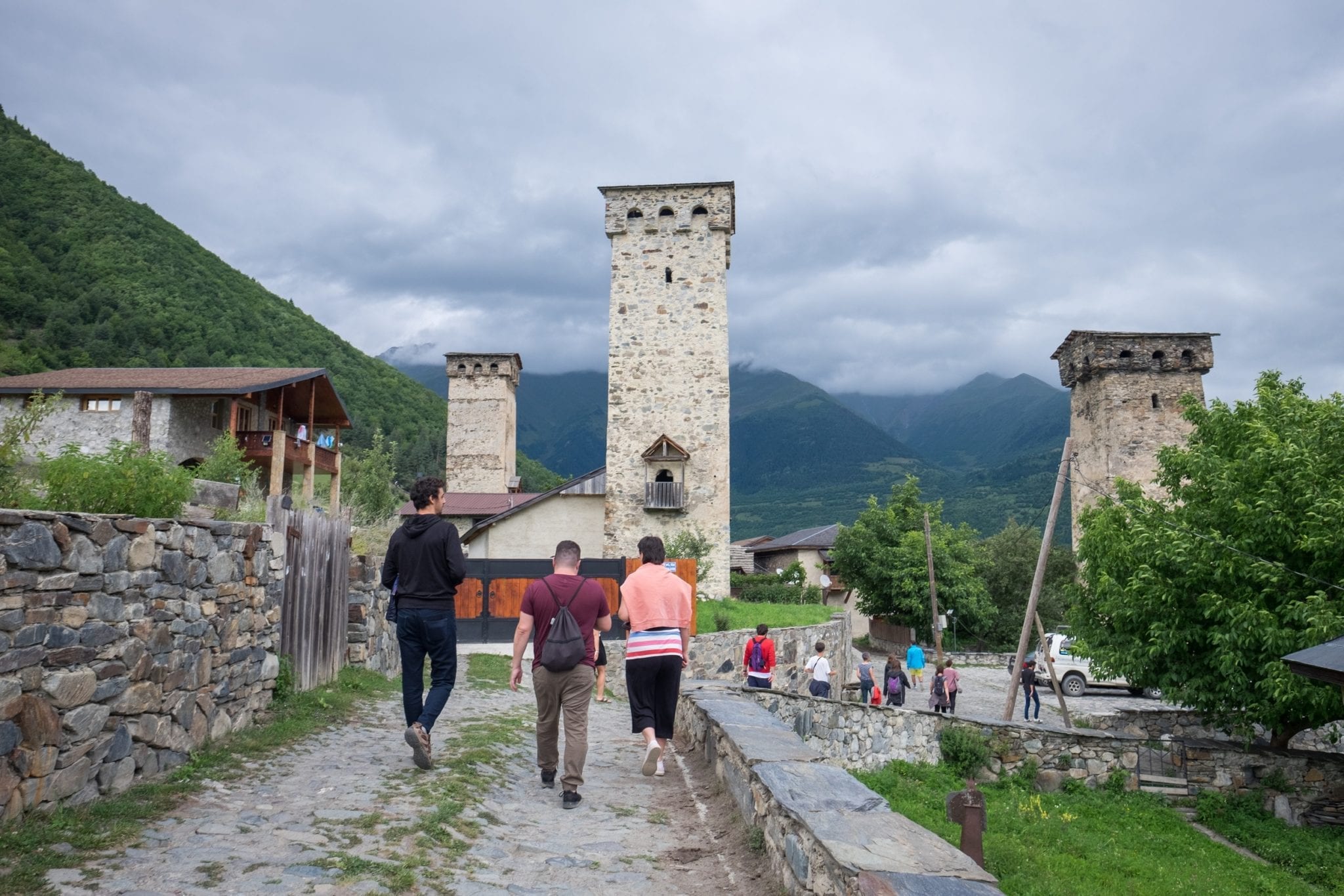
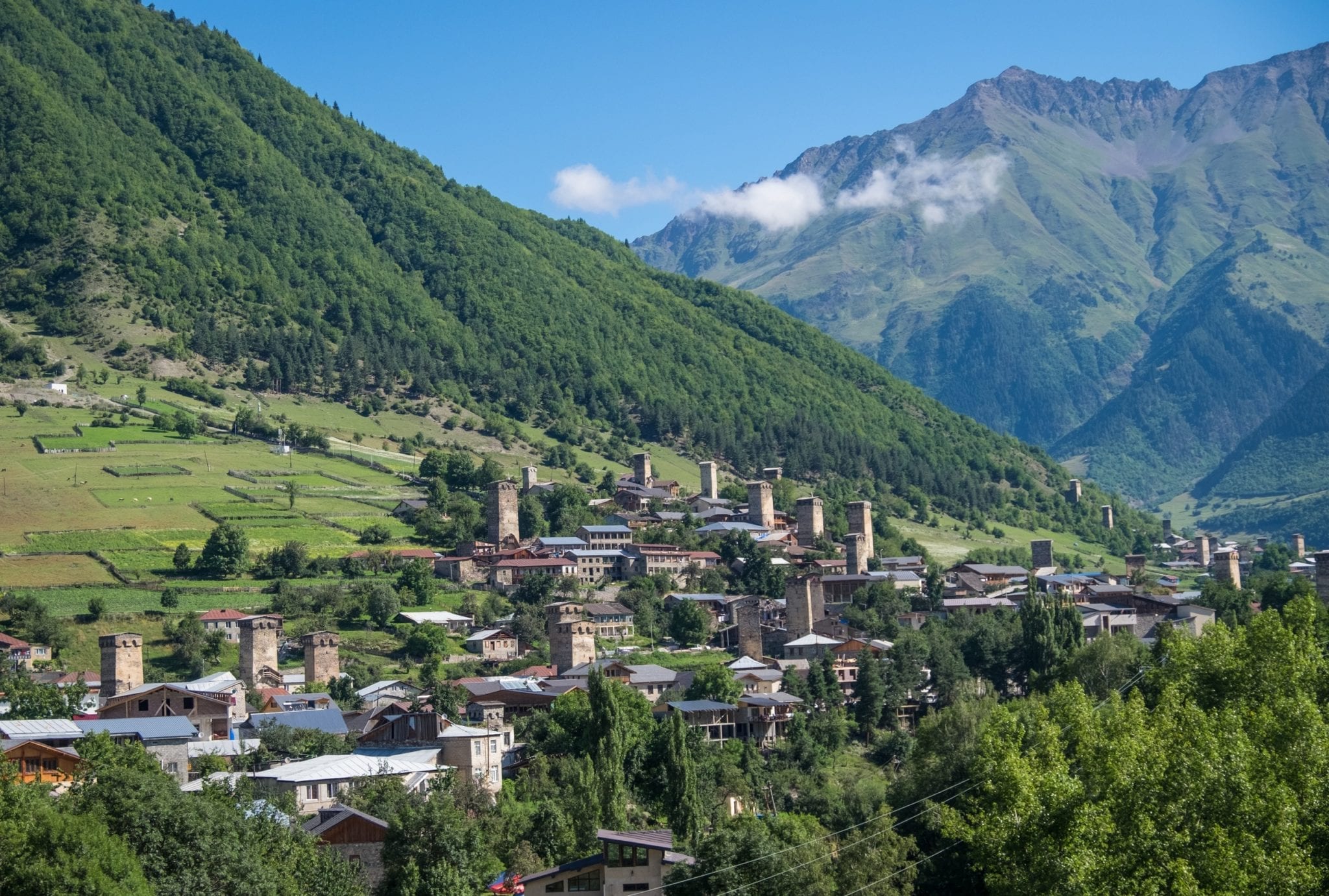
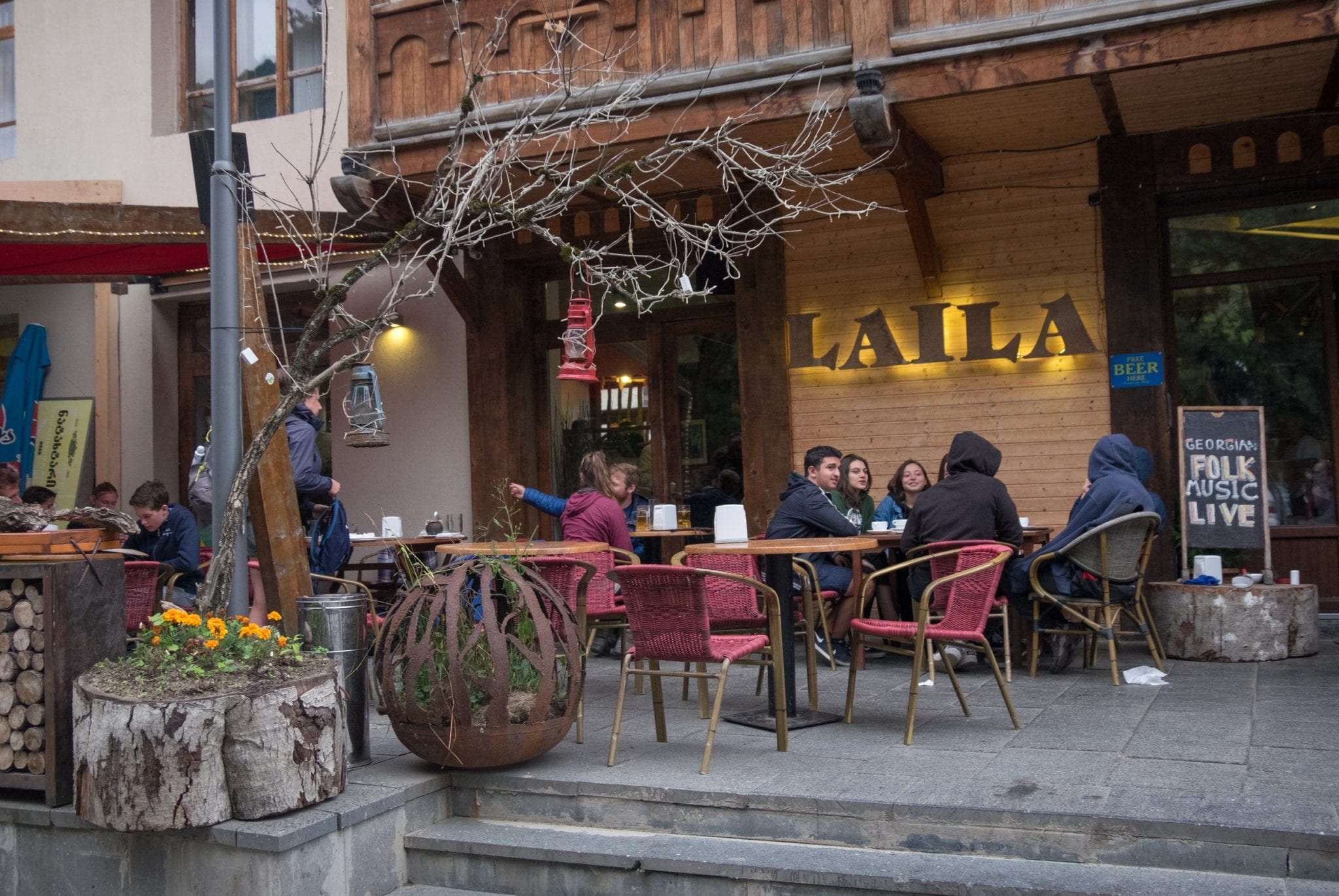
Mestia is also a good place for getting to know Svan culture. First up was Margiani’s House Museum, with a recreation of a Svan home from medieval times. (While it was closed when we arrived, our JayWay guide pulled some strings and got us a private visit.)
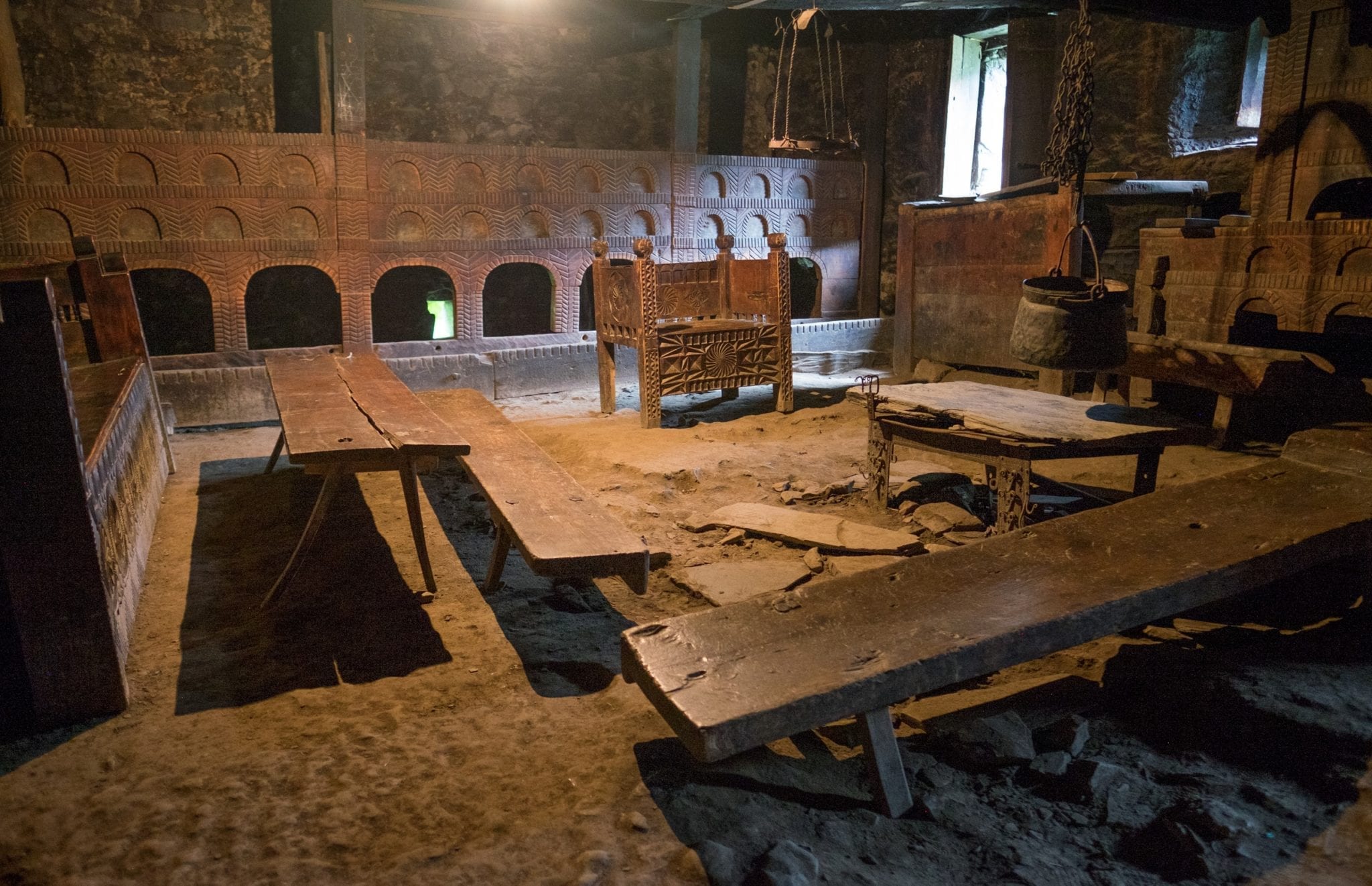
I especially appreciated the Museum of Ethnography, which is a surprisingly modern museum filled with interesting art and artifacts. There are outstanding views of Mestia from the roof.
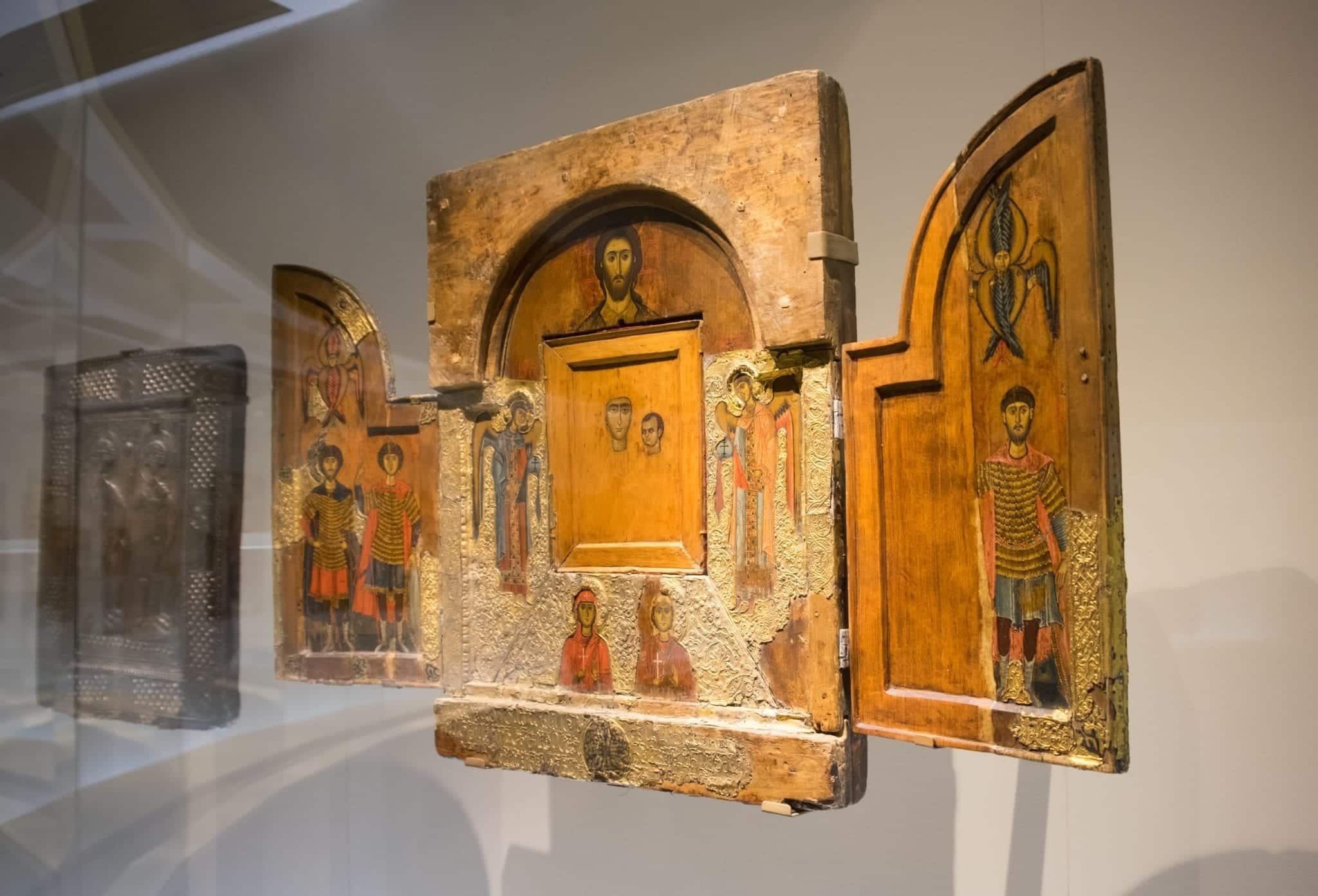
Another highlight of my time in Georgia was taking the cable car in Mestia to the top of Zuruldi ridge. You take two sets of cable cars to the top, where you can enjoy the highest restaurant in Mestia! There are views of the mountains in all directions and it makes a spectacular backdrop for photos.
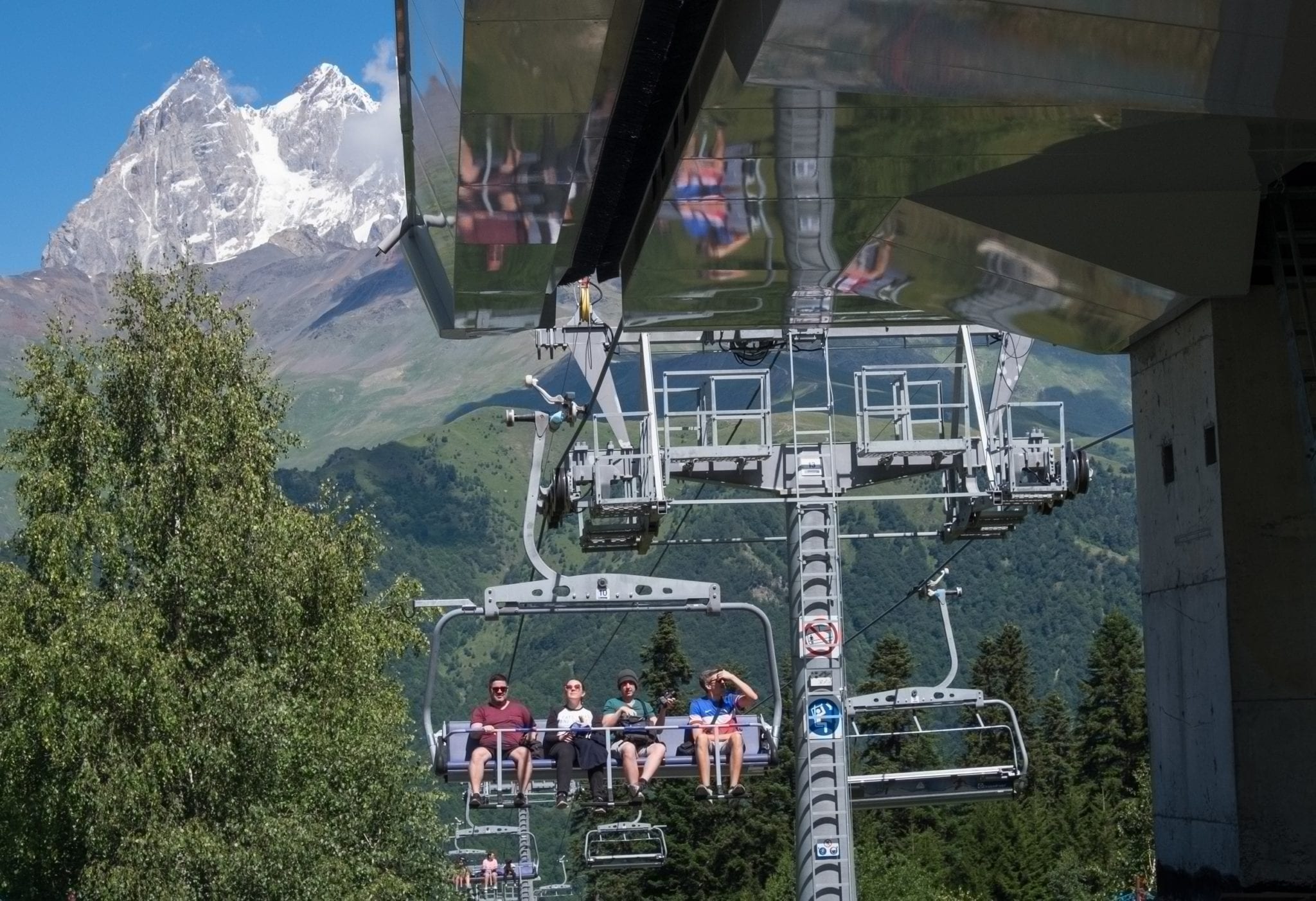
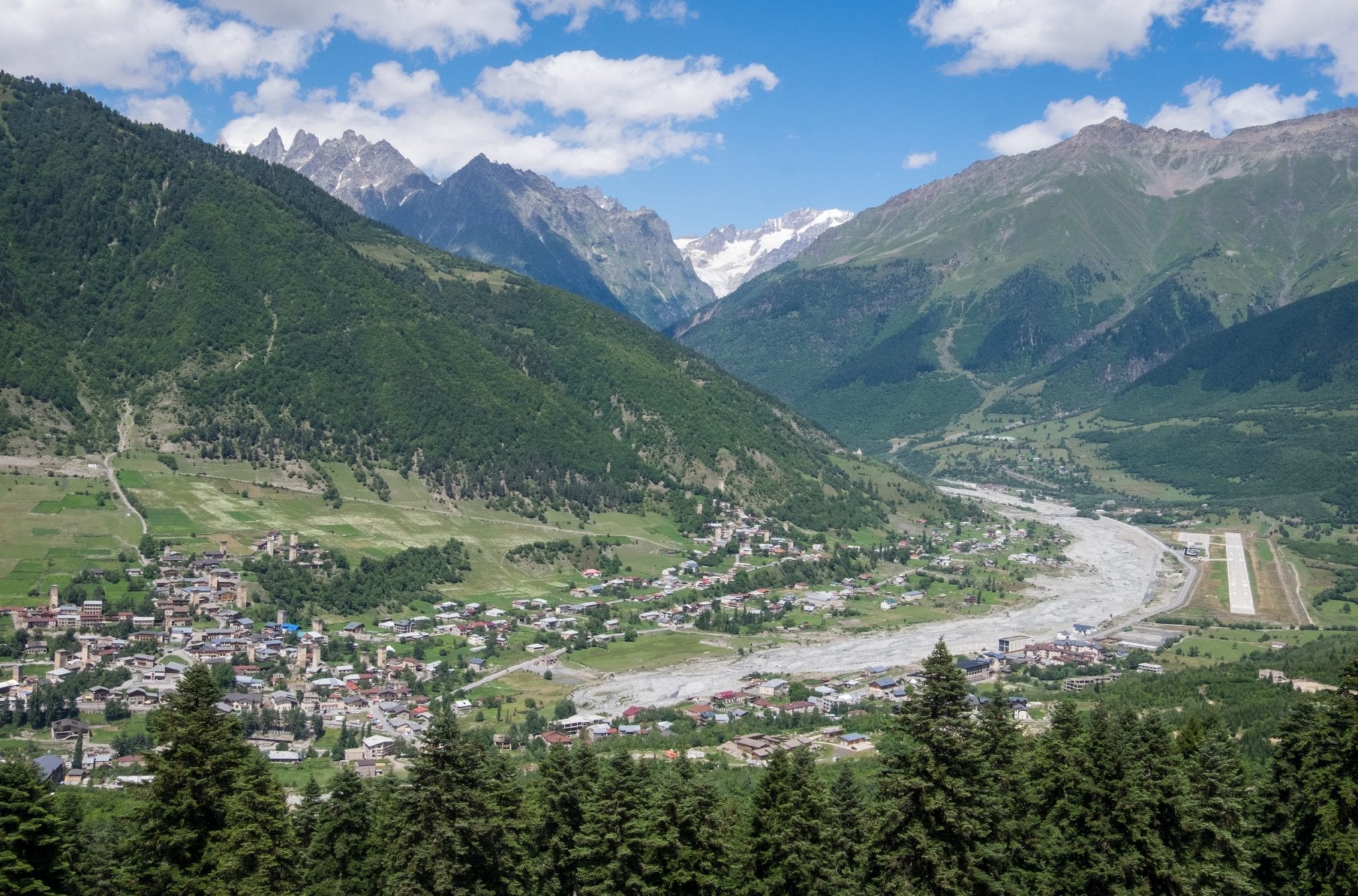
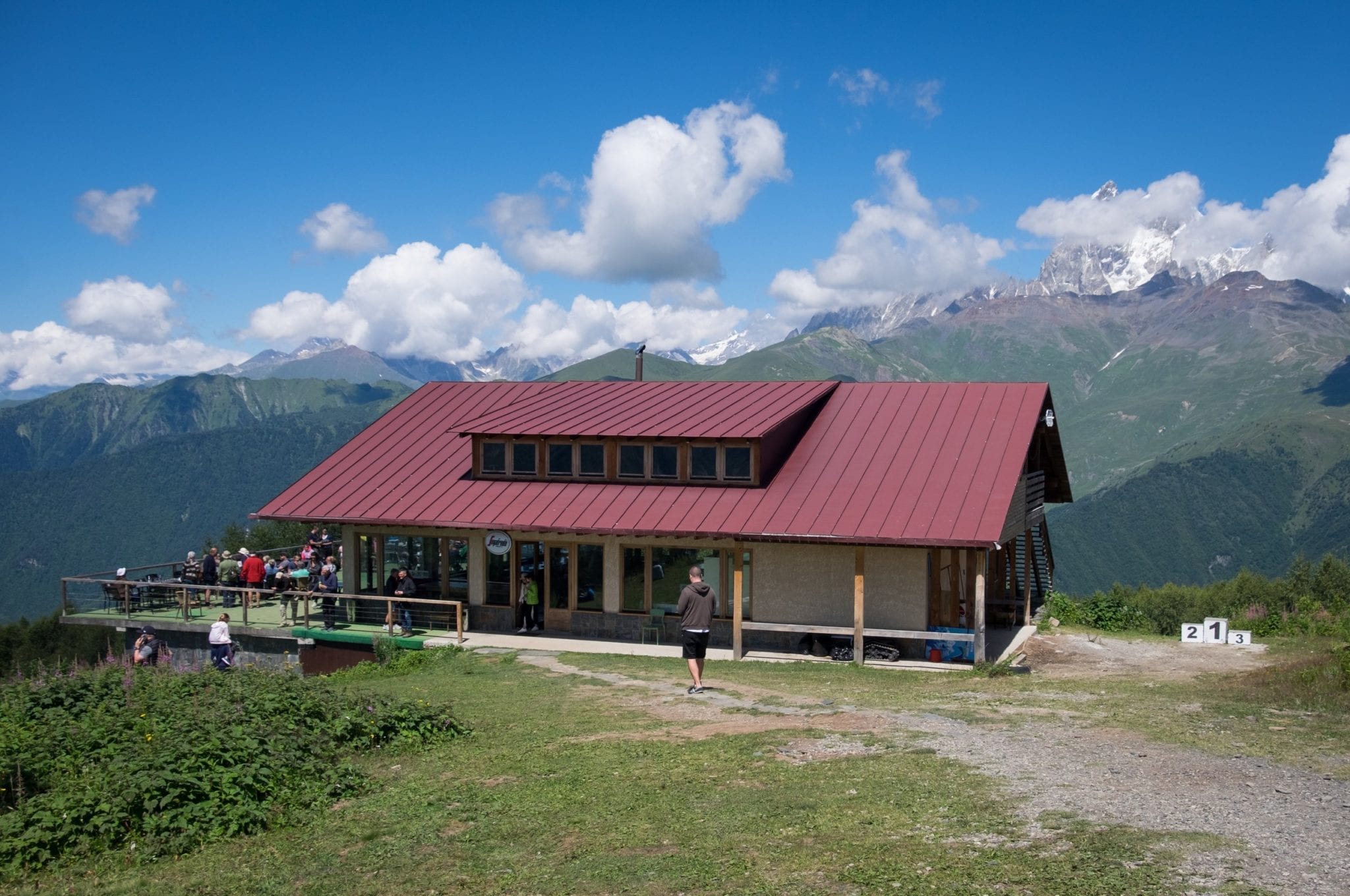
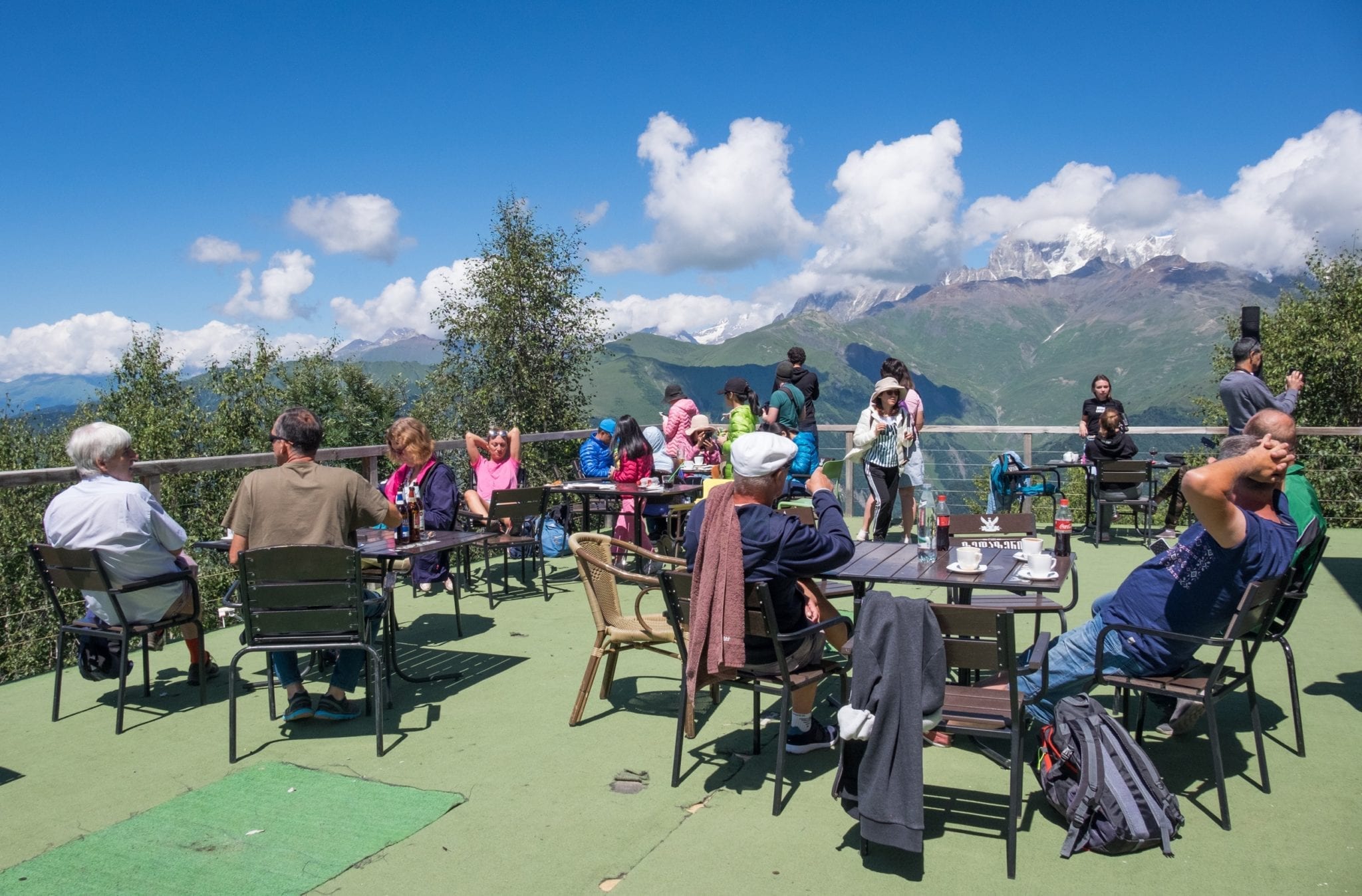
And one of the best nights of the trip was when we went to a bar in Mestia and got to see some impromptu Georgian dancing!
There is essentially one road to Mestia — it takes about three to four hours from Zugdidi, in the northwest of the country. You can get a marshrutka from the train station; marshrutkas usually include a one-hour break on the way. Some people push straight through from Kutaisi (4.5-5 hours) or even Tbilisi (8-9 hours). Some travelers like to take the overnight train from Tbilisi to Zugdidi.
There are also limited flights on Vanilla Sky Airlines from Tbilisi to Mestia. The flight takes one hour and only costs 90 GEL ($30). These flights tend to sell out in advance and can only be booked at the office; my JayWay contact in Tbilisi booked the tickets before I arrived.
If you travel to Svaneti with JayWay, you’ll have private transportation by car.
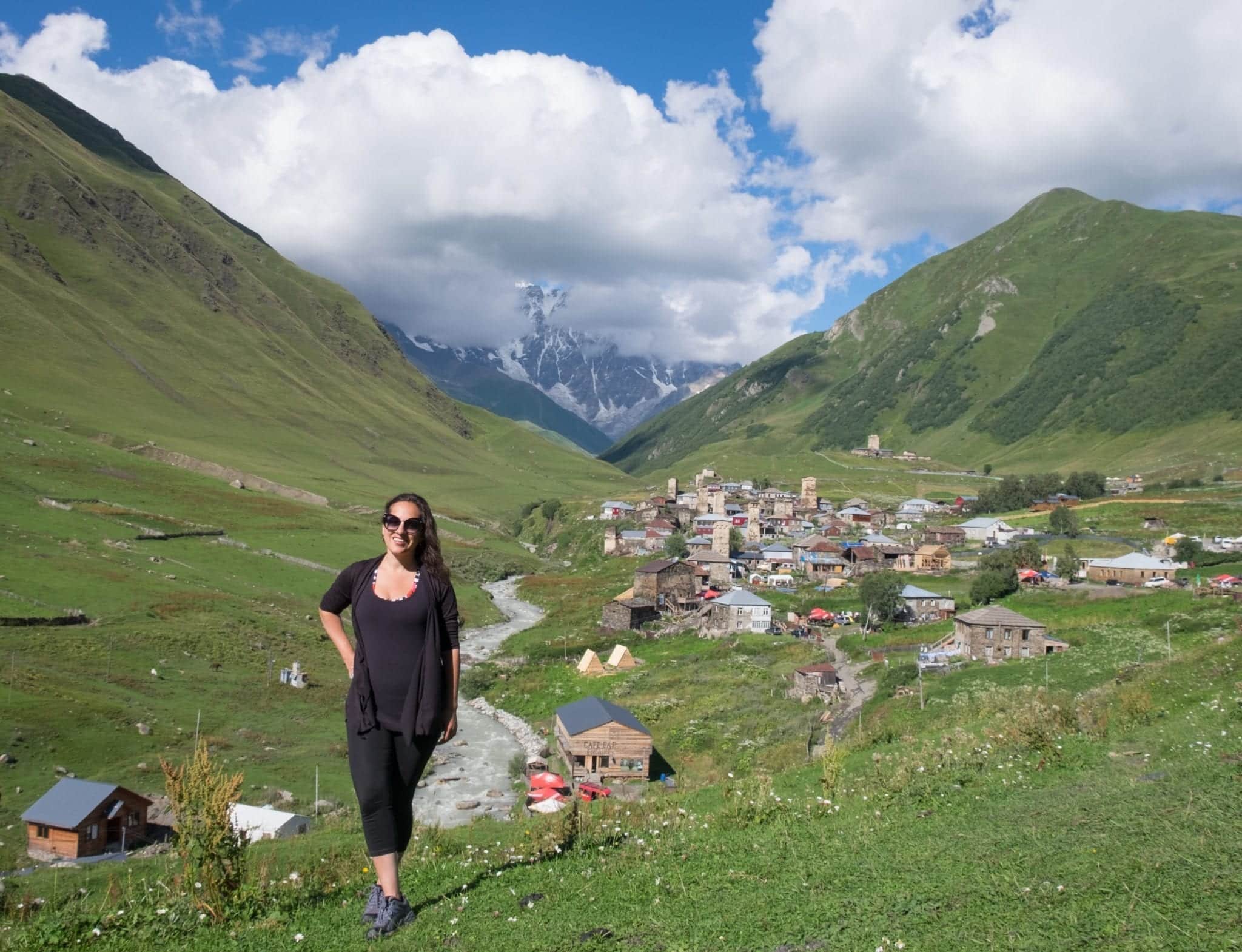
Ushguli
And if you REALLY want travel bragging rights, you’ll travel to Ushguli. Ushguli is the UNESCO World Heritage-listed village in Upper Svaneti and it feels like you’re teetering on the edge of the world.
Why does it earn you bragging rights? Because the drive there from Mestia is TERRIFYING. The first 40 minutes or so are a bit bumpy, but then it turns into giant swells back and forth where you creep along at a snail’s pace. I couldn’t even watch — I lay down with my eyes closed and my headphones in.
I can’t stress this enough: driving in Georgia is complicated enough as is, but the drive to Ushguli is even more so, requires a 4X4, and should only be driven by professionals. DO NOT ATTEMPT TO DRIVE YOURSELF TO USHGULI. BOOK A RIDE IN MESTIA. We ended up passing tourists who thought they could make it but gave up halfway through.
Once you arrive, though — you’ll be amazed.
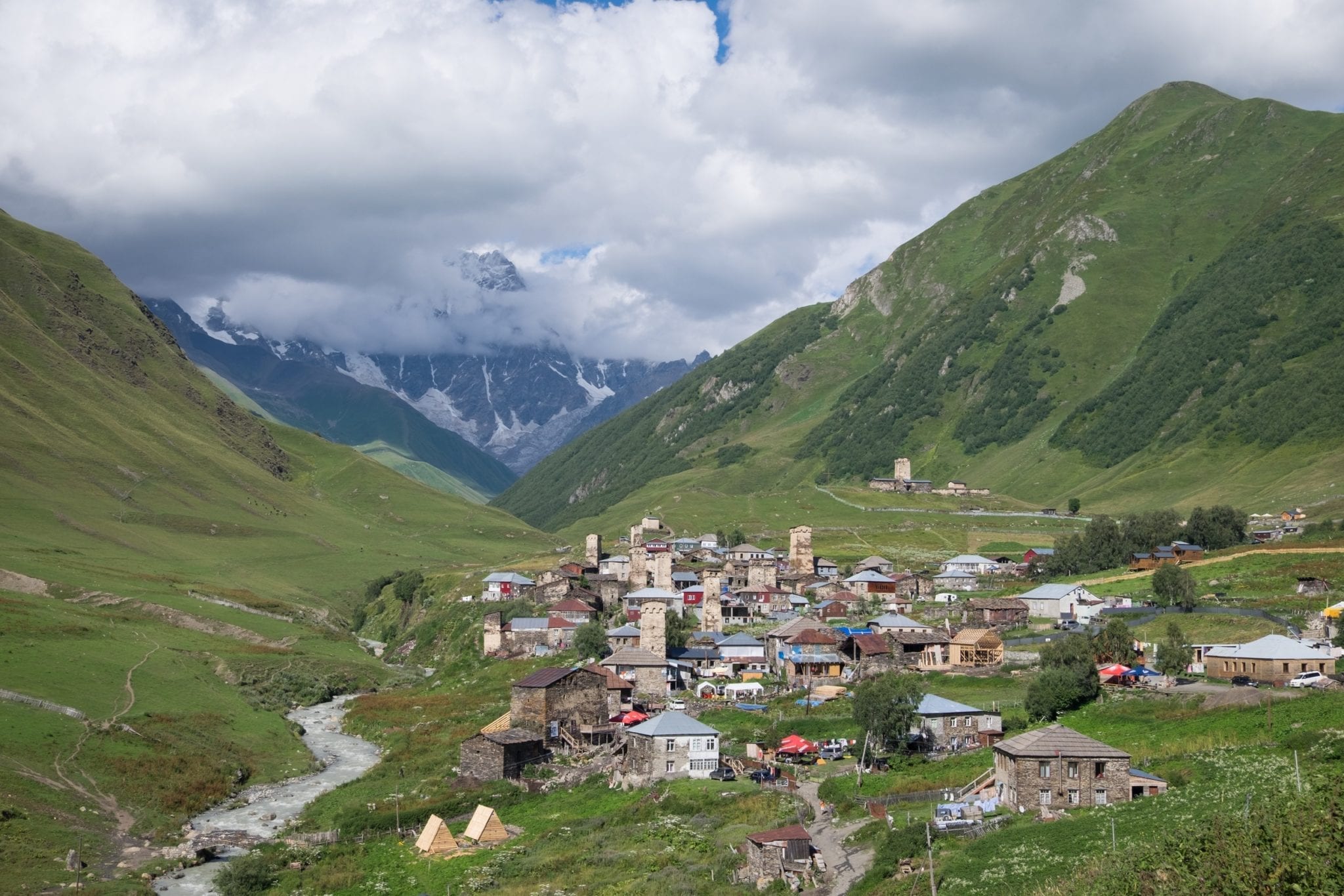
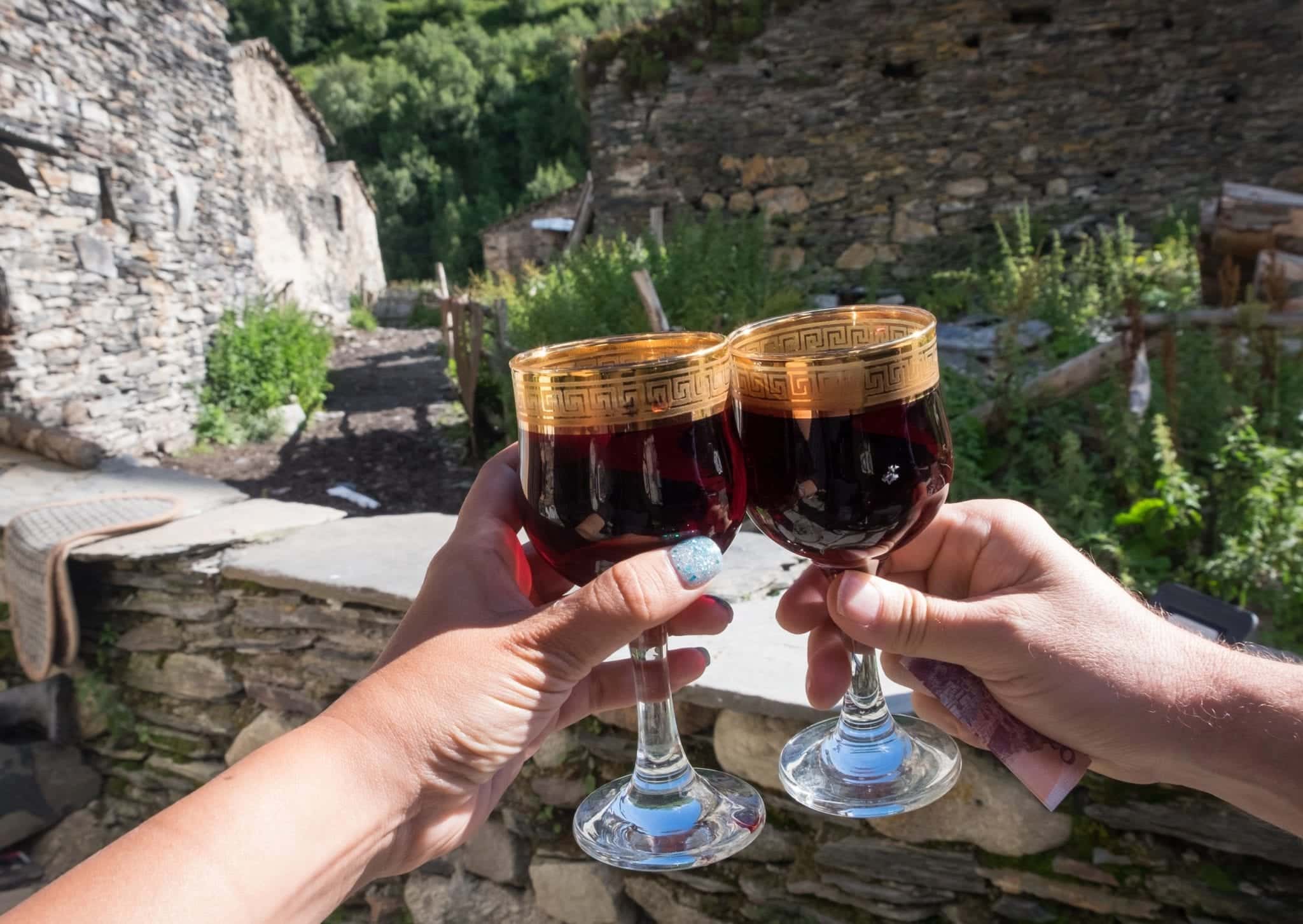
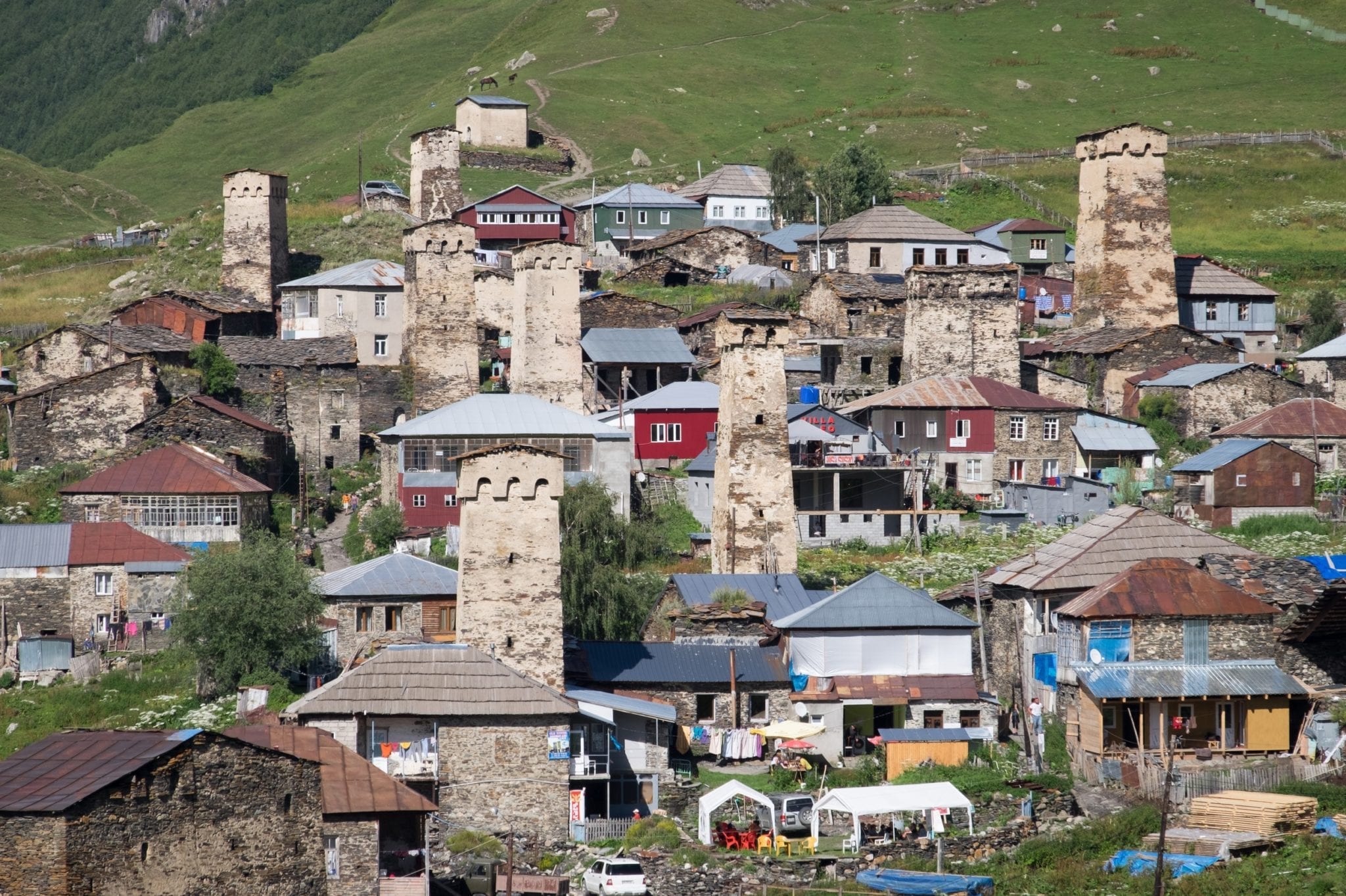
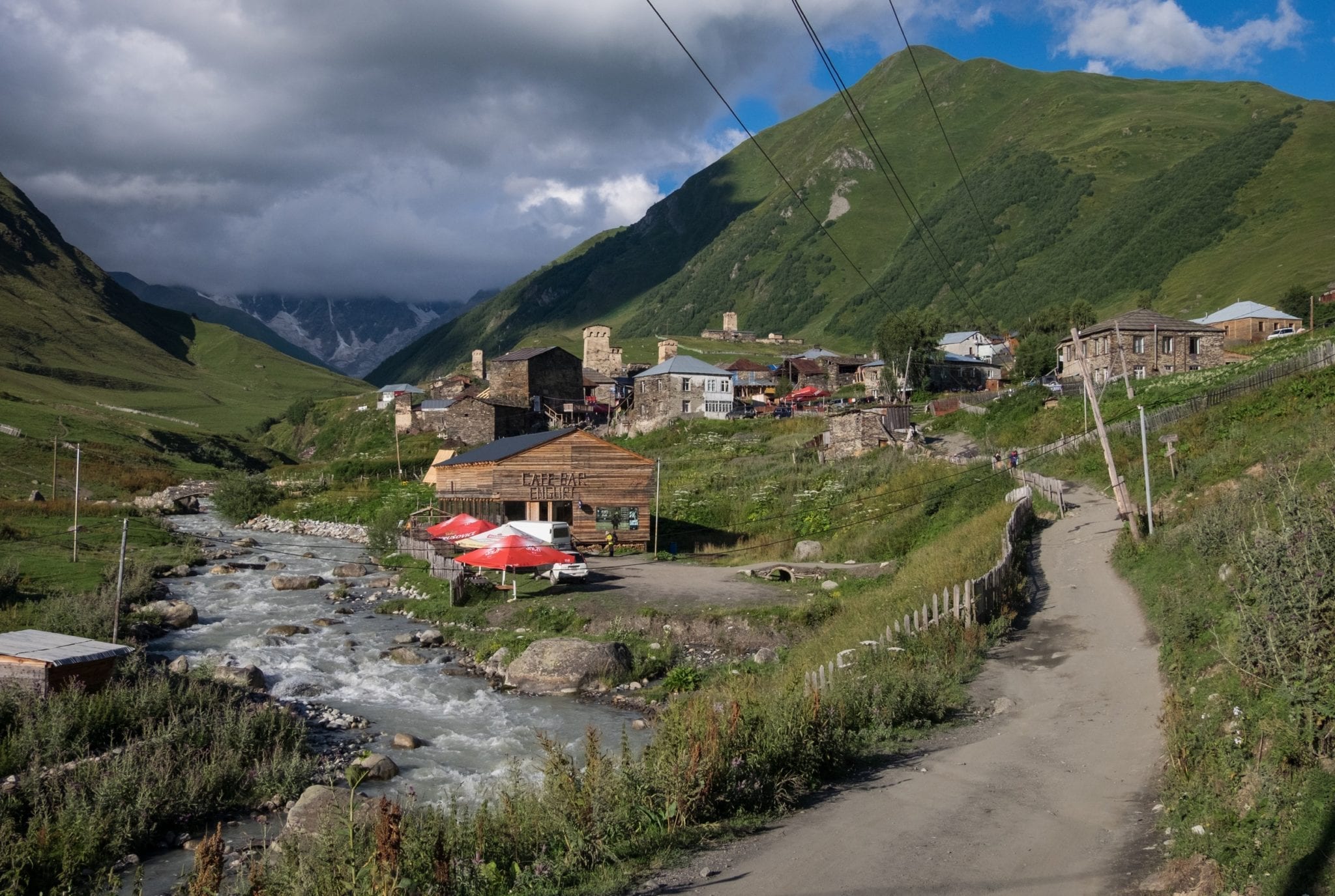
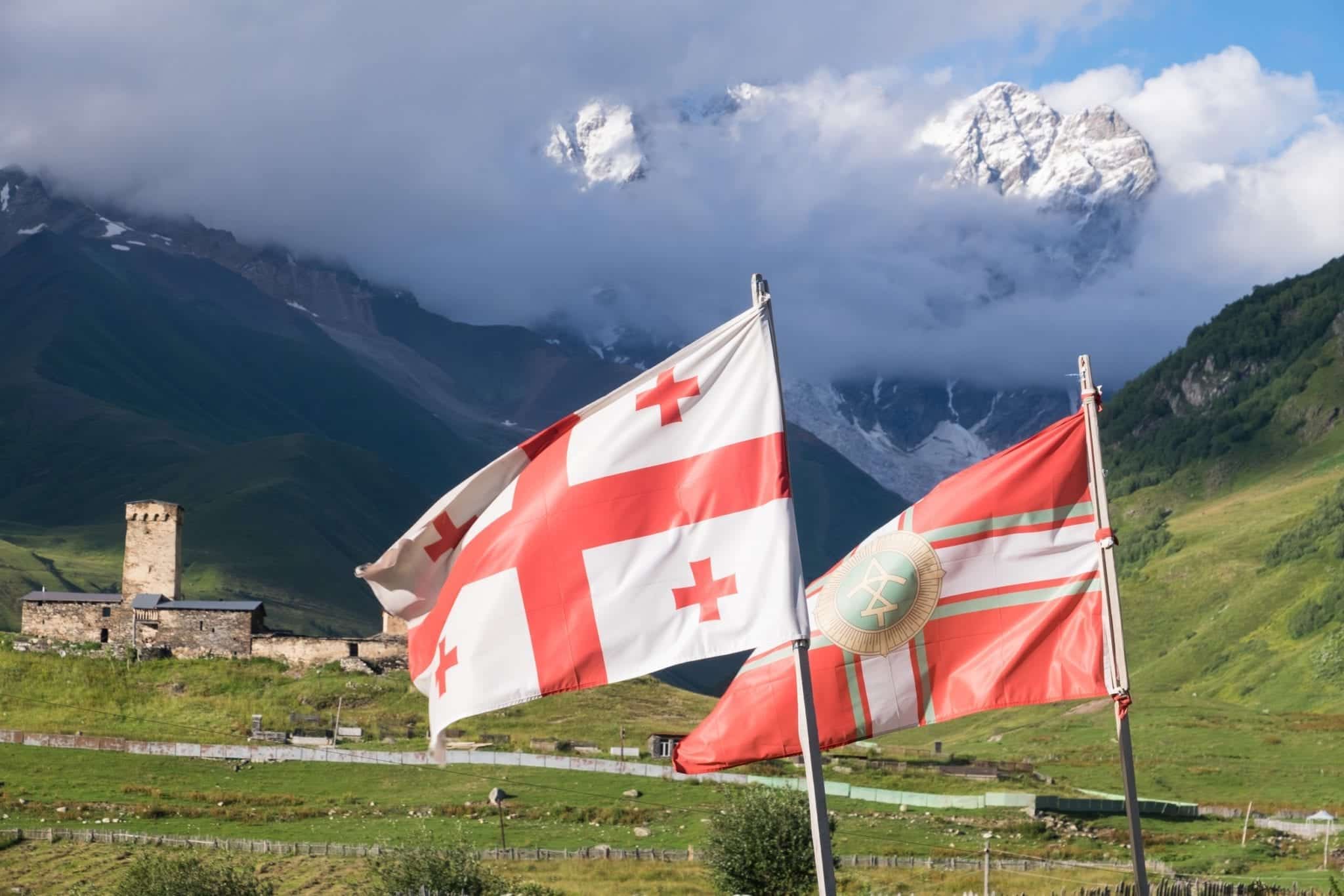
Ushguli is comprised of several villages along the road. Only one, Chazhashi, has the UNESCO designation. The main village, Chvibiani, is where you’ll find most amenities for travelers.
From what I heard, Ushguli has changed a lot in recent years. You can tell by seeing how many new properties have sprung up among the stone towers.
I have a guidebook to the Caucasus from a few years ago saved to my phone. It was published in 2016 and states that Ushguli only has accommodation with shared bathrooms. I’m glad to update that — in the past few years, several Ushguli hotels now have ensuite bathrooms, including the Hotel Panorama, where we stayed.
Keep in mind that Ushguli is as basic as it comes. Don’t expect internet access or luxury hotels. Being somewhere so isolated is its own luxury.
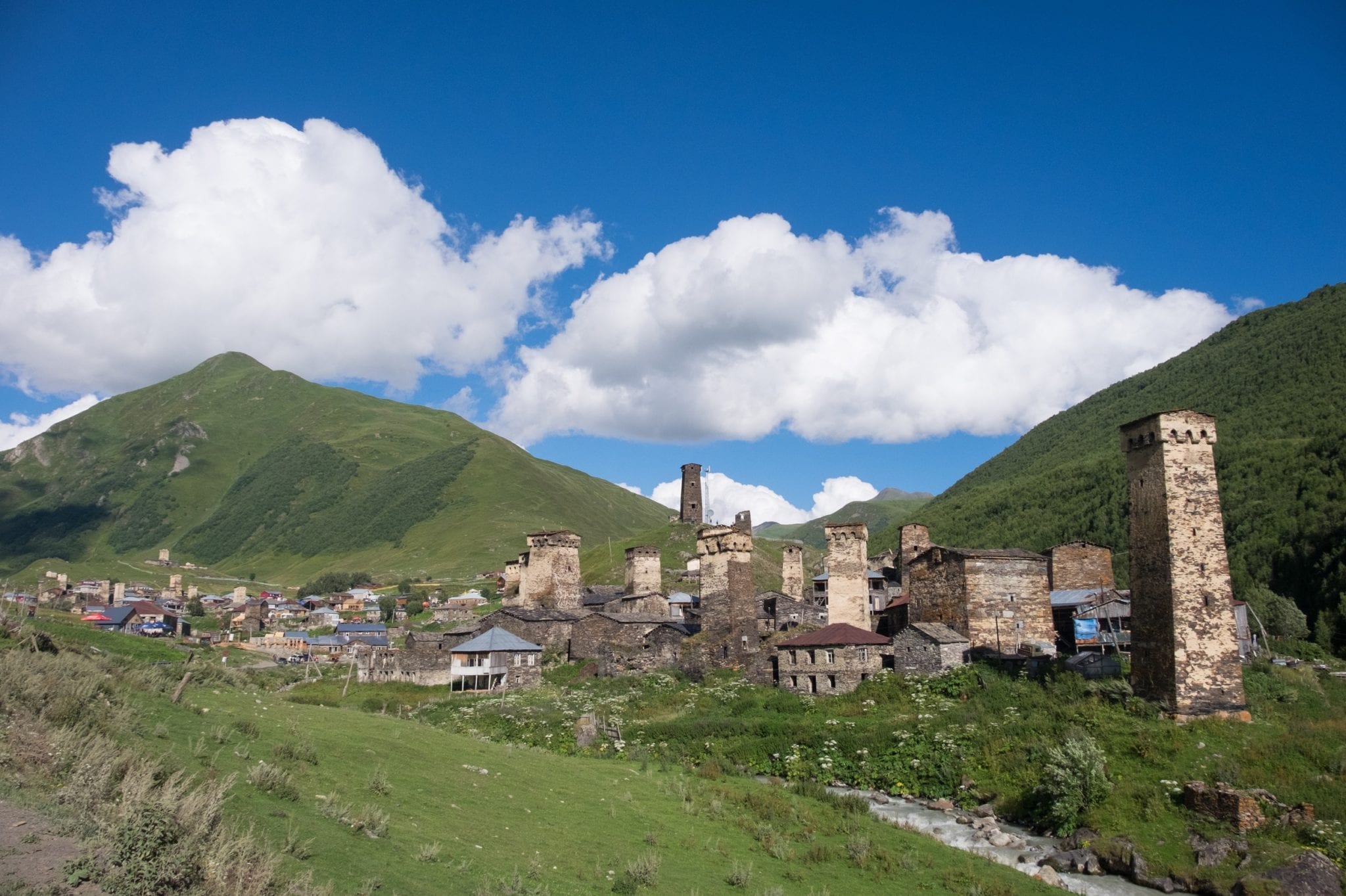
UNESCO World Heritage Sites in Georgia
Georgia has three UNESCO World Heritage Sites: Gelati Monastery, Historical Monuments of Mtskheta, and Upper Svaneti. All are worth visiting.
Upper Svaneti, my favorite of the three sites, does not constitute all of Svaneti — the only village with UNESCO designation is Chazhashi, which is part of Ushguli and is pictured above. It’s hard to get to but unique and very much the rough journey, in my opinion.
“Preserved by its long isolation, the Upper Svaneti region of the Caucasus is an exceptional example of mountain scenery with medieval-type villages and tower-houses. The village of Chazhashi still has more than 200 of these very unusual houses, which were used both as dwellings and as defence posts against the invaders who plagued the region.” —UNESCO
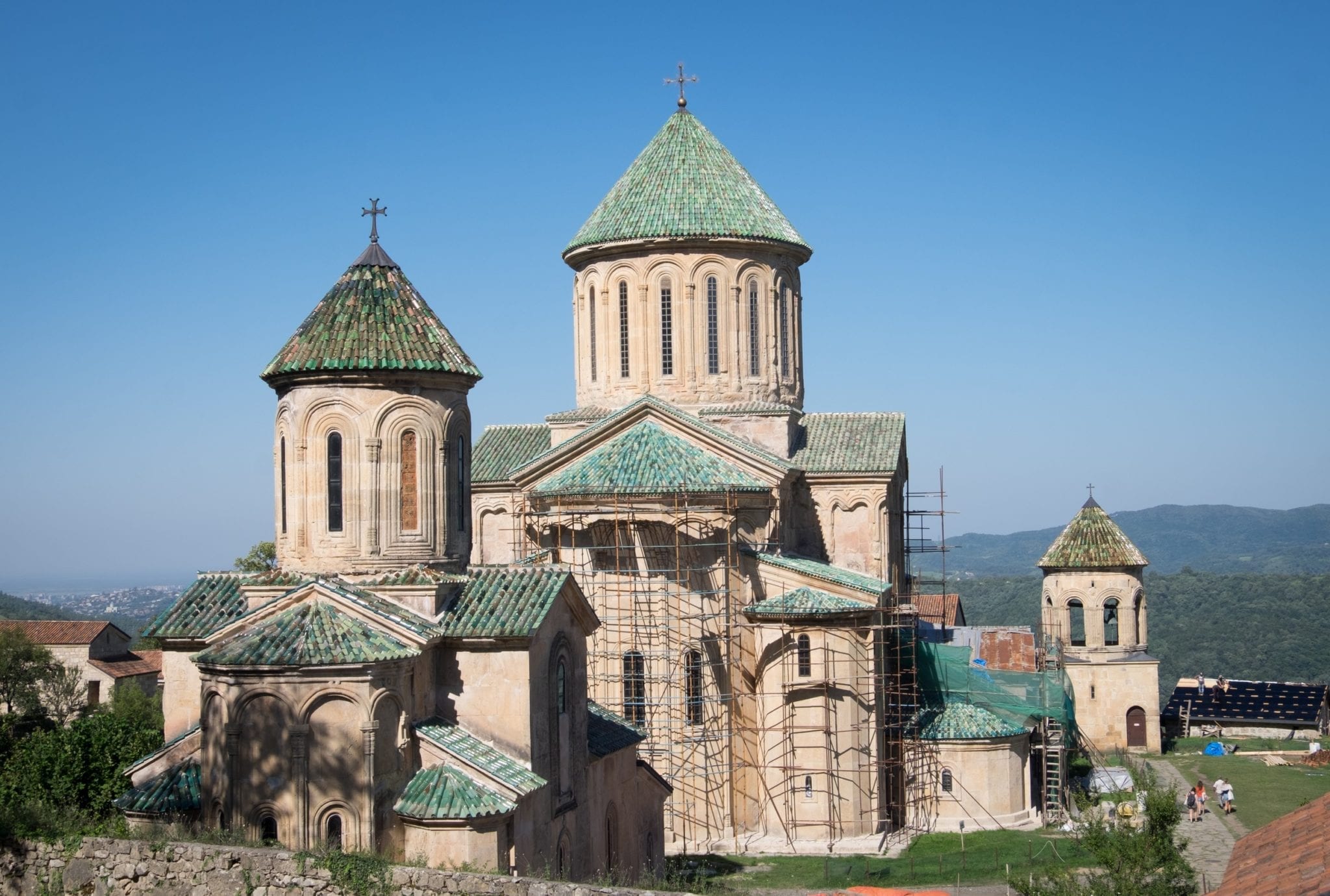
Gelati Monastery is just outside Kutaisi. It’s known for its architecture and design — and if you go, it has nice views over the hills.
“Founded in 1106 in the west of Georgia, the Monastery of Gelati is a masterpiece of the Golden Age of medieval Georgia, a period of political strength and economic growth between the 11th and 13th centuries. It is characterized by the facades of smoothly hewn large blocks, balanced proportions and blind arches for exterior decoration. The Gelati monastery, one of the largest medieval Orthodox monasteries, was also a centre of science and education and the Academy it housed was one of the most important centres of culture in ancient Georgia.” —UNESCO
The inside is a celebration of Georgian sacred art.
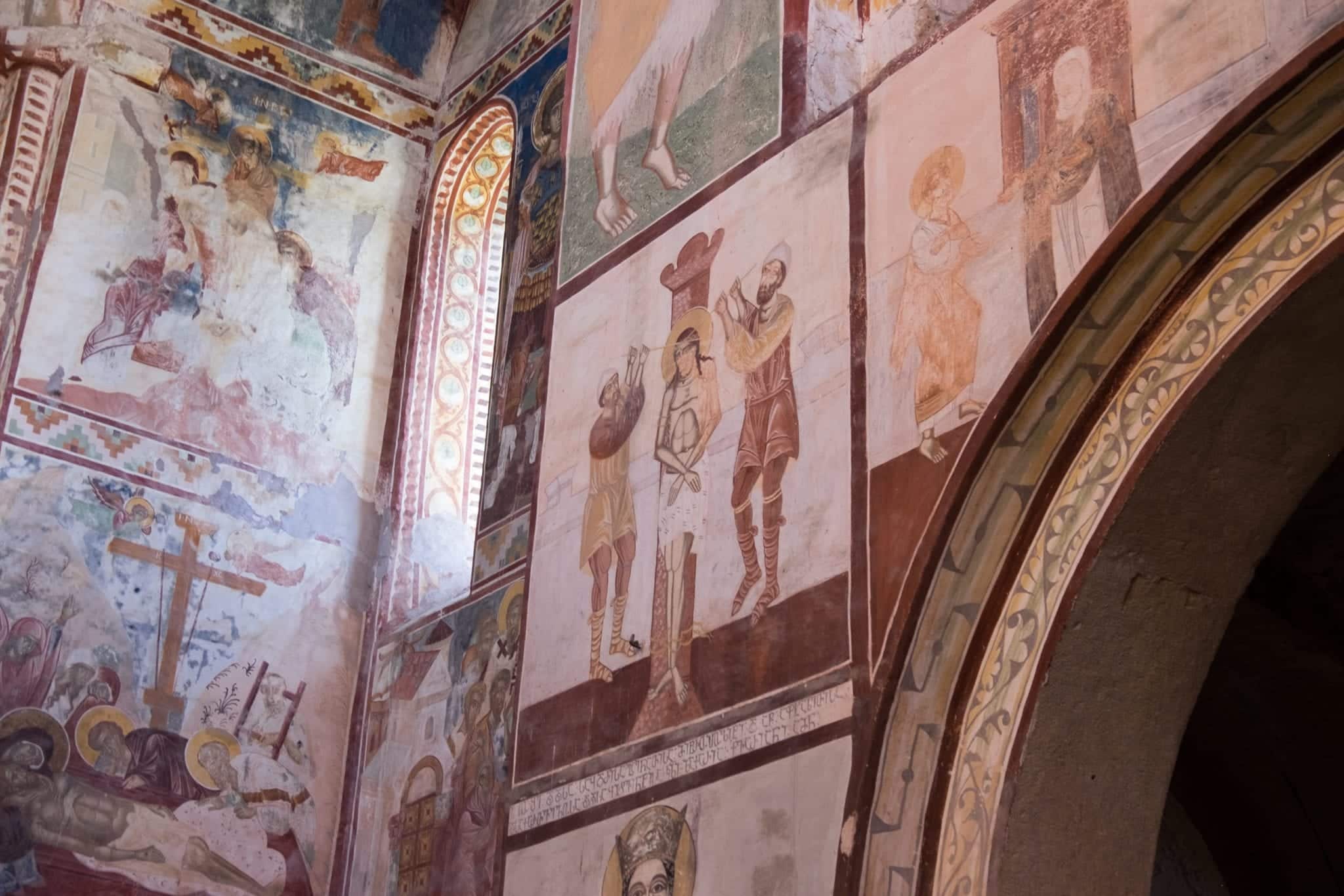
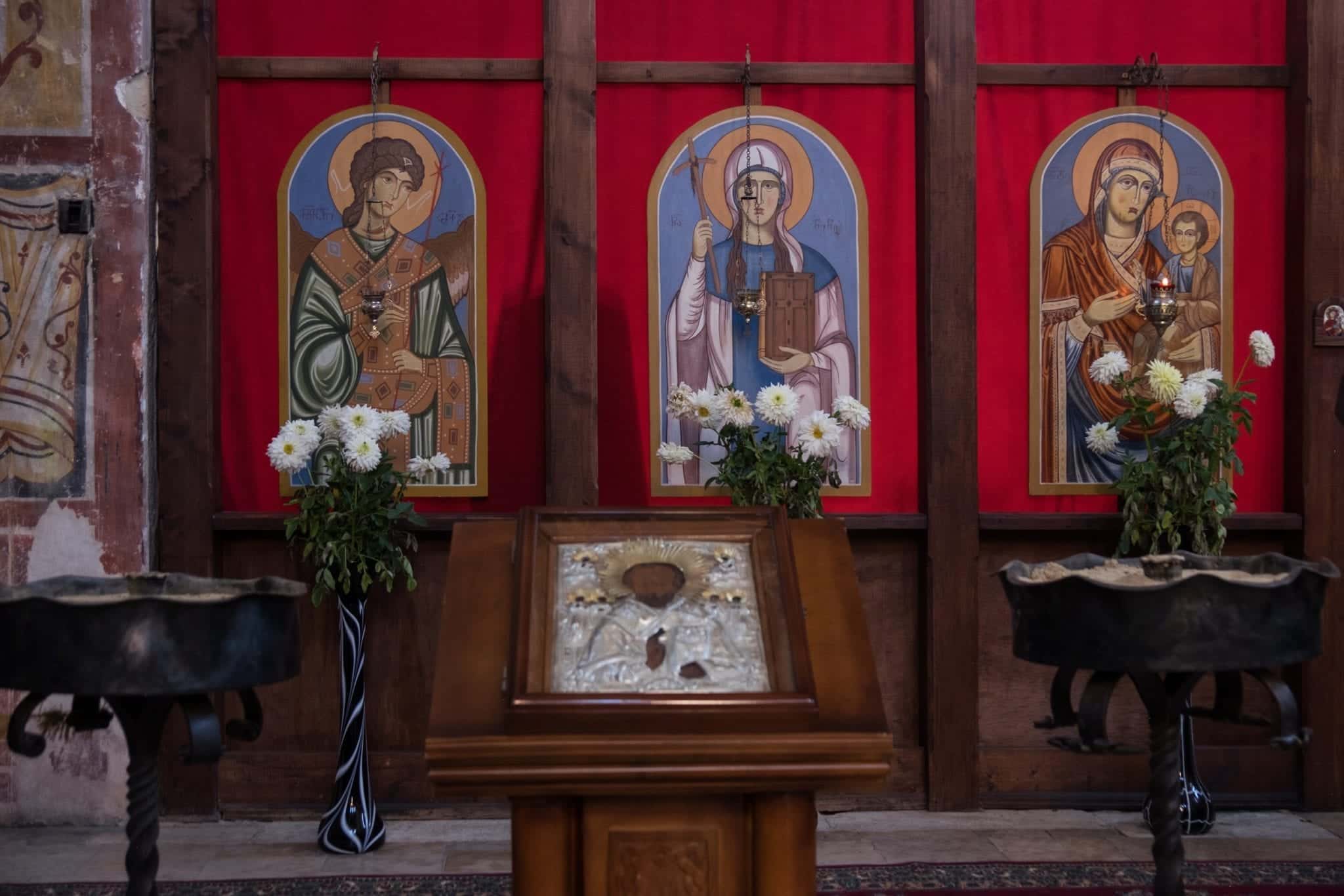
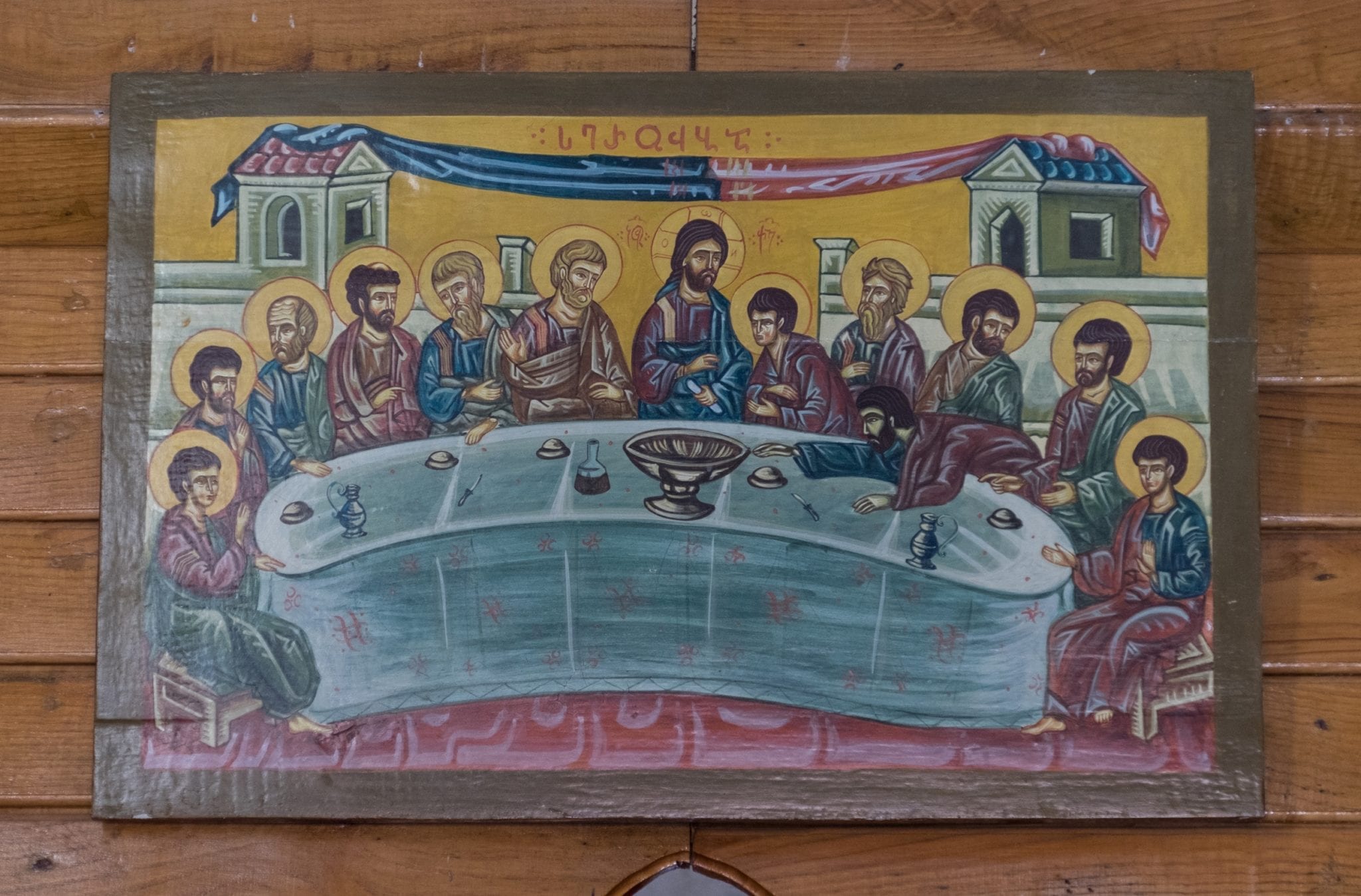
Is Kutaisi worth visiting as a city? While Gelati Monastery is lovely, Kutaisi isn’t the most exciting city around. I recommend spending half a day exploring Kutaisi and use the rest of your time exploring the surrounding areas, like the wineries of Imereti and Prometheus Cave. I had some great khinkali at a place called El-Depo.
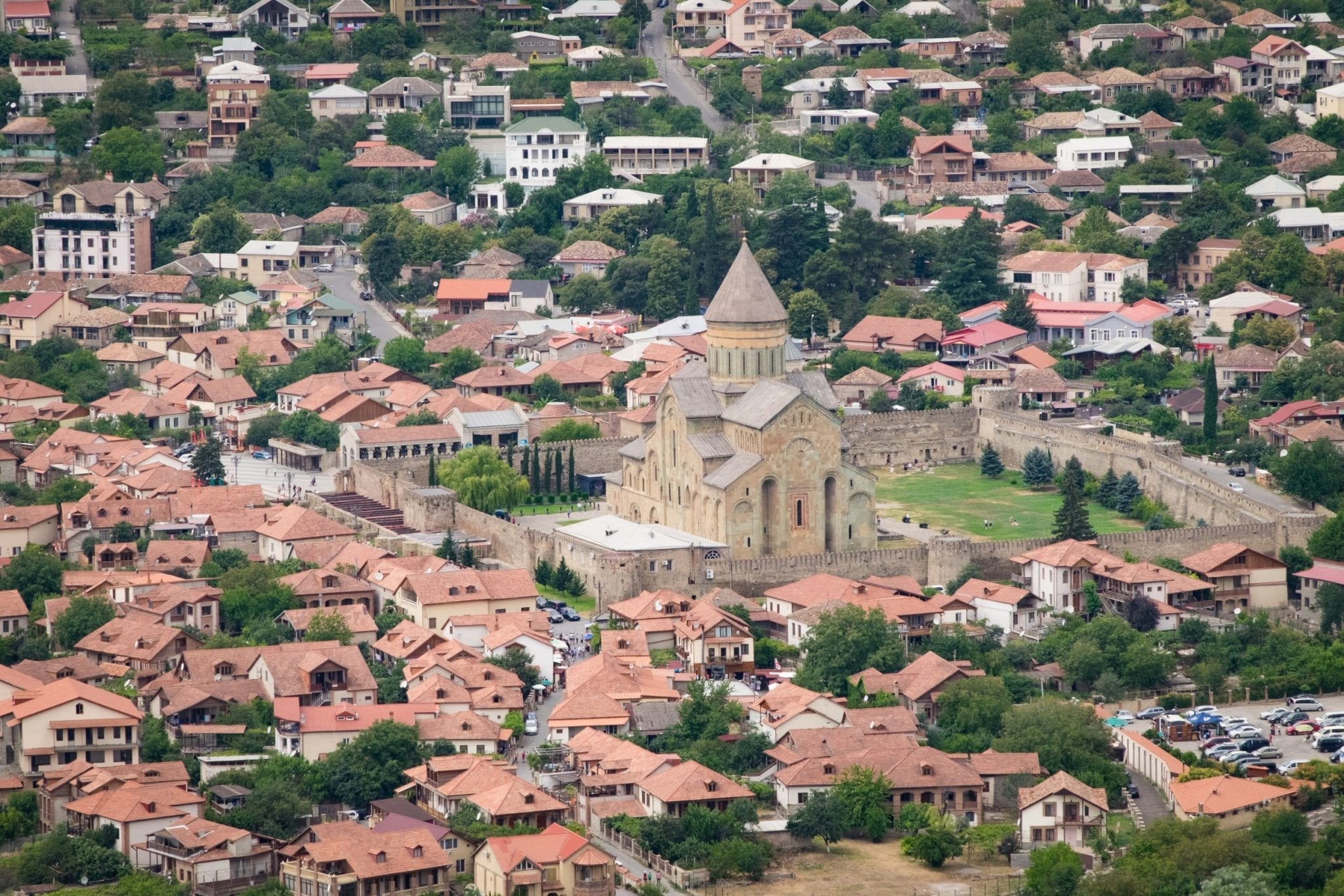
The city of Mtskheta is just outside Tbilisi and an easy day trip (or even just an afternoon day trip). Here you’ll find three monuments that together make up the UNESCO World Heritage-listed properties of Mtskheta: Jvari Monastery, Svetitstkhoveli Cathedral, and Samtavro Monastery.
“The historic churches of Mtskheta, former capital of Georgia, are outstanding examples of medieval religious architecture in the Caucasus. They show the high artistic and cultural level attained by this ancient kingdom.” —UNESCO
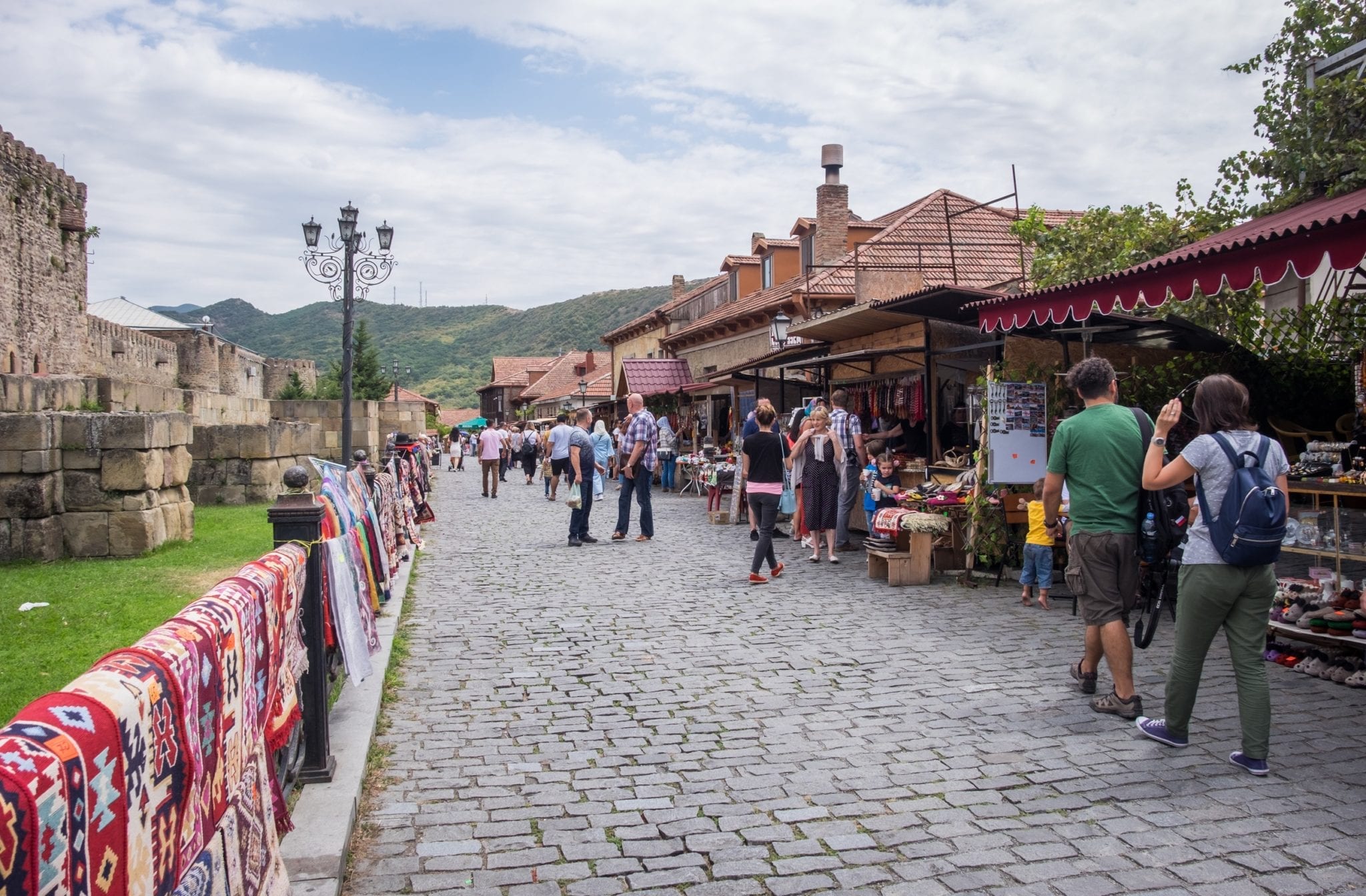
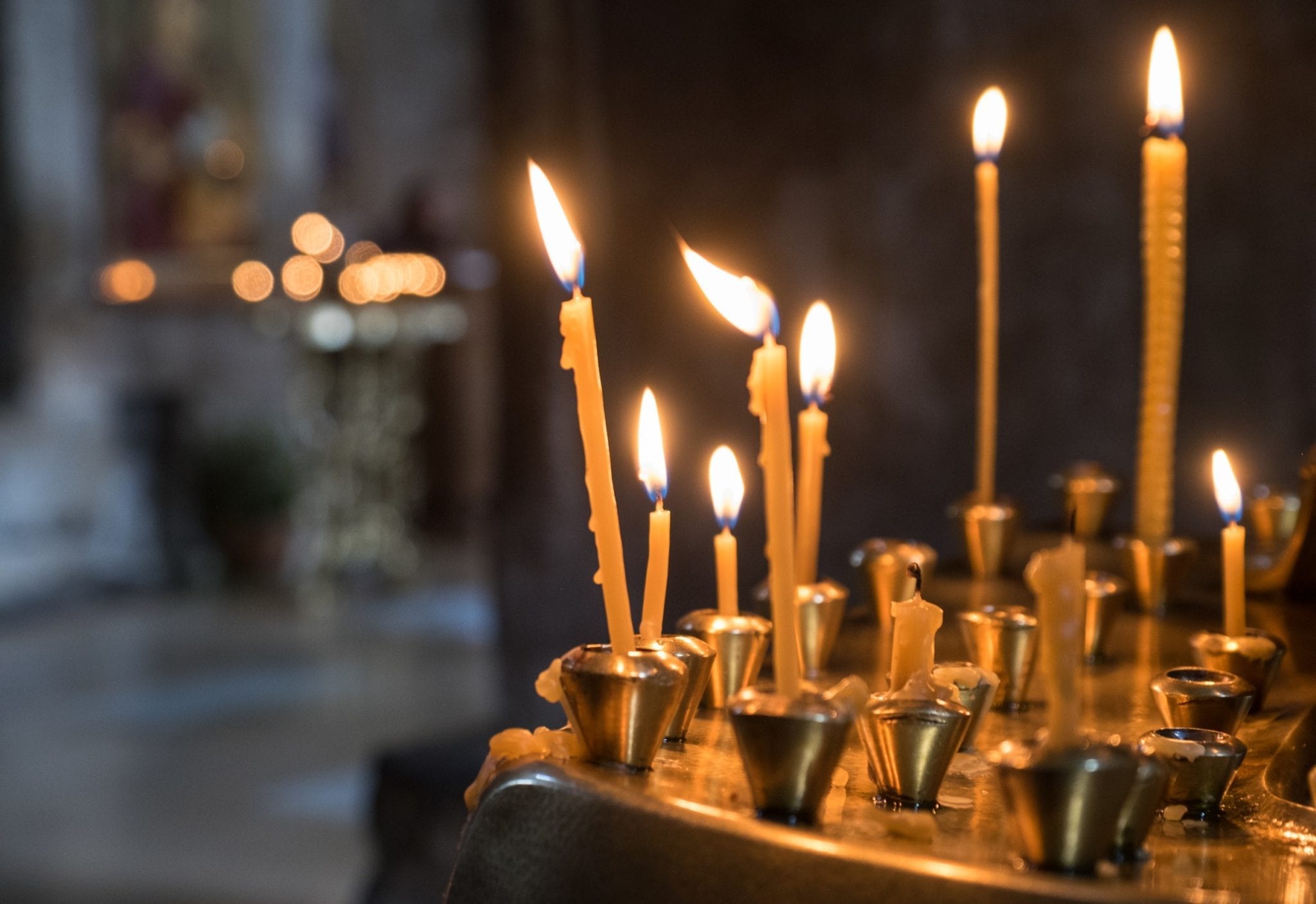
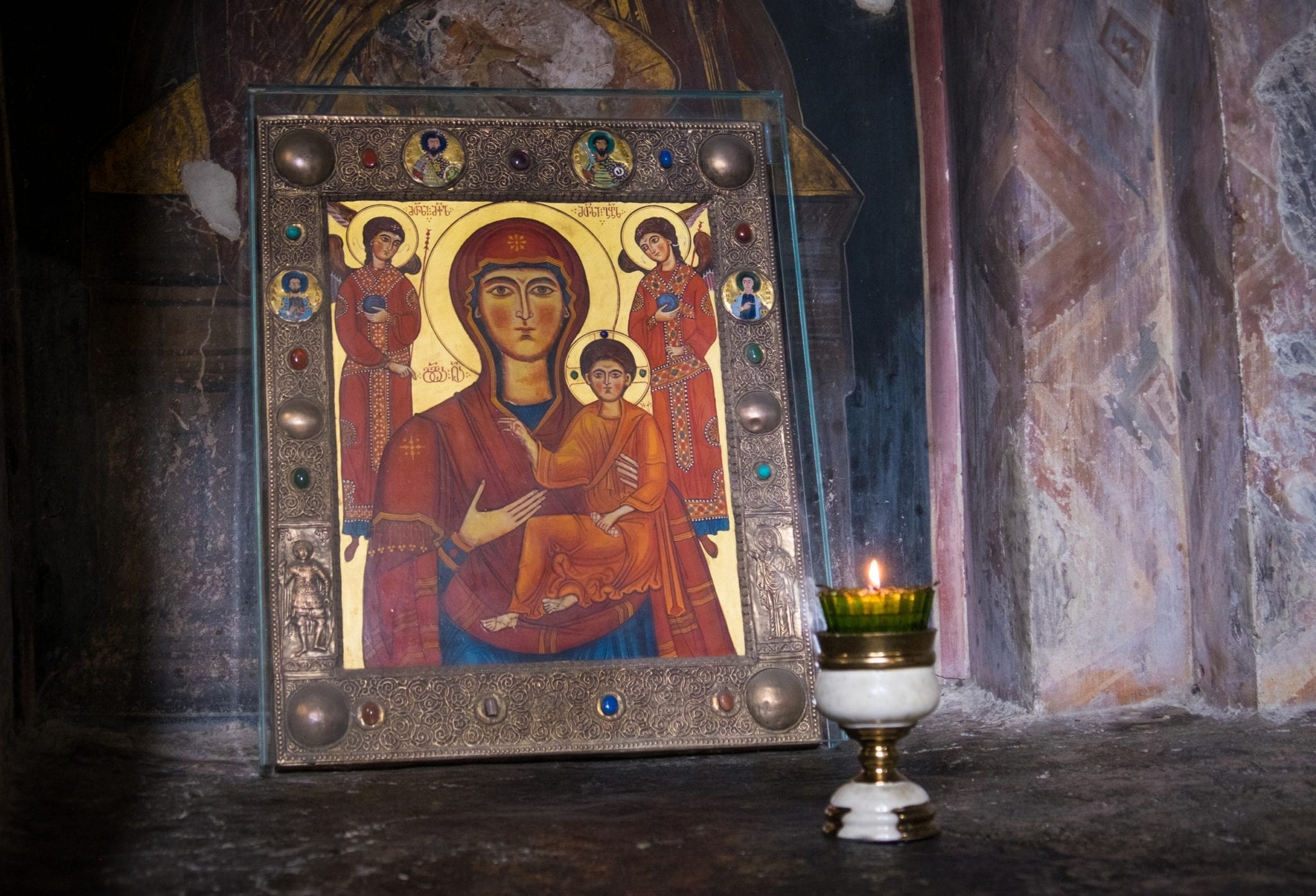
Mtskheta is a popular place for Tbilisi residents to get married. Keep your eyes out for bridal parties!
Georgia has 15 sites on the UNESCO tentative list — Davit Gareji Monastery, Tbilisi Historic District, Uplistsikhe Cave Town. Who knows what we’ll see added next?
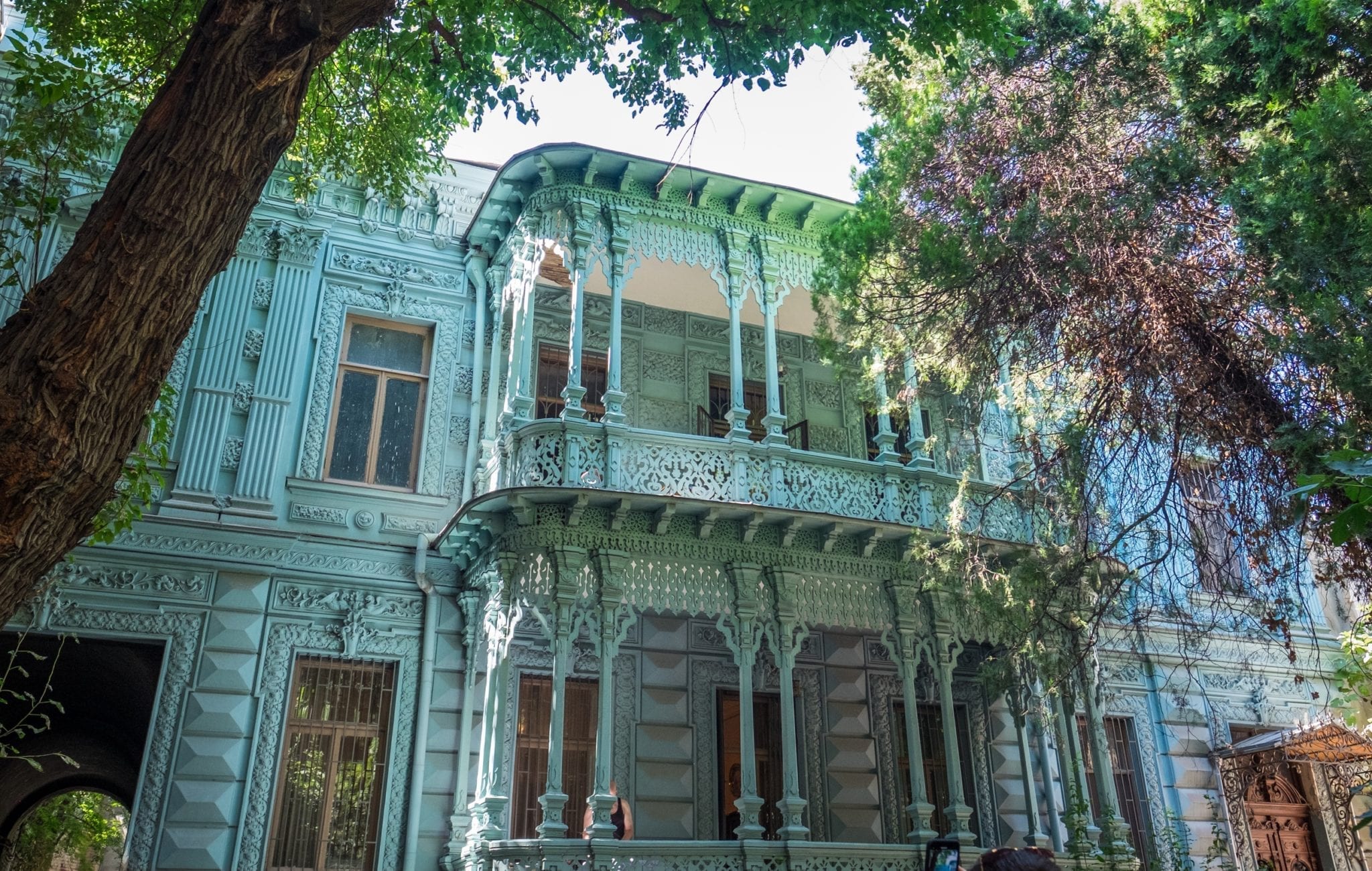
Georgia is CHEAP, CHEAP, CHEAP!
Georgia is a phenomenally budget-friendly destination. If you live simply in Georgia, pricing is similar to Eastern Europe and even some parts of Southeast Asia (!!). While the Caucasus region is budget-friendly in general, Georgia is cheaper than both Armenia and Azerbaijan.
If you’re traveling Georgia on a backpacker’s budget — hostels or simple guesthouses, mostly cheap meals and lots of khinkali, limited paid activities, transport via marshrutka — you can get by on as little as $30-40 per day.
If you’re going out to a nice dinner with wine, it would be tough to go more than $25 per person, and you could have a nice meal with wine for $10.
If you’re stopping in Tbilisi, you can stay at the high-end design hotel Communal Sololaki for $91 per night or one of the suites for $125 per night. Or head to Fabrika, the coworking space and hostel, where a nice double with a shared bathroom goes for $40 and a dorm room bed goes for $6. (You know when I last paid $6 for a dorm bed? Vietnam in 2011!!)
I was stunned at the cost of a flight from Mestia to Tbilisi on Vanilla Sky — just 90 GEL, or about $30 USD.
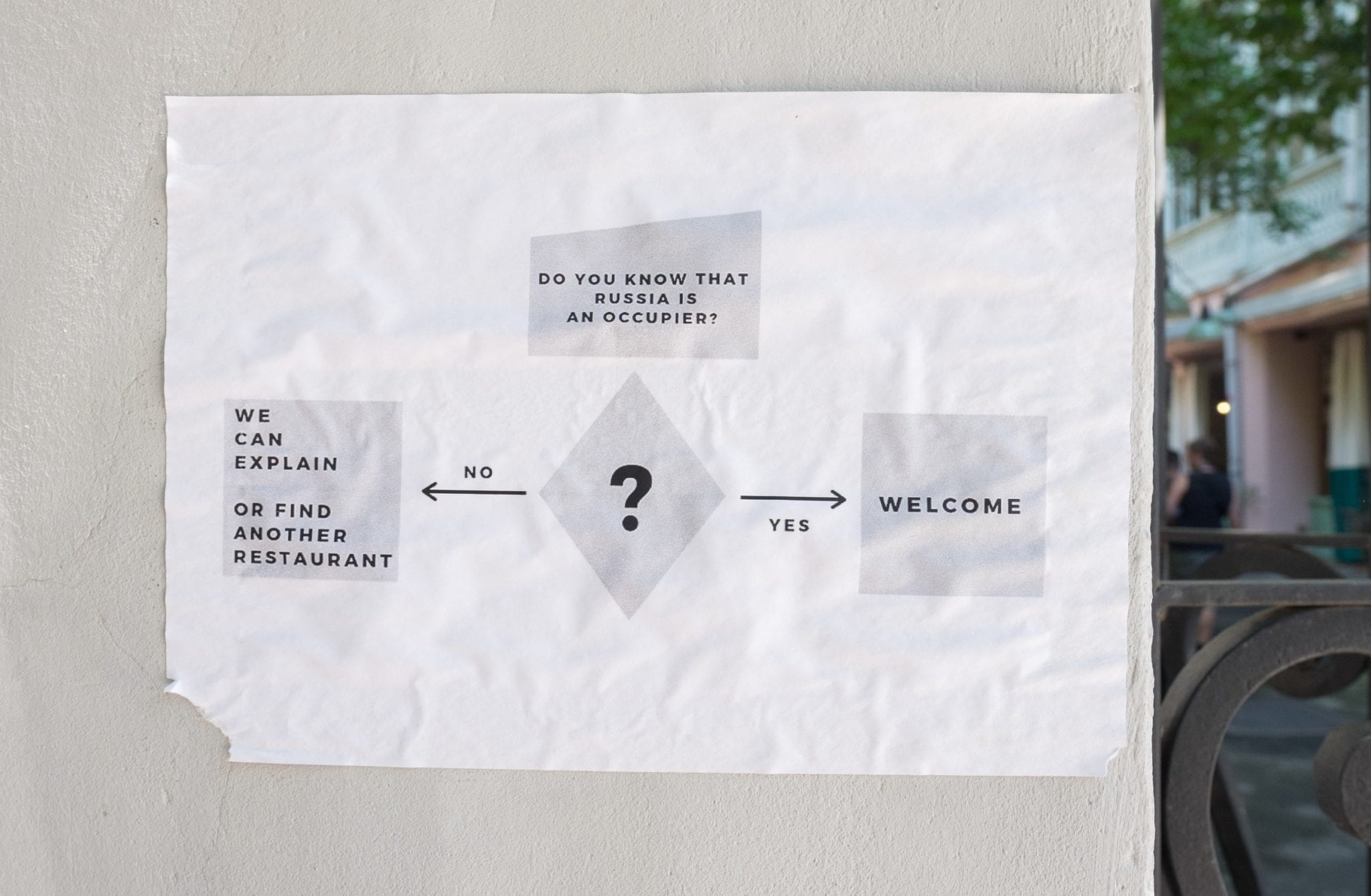
Georgia is occupied by Russia.
Not all of Georgia is accessible and open to tourists — there are two parts that are currently occupied, Abkhazia and South Ossetia. If you want to visit either of them, you’ll need to secure visas to these regions.
Abkhazia, a semi-autonomous region in Georgia’s northwest, has a long, complicated and sad history. It’s been in conflict with both Georgia and Russia since the 1920s, and things intensified when the Soviet Union disbanded. At one point the Abkhaz took part in expulsion and ethnic cleansing of Georgians. I recommend reading up on the conflict; it’s more than I can summarize here. Georgia contends today that Abkhazia is occupied by Russia.
Visiting Abkhazia is complicated — they get very few Western visitors. That said, this region does have some tourism value. It’s a popular spot for Russian travelers to enjoy the mountains and the Black Sea. My friend Megan has written a guide to traveling Abkhazia here.
South Ossetia, a region in north central Georgia, was invaded by Russia in 2008 — you may remember that news story continuously interrupting the Beijing Olympics. South Ossetia also requires special travel permits, but unlike Abkhazia, it doesn’t have much tourism value.
I have a Georgian friend from South Ossetia who lives in Tbilisi now, and he hasn’t gone back since the invasion.
Why do I mention this? It’s a sensitive subject for Georgians. Know that if you travel to Abkhazia or South Ossetia — particularly Abkhazia — Georgians may be furious with you. If you talk about these conflicts with Georgians, this is a time to listen more than you talk.
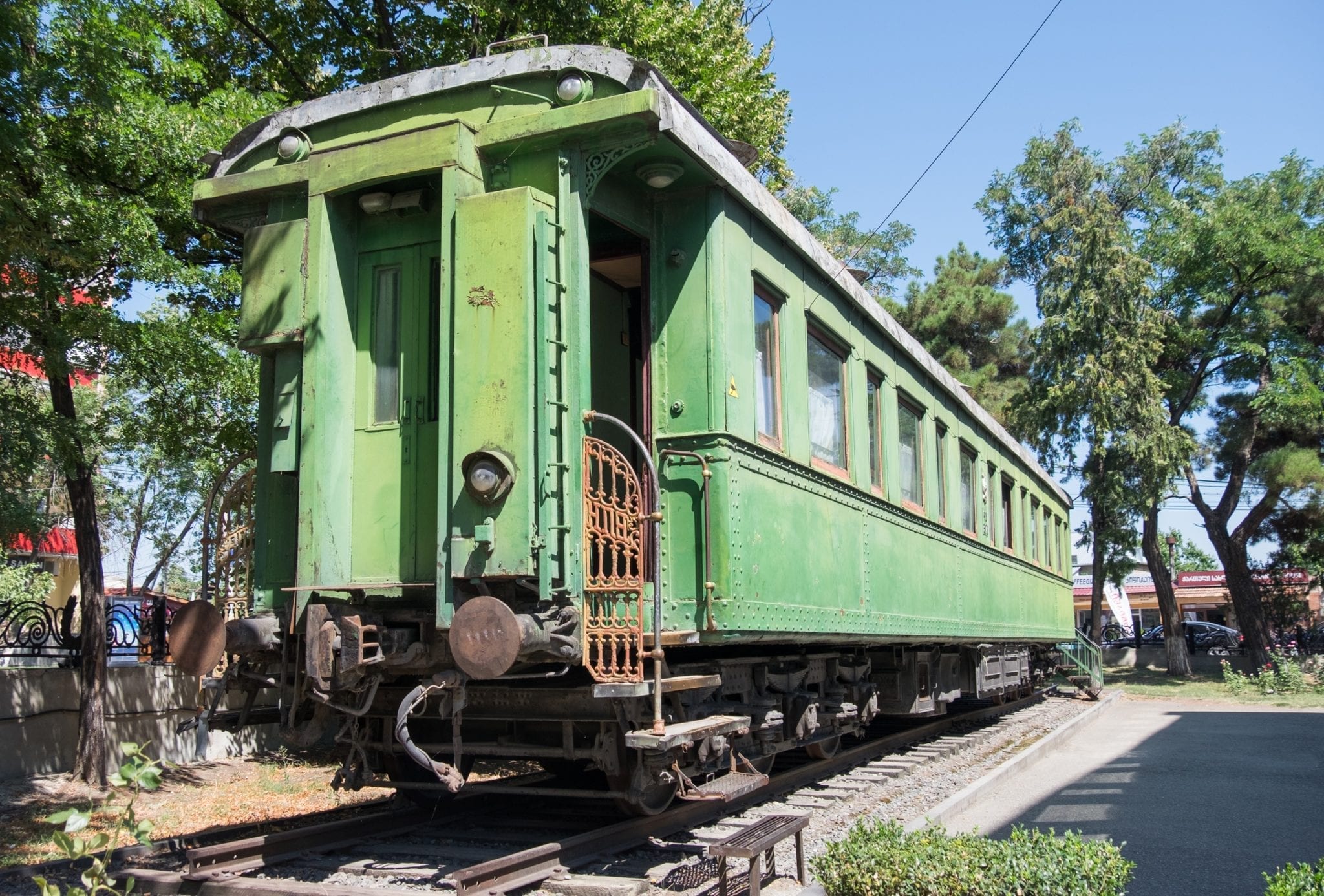
Georgian Quirks
I love a country that comes with its own set of quirks, and that’s definitely Georgia! Probably the most outlandish thing I did in Georgia was check out Stalin’s personal train in the city of Gori.
Most people assume that Stalin was Russian — but he was actually Georgian. Stalin was born in Gori in 1878 when Georgia was part of Russian Empire and came to power when the Soviet Union was founded in 1922.
Gori has gone a bit all in on Stalin — the train is part of a Stalin Museum and there’s a Stalin statue you can pose with. But most insane are the collections of souvenirs with that infamous “young hot Stalin” picture, where early 1900s Stalin could pass for a 2019 hipster. (Not including it here. You can Google it.)
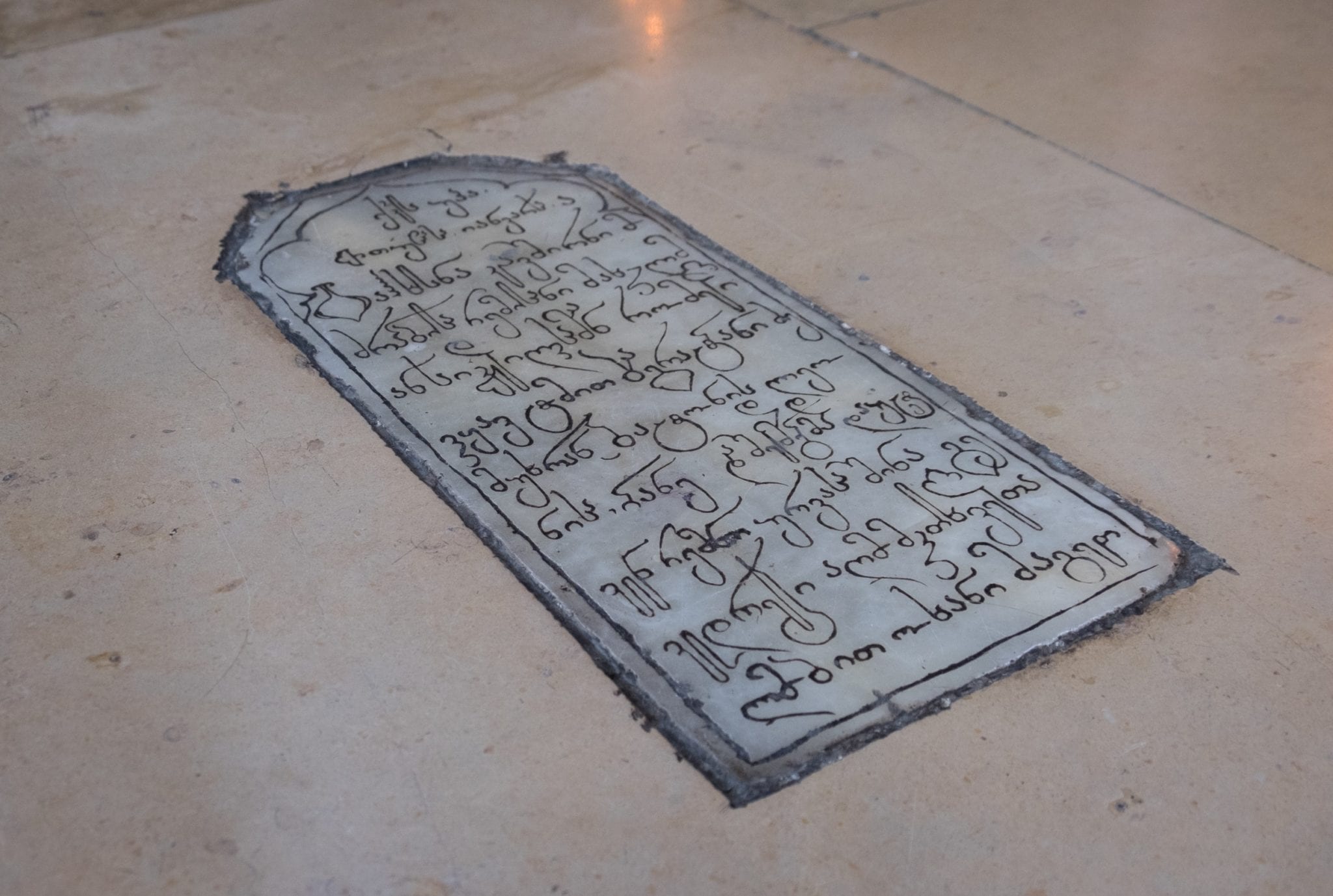
And the writing! I was in love with the Georgian script — so elegant and flowing and long and skinny.
If I were into tattoos and cultural appropriation, I’d probably end up getting inked with some Georgian script.
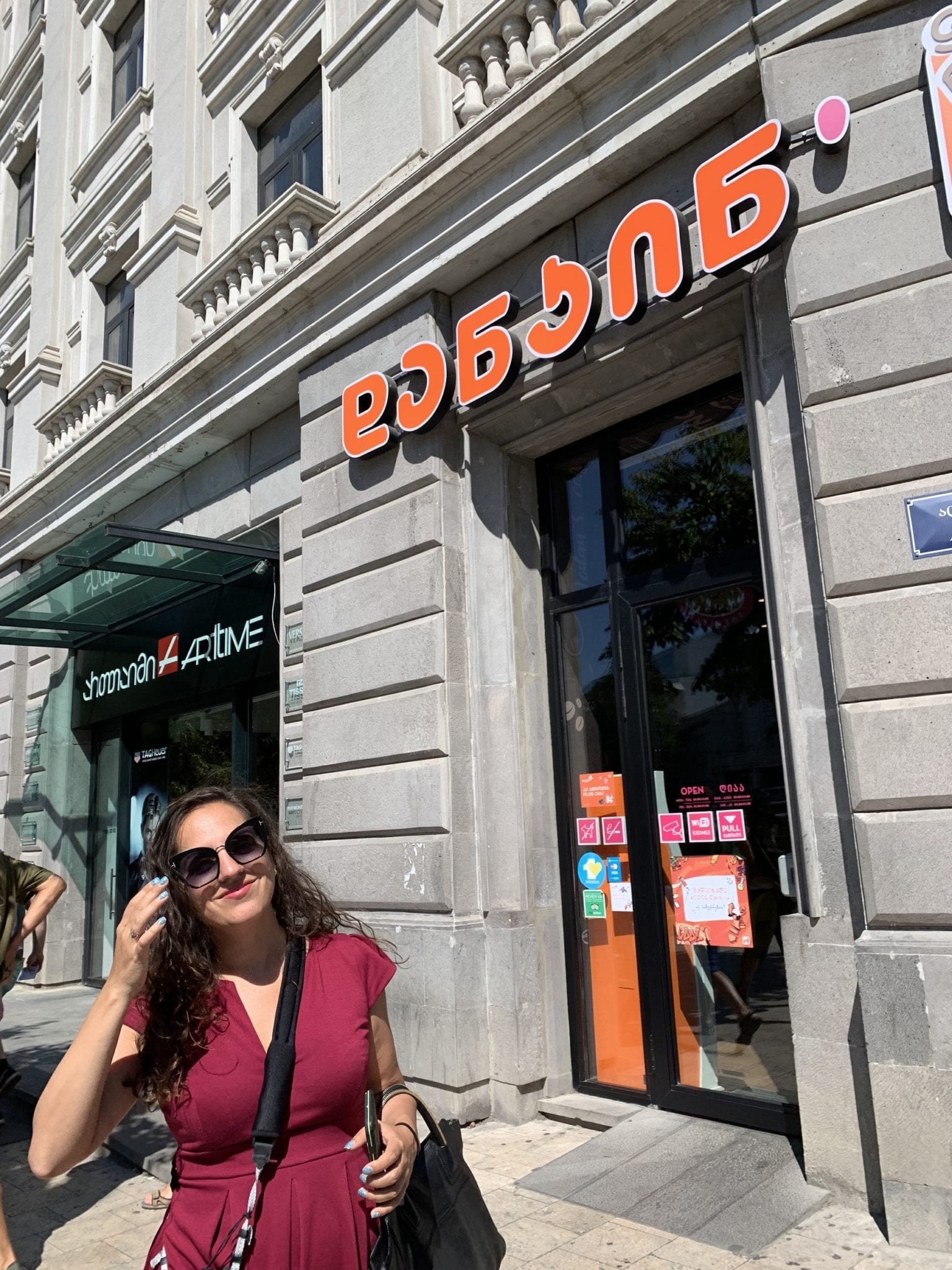
Georgia runs on Dunkin! Don’t you love that sign?
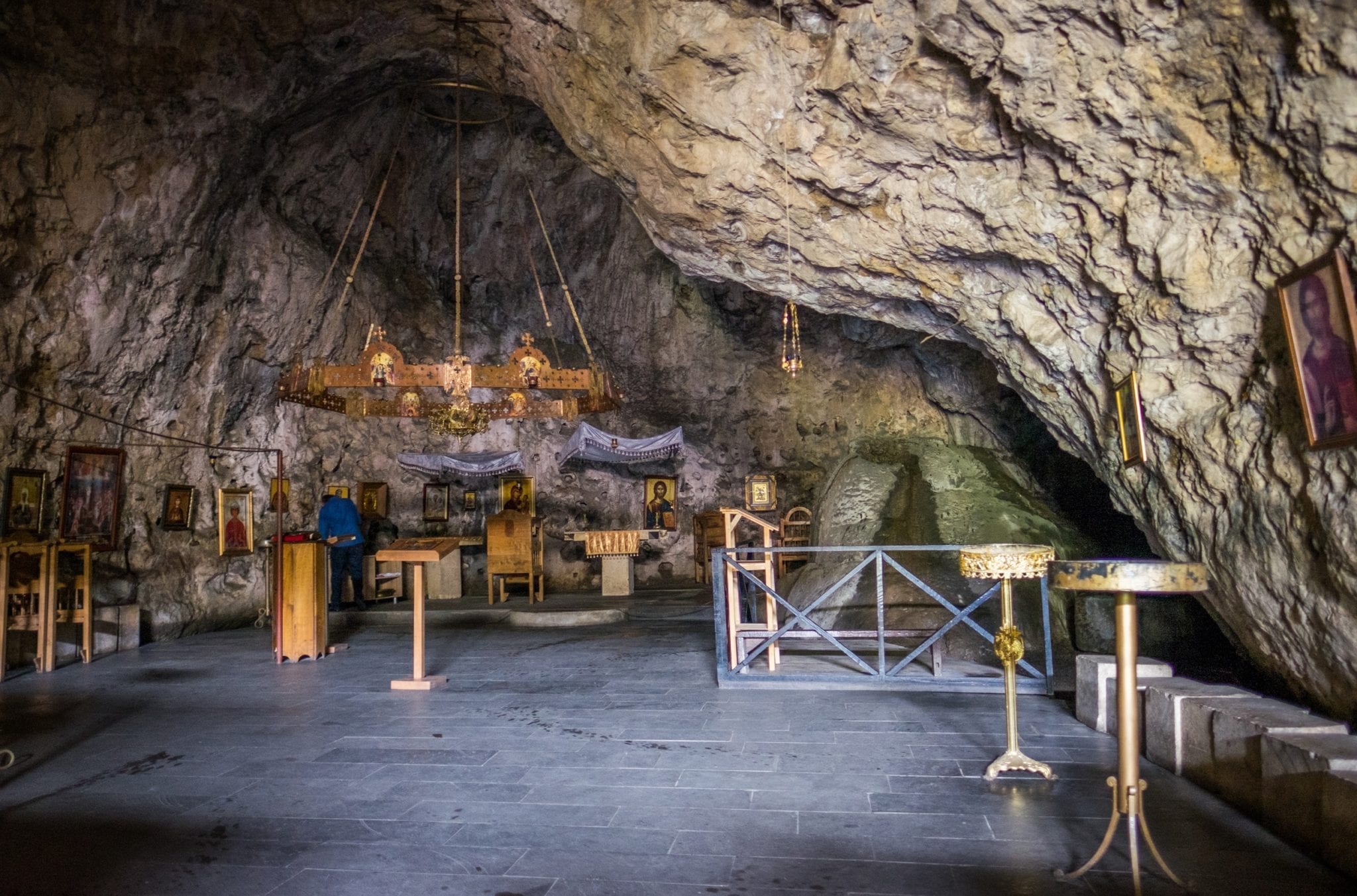
Georgia has some monasteries built into caves! This was a very cool monastery perched on a cliff in the town of Chiatura.
Georgian monasteries are strict about attire. Women need to cover their heads and wear a long skirt that covers their knees, even if they’re wearing pants. Monasteries will have baskets near the front with head coverings and tie-on skirts for women. Men wearing shorts will not be allowed in.
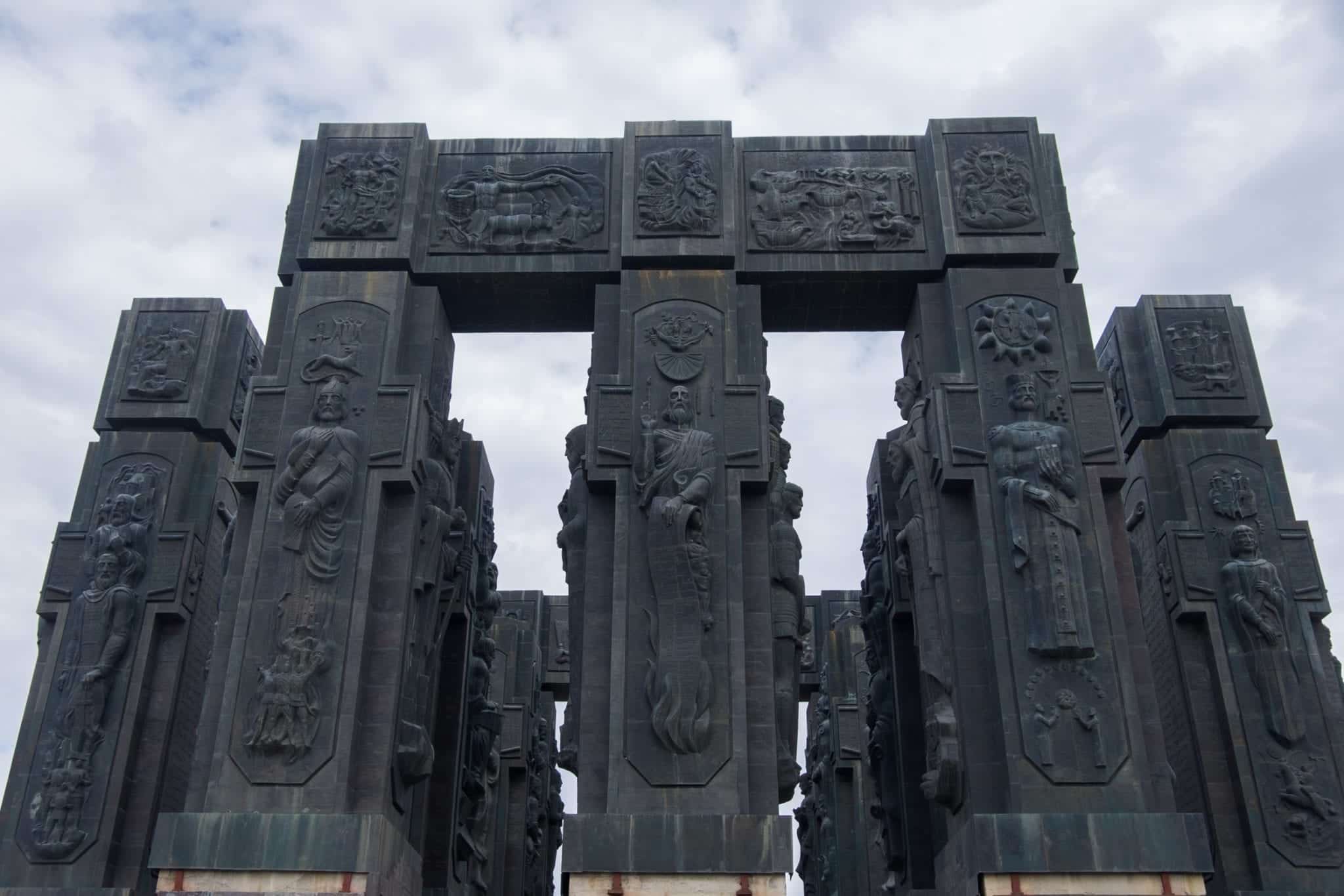
The Chronicles of Georgia are one of the stranger monuments in the country! It’s meant to look ancient, but it was built in 1985 and perched on the edge of the “Tbilisi Sea” (or the “Tbili-sea,” as my portmanteau-coining self called it.) It’s covered with images of Georgian historic figures and scenes from the Bible. I’m surprised we haven’t see it in a Marvel movie yet.
And if you’re as big an SNL fan as me, you’ll have “The Chronic!” “What?” “Cles of Geor-gi-a!” stuck in your head for the rest of the day.

And there was a very memorable meal in Mestia where the restaurant owner and his uncle took a shine to our group. They were blown away when they found out we came from so many countries — the US, UK, Australia, Italy, and Argentina. The nephew kept bringing us wine and chacha, a potent Georgian liquor; the uncle didn’t speak much English but loved saying, “Wow!” and singing James Brown’s “I Feel Good!”
The nephew gave Tom a glass of wine that was filled to the brim, then they drank their glasses in one go with their arms entwined, the Georgian way!
Then the uncle wanted to join in — they brought Tom another extremely full glass (!) and the uncle entwined his arm with Tom’s, downing the glass in less than ten seconds.
“Now kiss!” said the uncle.
“Wait, what?!” Tom exclaimed.
It’s normal, the nephew told him. In Svaneti they kiss on the cheek after sharing wine.
Tom obliged.
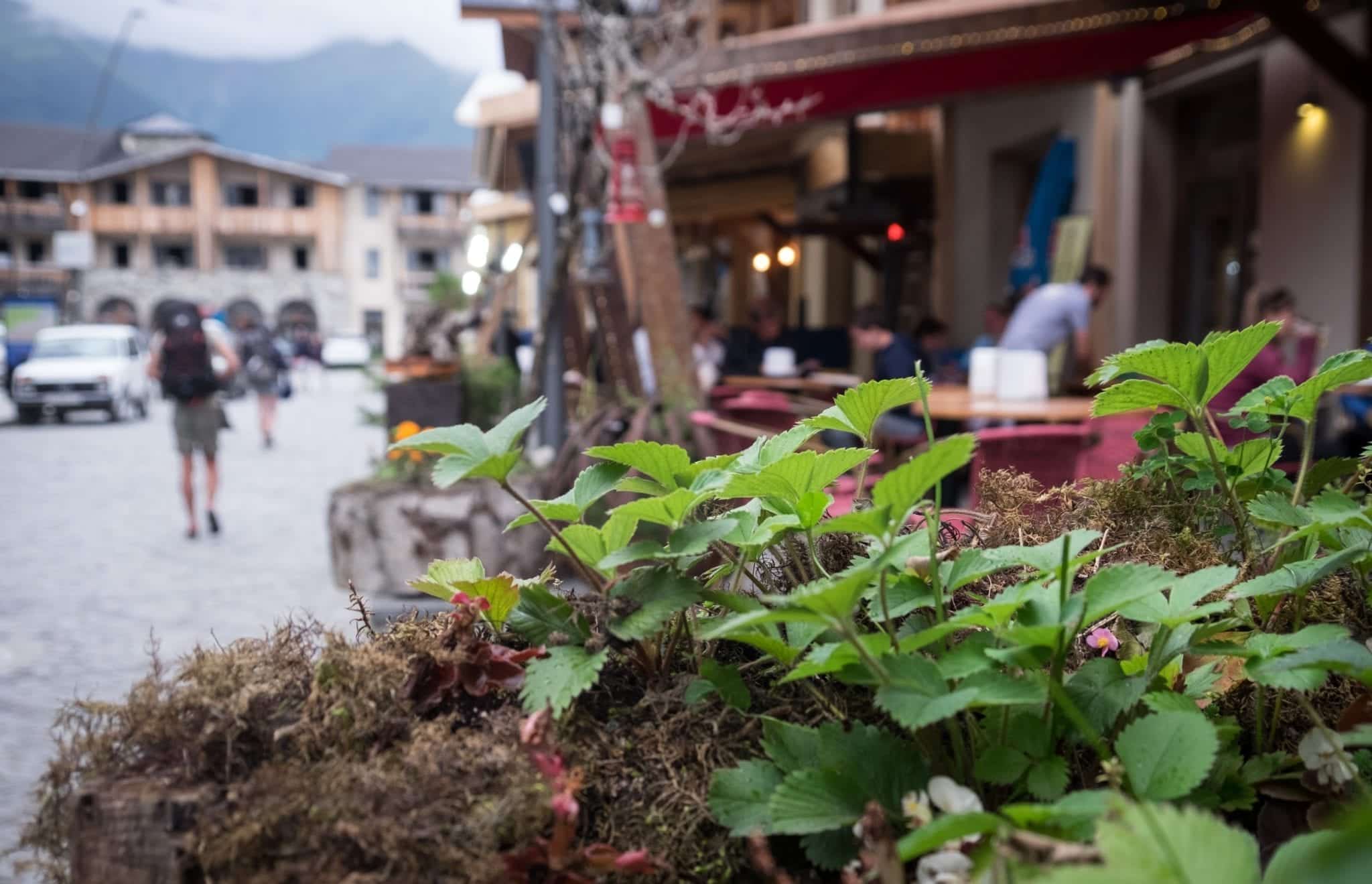
Is Georgia Safe?
Generally speaking, Georgia is a safe travel destination. Most travelers who do proper research in advance and use common sense will travel Georgia without any major safety issues. And when it comes to gun violence, Georgia is a thousand times safer than the United States.
The only aspect where I give pause is the driving. Georgians are very often reckless drivers, speeding and overtaking continuously. I recommend being extra cautious when crossing the street and always using your seat belt when riding in a vehicle.
While Abkhazia and South Ossetia are typically no-go destinations, the vast majority of Georgia travelers will not set foot in these regions.
As for solo female travelers, I traveled with a group of friends on this trip, so I don’t personally have solo female travel experience here. But judging by what I experienced, as well as what other trusted friends of mine have experienced, I see no reason not to travel Georgia alone. I would love to return and travel solo in Georgia.
As a developing country with limited travel infrastructure, I wouldn’t recommend Georgia for first-time solo female travelers or first-time international travelers unless you were traveling on a guided trip.
READ NEXT:
Top 10 Travel Safety Tips for Women
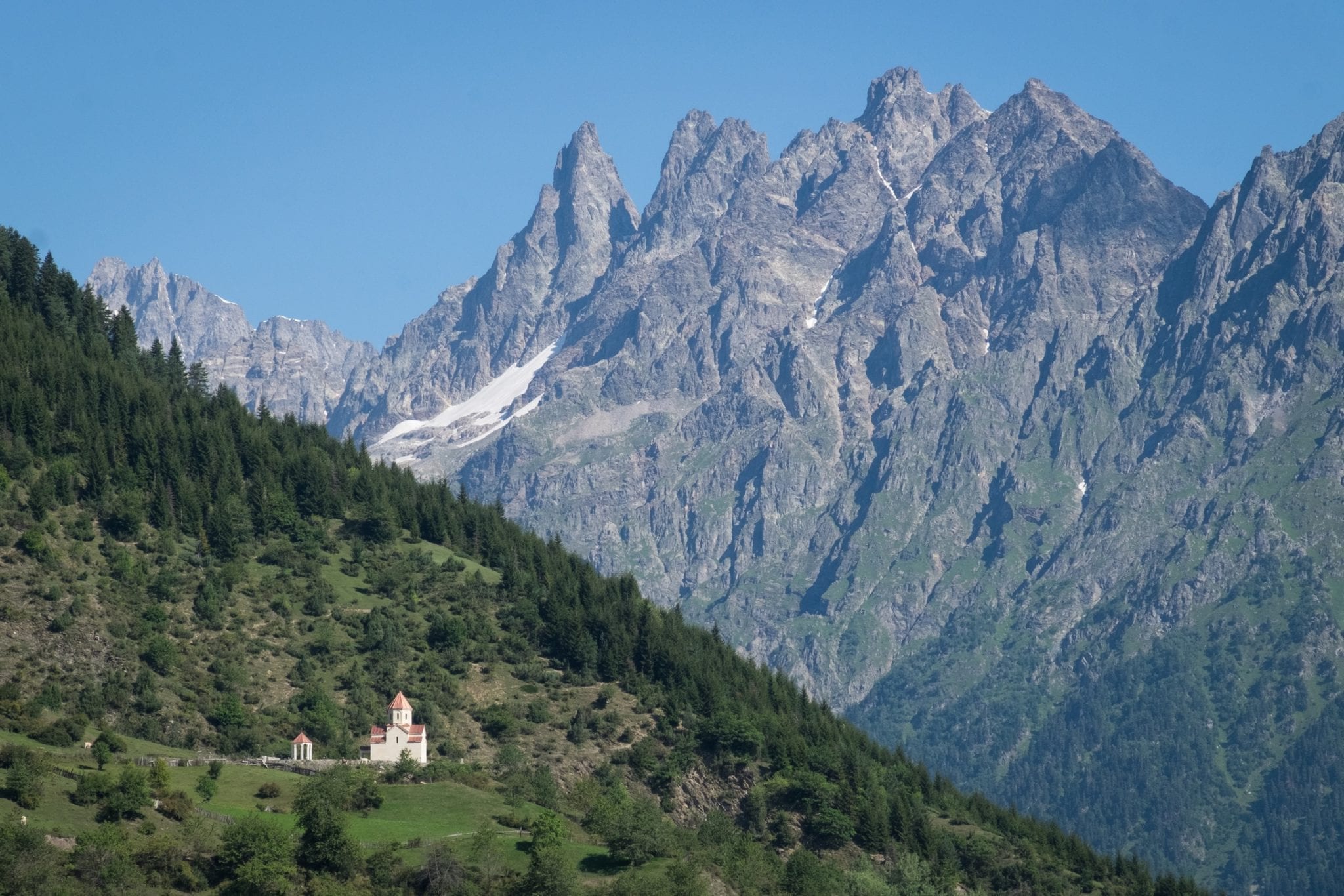
Cheap Flights to Georgia
One of the problems of Georgia travel is that Tbilisi is not a major air hub. If you’re flying into Tbilisi, you’ll likely connect through Istanbul, Kyiv, Doha, or another major city. Kyiv is a common stopover for Americans; I loved Kyiv and even got to visit Chernobyl! Flights can be pricey depending on the time of year and when you book. Skyscanner tends to find the best prices.
BUT — there’s a much cheaper option. Nowadays there are cheap flights to Georgia, but not to Tbilisi — to Kutaisi instead. The budget airline WizzAir has very cheap flights to Kutaisi from destinations all over Europe, including London Luton, Berlin, Prague, Copenhagen, Poznań, Barcelona, Tallinn, and many more.
Is it worth it to fly into Kutaisi? If you’re heading toward Svaneti, you absolutely should. It cuts down a few hours of the drive. You could explore in and around Kutaisi, travel on to Svaneti, take the Vanilla Sky flight back to Tbilisi, then take a marshrutka to Kutaisi for your flight out.
But even if you’re not traveling to Svaneti, if a cheap flight to Kutaisi shaves a few hundred dollars off your expected fare, why not do it?
If you’re flying from the US, I’d recommend pricing out two round-trip fares: one to a major European city, and another from that city to Kutaisi on WizzAir. Keep in mind that as they’re separate fares, you’ll be in trouble if one set of flights is delayed and you miss one. Give yourself a wide berth, and get travel insurance (I use and recommend World Nomads) just in case your luggage gets lost along the way.
I flew WizzAir from Kutaisi to London Luton. WizzAir is actually pretty decent if you fly “Wizz Go,” which includes a checked bag, carry-on bag, better seating options, and priority boarding. Hilariously, WizzAir is the only airline currently flying into Kutaisi Airport.
How cheap is cheap?
Price out the latest flights to Kutaisi and Tbilisi on Skyscanner.
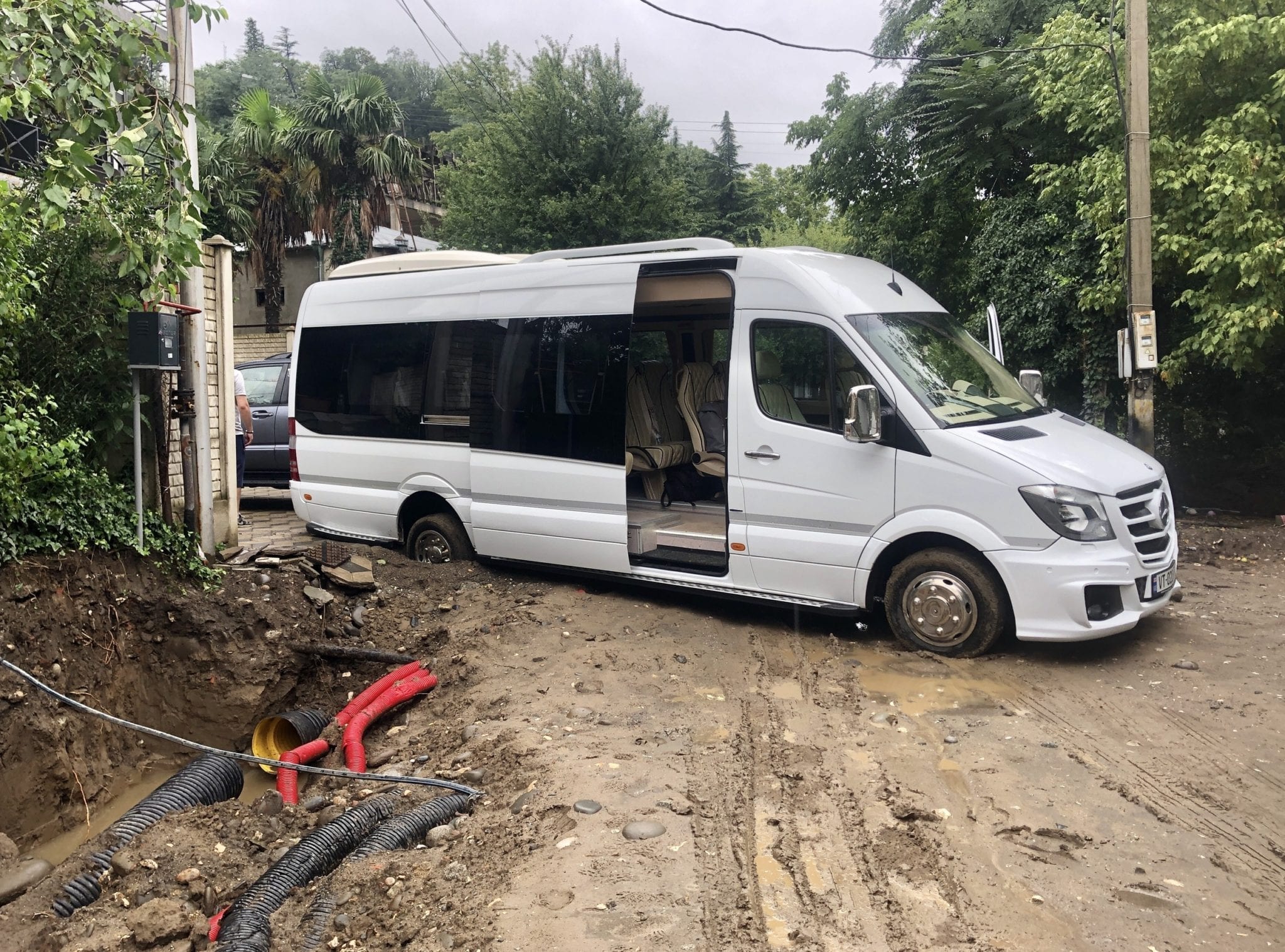
The Downsides of Traveling in Georgia
I’ll be honest with you — Georgia travel is still very rough in many ways. You should know this before you plan your trip. That picture above was when we arrived at our hotel in Kutaisi and found out that THE ENTIRE ROAD had been torn up, even sidewalks, and once it started raining, turned into a mud pit. Thankfully our driver was able to get the car out and JayWay moved us to another hotel for the trip back.
I found traveling in Georgia very similar to traveling in Albania. You can read about what travel in Albania is like here. In both countries, you’ve got limited and rough transportation, awful driving, poor road and sidewalk conditions, and limited information available on the internet.
Transportation in Georgia is rough. Most of the transportation between cities is via marshrutka, or shared minibus. While sometimes they can be comfortable, often they’re more akin to a chicken bus in Latin America, cramming in people and luggage. (Ask our friend Nate, who was given a child to hold on his lap on one marshrutka journey!)
There are a few trains in Georgia, but the only trains that make sense for tourists to take would be the one from Tbilisi to Batumi, and the one from Tbilisi to Zugdidi (if you wanted to catch a marshrutka to Svaneti), and the ones eastward into Azerbaijan or southward into Armenia.
There are very few domestic flights in Georgia — there’s a flight from Tbilisi to Batumi on Georgian Airways, and I actually got to fly the route from Mestia to Tbilisi on Vanilla Sky Airlines. You can’t book Vanilla Sky online — you need a travel agent to go to the office in Tbilisi.
But if you travel with JayWay Travel, as we did, transportation is much more comfortable — we had private drivers for the whole time in Georgia and they booked my Vanilla Sky flight for me so all I had to do was show up.
Not a lot of businesses have much of an internet presence. This made it especially hard to do things like check restaurant menus in advance. Most restaurants, bars, and cafes tended to have a Facebook page rather than a website.
Most significantly, the driving in Georgia is horrific. I’ve seen a lot of bad driving around the world, and while I’m convinced that the Maltese are the most reckless drivers in the world, the Georgians aren’t far behind them. You see a lot of speeding and overtaking while driving into oncoming traffic. If you hail a taxi in Tbilisi, it isn’t unusual for drivers to smoke out the window and talk on the phone constantly. Also, 40% of the cars have the steering wheel on the wrong side.
I would not recommend the vast majority of travelers rent a car in Georgia. You should only drive here if you’re a highly skilled driver who thrives on adrenaline.
Finally, I would not recommend Georgia to travelers with mobility issues. The roads and especially sidewalks are uneven and torn up — very difficult to get around, and nearly impossible if you use a wheelchair.
Ordinarily, I would say that Georgia is best for travelers who are accustomed to traveling in developing countries. BUT — if you’re not, traveling with JayWay Travel makes it so much easier to travel in a developing country.
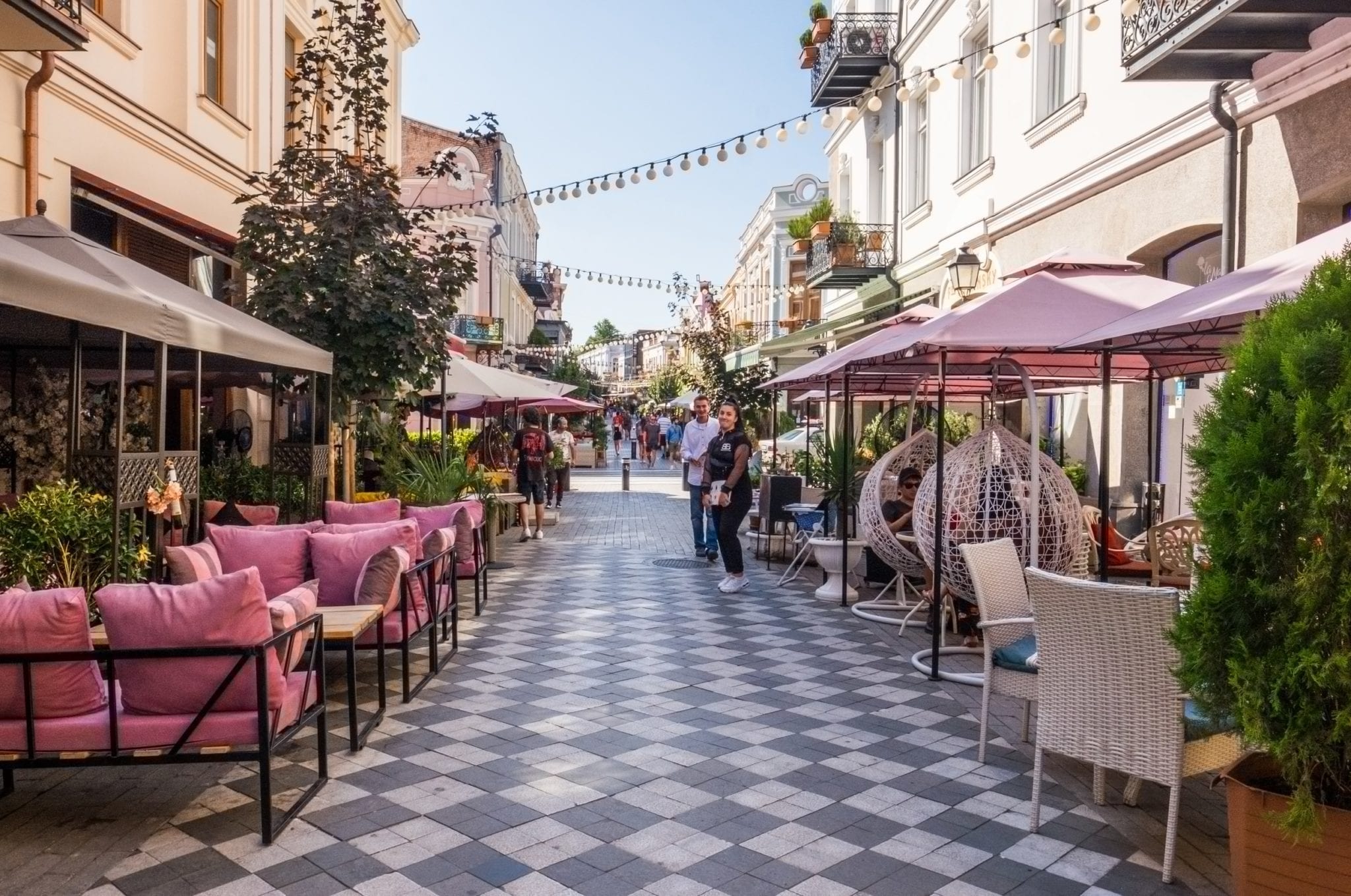
Travel to Georgia with JayWay Travel
I traveled on this Georgia trip as a guest of JayWay Travel, a bespoke travel agency specializing in Central and Eastern Europe. I’ve worked with JayWay Travel for trips to Ukraine and the Caucasus, and both were great trips. JayWay added Georgia as a destination in 2018.
JayWay builds custom trips to destinations and organizes your trip in full, arranging hotels, transportation, special experiences, and guides along the way. They also give you a SIM card or even a cell phone so you can stay in touch easily.
Not all travelers need that amount of trip planning — but the best thing that JayWay does is make developing countries easier to handle. For example, their drivers are so much better than typical Georgian drivers. You don’t have to deal with a driver who constantly smokes out the window — JayWay’s drivers have much nicer vehicles and take their jobs seriously.
JayWay also sets you up with excellent local guides throughout your trip, including a contact in Georgia who runs your trip. Gio is JayWay’s man in Tbilisi, and he doubled as tour leader for our trip. With Gio, you’ll be in excellent hands!
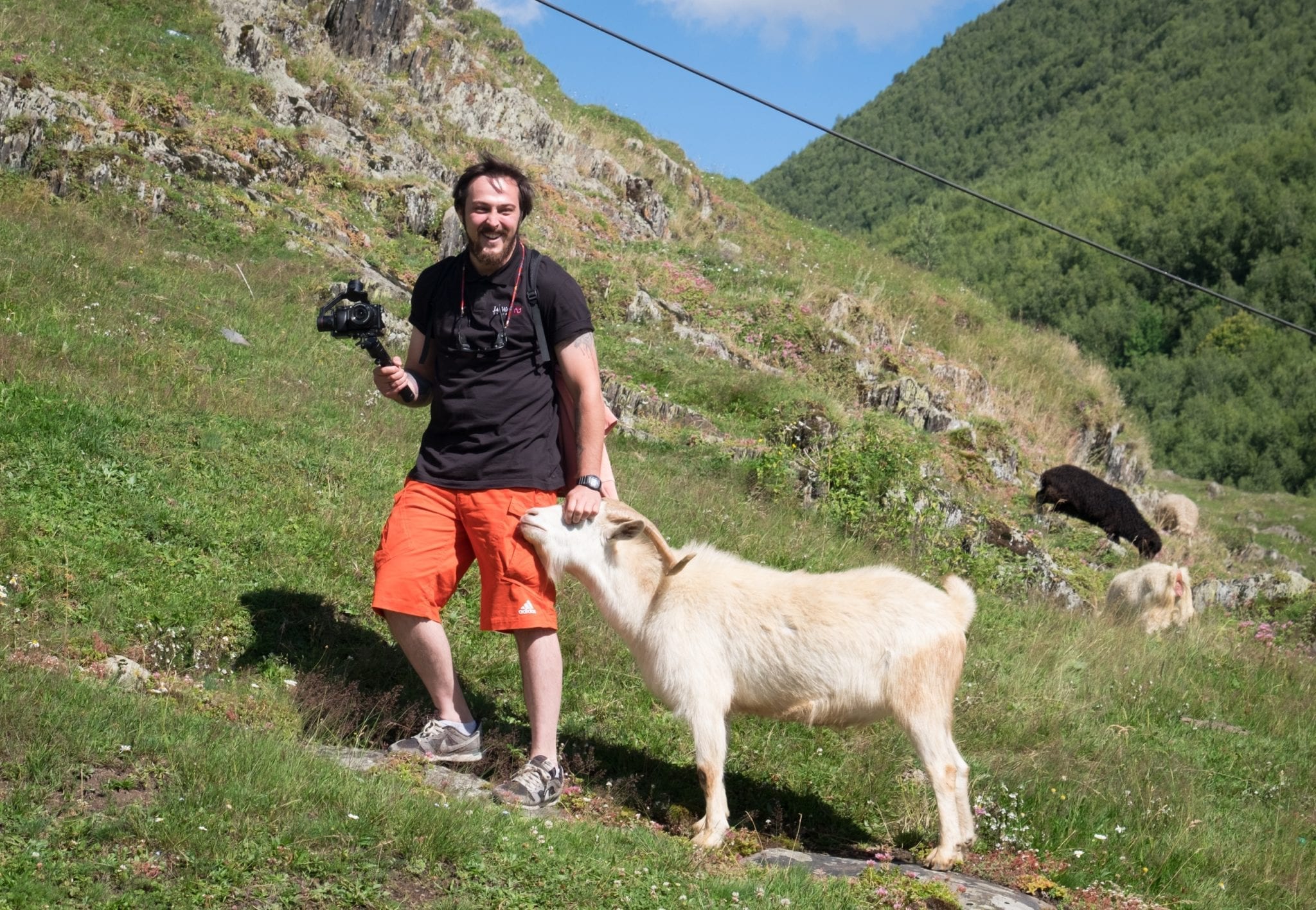
Meet Gio: guide, storyteller, urban explorer, videographer, goat whisperer.
The guides handle so much of the day-to-day in Georgia. They’re accustomed to what Americans expect for customer service (and Georgia really isn’t there yet in terms of service). They can also add more into your trip: we had a few hours of downtime in Tbilisi between flights from Mestia to Yerevan, so they added in a short Mtskheta tour.
We had a few other short-term guides on our trips: Nata taught us about all things Svaneti; Luca took us around the best of Mtskheta, and George took us to his favorite bakery en route from Tbilisi to Kutaisi.
Some of the other advantages of traveling to Georgia with JayWay: they handle things like getting tickets on Vanilla Sky airlines, which is complicated to do if you’re out of the country. When we found out the entire road was torn up in front of the Kutaisi hotel, they switched us to another hotel mid-trip (the hotel was reportedly angry about this, so I’m glad I didn’t have to deal with this myself). And when I got sick, they got me to a pharmacy.
Let me put it this way — my parents are in their sixties and seventies, and while they both have travel experience, it’s almost always been in developed countries. I wouldn’t feel comfortable with them traveling in Georgia independently, but I would feel very comfortable if they were traveling Georgia with JayWay.
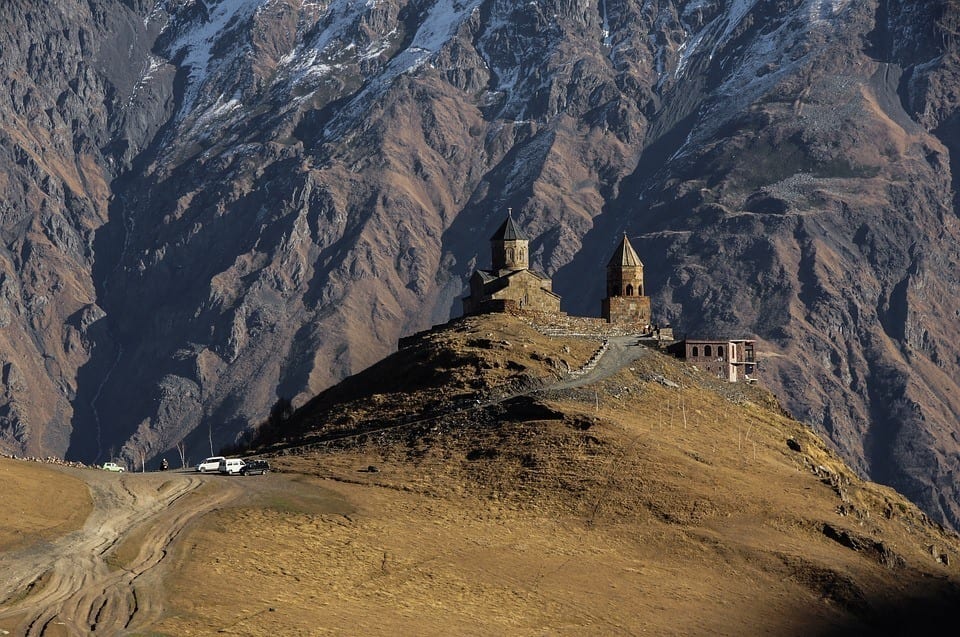
Where Else to Go in Georgia
This is by no means a comprehensive trip to Georgia — there are so many wonderful places that I didn’t visit. Most Georgia travelers don’t take the time to go to Svaneti, and by spending my time there, I missed out on some traditional Georgian destinations.
If you want to immerse yourself in vineyards and wineries, head east to the Kakheti wine region and towns like Telavi and Sighnaghi.
If you want some beach action and nightlife, head west to the Black Sea and the resort town of Batumi.
If you want to be in the mountains but don’t have time for the journey to Svaneti, head to Kazbegi, pictured above, just a few hours from Tbilisi.
If you’re looking for an unusual and visually stunning monastery, Davit Gareja is worth a visit.
This is just the beginning — there are plenty more places to explore!
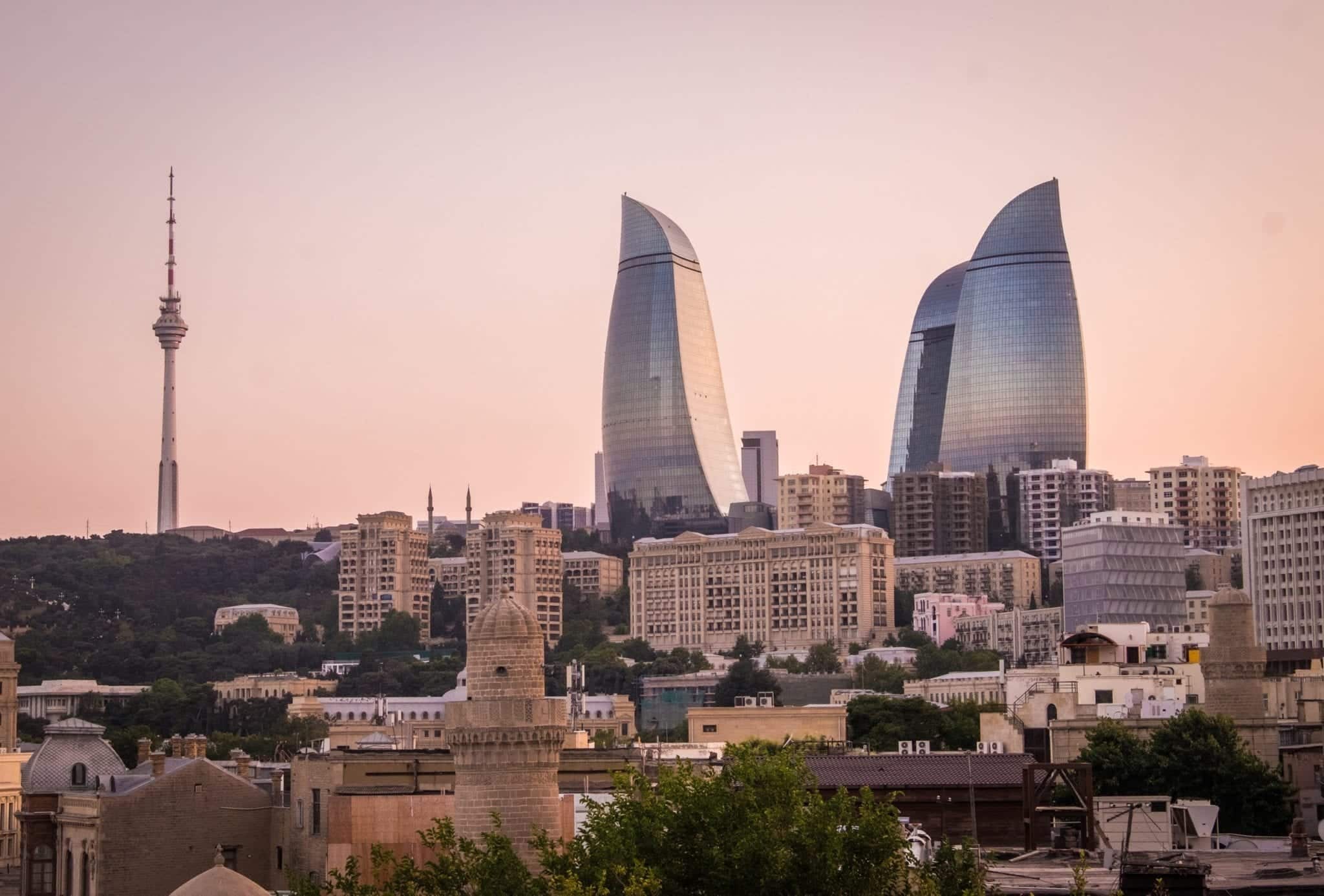
Traveling in the Caucasus
If you have enough time, I recommend traveling to all three countries of the Caucasus at once. They’re so isolated and tough to get to that this can save you a lot of time. I would only do this if you have a good amount of travel time and are willing to sacrifice more time in Georgia to see Armenia and Azerbaijan.
If you have at least two weeks, you can fit in some highlights of all three countries. If you have ten days, I would primarily base in Georgia with a few days in Armenia and would exclude Azerbaijan. If you have a week or less, spend it all in Georgia. (That being said, if you have two weeks and decide to spend it all in Georgia, that would still be time very well spent.) JayWay puts together custom itineraries; here’s a three-country sample itinerary.
With limited time in Armenia, I would base in Yerevan and do day trips to monasteries: I’d prioritize Khor Virap, Nora Vank, and the Areni wine region. You could also visit Lake Sevan or Dilijan. With limited time in Azerbaijan, I would base in Baku and do a half-day trip to Qobustan.
READ MORE:
What’s It Like to Travel to Baku, Azerbaijan?
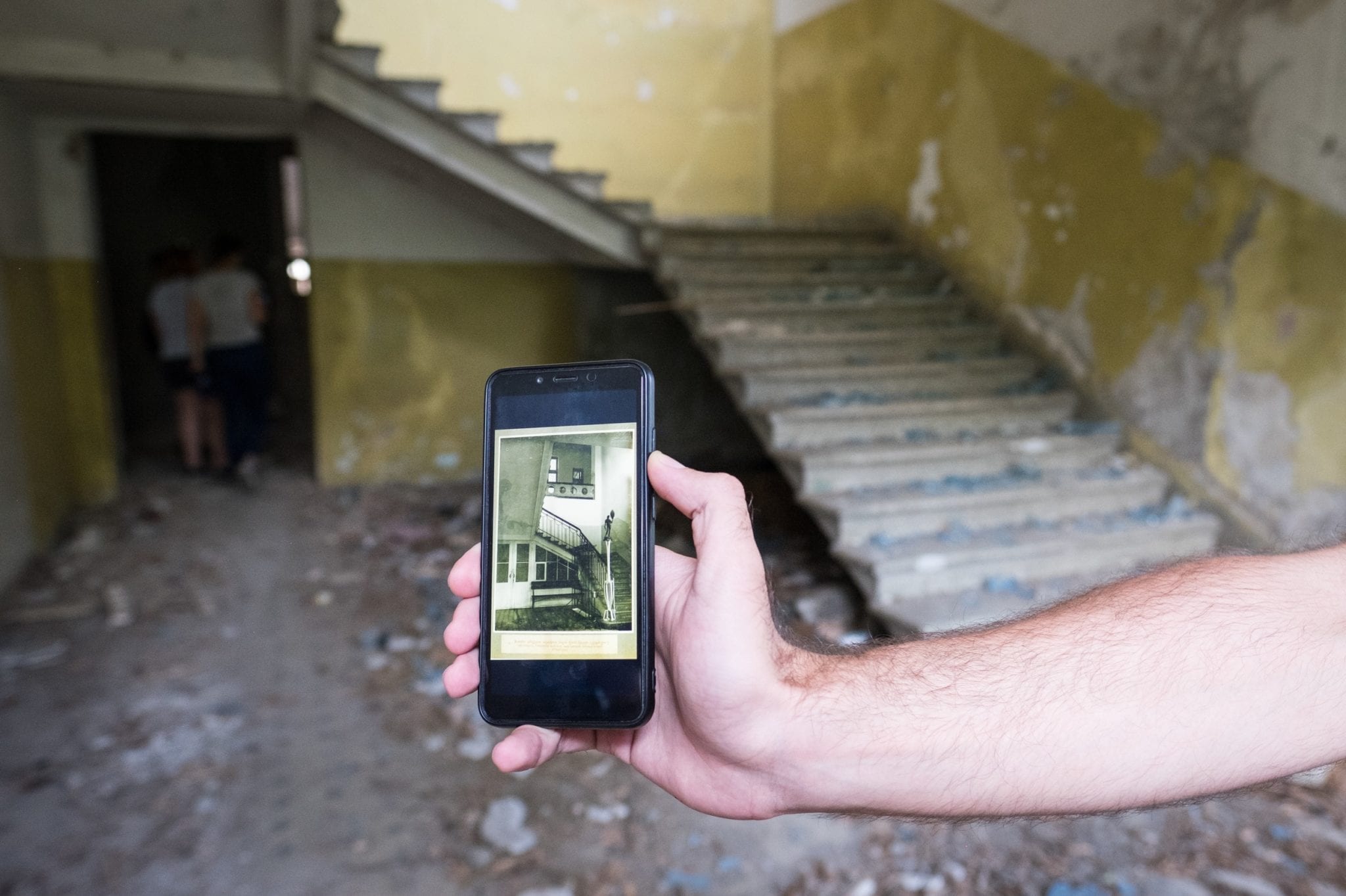
Travel Insurance for Georgia Travel
Travel insurance is absolutely necessary for travel to Georgia. It’s vital for any destination, but especially for Georgia, a developing country. While I love traveling to developing countries, it can be a huge pain dealing with a travel mishap in a developing country — and travel insurance protects you and your finances from ruin.
Georgia is filled with lots of uneven sidewalks and streets. You could easily trip or fall the wrong way and break an ankle or wrist. If that happens, it sucks — but it’s a lot worse if it happens and you don’t have travel insurance. The same thing if you get appendicitis and need to be hospitalized, or if your wallet is stolen when out in Tbilisi, or if you need to cancel your trip last minute due to a family emergency.
Get travel insurance — seriously. For trips to Georgia, I use and recommend World Nomads travel insurance.
READ MORE:
Top 10 Travel Safety Tips for Women
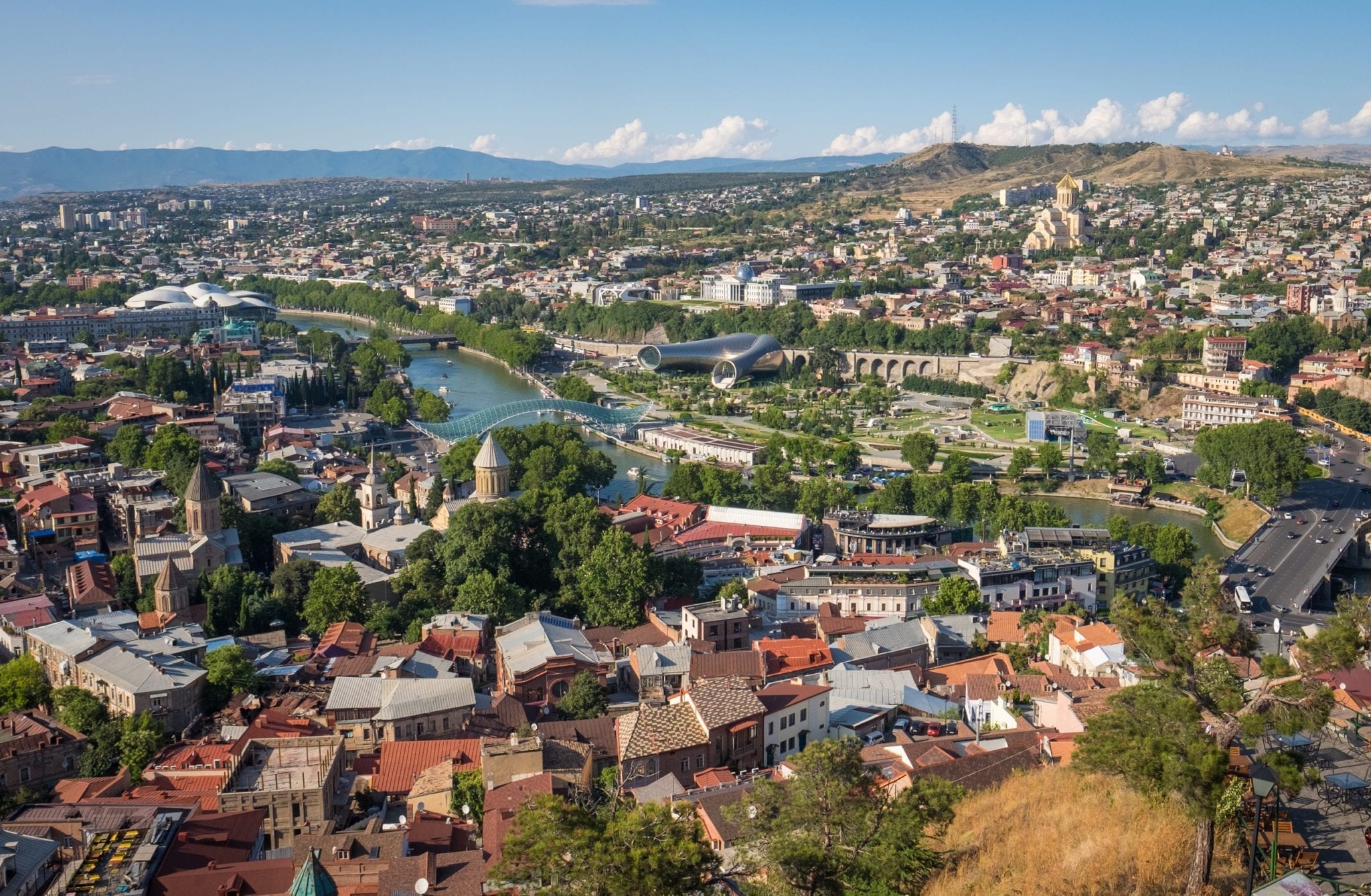
The Future of Tourism in Georgia
If you’ve read any of my blog posts in the past, you’ve heard me say, “Go now, because it’s really nice right now and won’t be like this forever.” That’s an argument I’ve made about Newfoundland, Guyana, and Puglia in Italy; an argument that sadly has come to fruition in the Faroe Islands and Little Corn Island, Nicaragua.
I feel the same way about Georgia — it’s on the verge of being discovered by mass tourism. Once that happens, it will change forever. The time to visit is now.
So what do I think will be happening in the future? For starters, I think soon we’ll begin to see high quality accommodation developed at all price tiers. Perhaps some high-end agriturismo-like farmstays in the wine regions. Tbilisi could use a luxury hostel.
Tourism in Tbilisi is interesting — most of the city is blissfully untouristed, but popular areas already feel overwhelming. Some streets are lined with restaurants where the employees try to get tourists to come in. Areas around the Peace Bridge, the cable car, and the hot springs are actually swarming with touts trying to sell boat tours and the like. Other cities have banned these guides from operating in public areas; I hope we see this happen in Tbilisi.
Speaking of Tbilisi, I think it’s going to be a major new digital nomad hub. Maybe not on the level of Chiang Mai or Medellín — but definitely up there.
I think there is HUGE potential for backpacker transportation companies in Georgia. You see them in Central America, South America, and Southeast Asia — companies that run journeys from backpacker hotspot to backpacker hotspot in comfortable, air-conditioned vans. Let me tell you, taking one of these on a six-hour drive from Lanquín to Flores in Guatemala was a million times better than taking four different chicken buses. Imagine that on a route from Ushguli to Mestia to Zugdidi to Kutaisi to Tbilisi!
I think we’re especially going to see more tourism from Central and Eastern Europe. Travelers from these countries don’t have as much money to spend, but between Georgia’s low costs and the cheap flights to Kutaisi, Georgia is an increasingly attractive option.
Overall, Georgia is going to become a powerhouse destination in the next decade. I recommend visiting before everyone else does.
READ NEXT:
Two Weeks in the Caucasus: A Georgia-Armenia-Azerbaijan Itinerary
Essential Info: This trip was organized by JayWay Travel, a custom private tour operator specializing in Central and Eastern Europe. JayWay plans bespoke trips and I highly recommend them, especially for making travel smoother sailing in developing countries like Georgia.
I recommend getting a Georgia guidebook because there isn’t a lot of information online in Georgia. Lonely Planet Georgia, Armenia and Azerbaijan is great. I recommend buying the digital version direct from Lonely Planet and keeping the PDF on your phone. (I love my Kindle but hate using the Kindle for guidebooks.)
In Tbilisi I stayed at Communal Sololaki, which I absolutely ADORED. It’s a modern design hotel with an outstanding breakfast and a communal ethos. Highly recommended, especially if you can get the bathtub suite.
On my return to Tbilisi I stayed at Boutique Hotel Khokhobi, in the dead center of the Tbilisi Baths district. The hotel was beautiful and comfortable with amazing balcony views, but I would only recommend it for night owls, as there was loud music playing at the surrounding bars until around 12:15 AM. The windows did not block out the noise. If you usually stay up past that time anyway, it’s a solid hotel choice.
In Kutaisi I stayed at two properties. Hotel Ponte was a good, comfortable mid-range hotel in a great location, but they didn’t handle the road construction situation well. Hotel Argo, a few streets away, was much more upscale and sumptuously comfortable with huge suites.
In Mestia I stayed at Chalet Mestia, which had phenomenally comfortable beds and pillows! Great location in the center of town. Poor internet, but that seems to be a Svaneti thing.
In Ushguli I stayed at Hotel Panorama, which had simple ensuite rooms and no internet. Considering the remoteness of Ushguli, it’s one of the best options in town. Nice dinner and breakfast.
Travel insurance is essential for travel to Georgia — it could save your life or your finances. I use and recommend World Nomads travel insurance.
Have you traveled to Georgia? Does it look like your kind of destination? Share away!
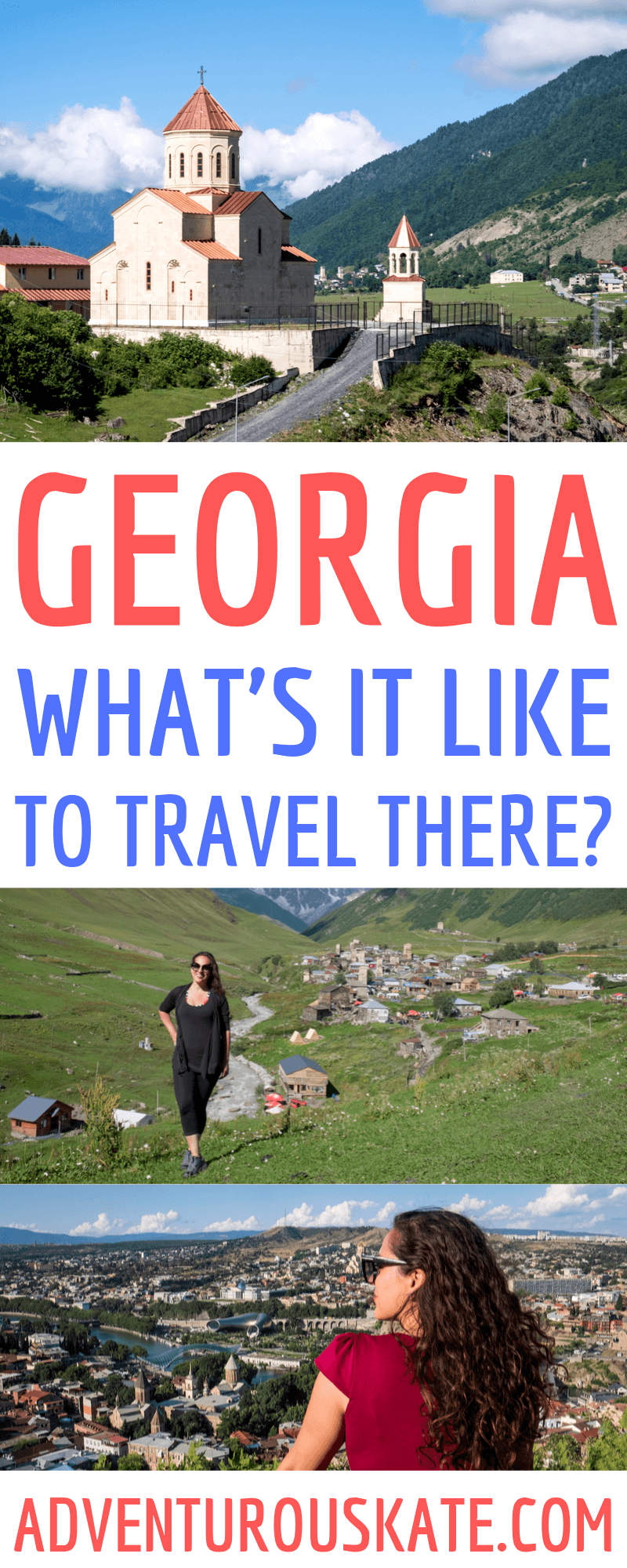
So happy you finally made it to Georgia, and that it was everything you dreamed! I spent 5 weeks there in 2015 and I still think about it all the time. Ushguli was one of my absolute favorites – I went on a whim for one night and wound up staying for 3. I just felt so at peace. As a solo female traveler, I generally felt very safe – I had one issue with a potential hiking guide creeping me out but that was it. Outside of Tbilisi, I stayed at homestays/guesthouses where Georgian moms and grandmas made delicious, cheap meals and took great care of me. The food, the wine, the mountains, the incredibly nice people… I’m overdue for a trip back!
Loved this post! I visited Georgia last year and it was just incredible – I didn’t have time to make it to Svaneti though, and after reading this I’m dying to go! 🙂
Hi Kate! I have never been to Georgia so far but I have already eyed the destination for quite a while! I really love traveling to places that are not on everybodies mind yet and it looks like Georgia would be exactly that! I visited Romania this year and I was totally suprised by it for example!
Loved reading about this! Moving Georgia up on my travel wishlist….
Have you tried any of the Georgian restaurants in NYC? Your descriptions of the food have me eager to try some!
Yes! Oda House in the East Village is great, but I wonder how it will compare now that I’ve actually been to Georgia!
Oh, cool! I’ll have to check it out. Thanks!
You definitely missed out quite a bit of Georgia, Kate 🙂 If you ever decide to go back there again you should visit Tusheti mountains (North-East), the Vardzia cave monastery (South), Borjomi-Kharagauli National Park and the Mountains of Adjara. I promise – you won’t be disappointed. I’d also suggest the Katskhi Pillar, Martvili and Okatse canyons.
I just went in October! I agree with almost everything you write 🙂
The food is amazing, the driving terrible and the mountains breathtaking. I just posted on my blog about hiking in Mestia and working on a post about Ushguli and the Shkara Glacier (Svaneti region). I think I would like to return there myself again for some more hiking and eggplant salad.
Cheers!
We are currently in Georgia and we went to Shavi Lomi tonight since you said it was the best meal you had in Georgia. It was so good I had to comment on this post as soon as I got back to the hotel. It definitely ranks in the top 5 meals I’ve had in my entire life. I had the chicken in walnut sauce as well as the loubio bean stew. Heaven. Heaven! Thanks for recommending that restaurant 🙂
That is so great to hear, Katrina! I’m so glad you enjoyed it. I love that place.
Loved your article about Georgia! We (family of 6) spent a week there in summer 2018 visiting friends who live in Dedoplis Tskaro. We stayed in Tbilisi and Sighnaghi. I actually drove all over the country, from Tbilisi to Sighnaghi and up to Kazbegi. I thought it was a better experience than driving in southern Italy (I used to live in Sicily). It is challenging. I rented a nice SUV. They brought it to my hotel (the very nice Courtyard Marriott). No problems except, SURPRISE, I had to pay in advance, IN CASH–about $700. Little things like that can throw you in a new place. Interestingly, I was pulled over for making an illegal left turn on a highway in the eastern part of the country. The police officer was very professional and courteous and spoke passable English. He seemed offended when I asked if I could pay the $25 fine directly to him. He gave us a very good impression of his country, as did so many others. We were actually a bit nervous to be traveling to Georgia with the kids (aged 12-19), but it was a marvelous experience without any real concerns. Everyone still talks about it–the monasteries, the language, dry bridge market, the mountains, the friendships… and that amazing Georgian food!